
Blog 40 by Mick: Whatever Floats Your Bike
Back in Arusha we had a few little jobs to do before hitting the road, and I’m not just talking of the ever present bike maintenance. We had to decide where to go. We had about 2 weeks available to us to get to Nairobi where Tanya had booked her next exam for her BComm, but the problem was it was only 270km away. Looking at the map we figured we could get to Nairobi taking the scenic route around Lake Victoria through Rwanda and Uganda. It was 10 times the direct distance at 2700km, but what the hell; looking around was what we are here for.
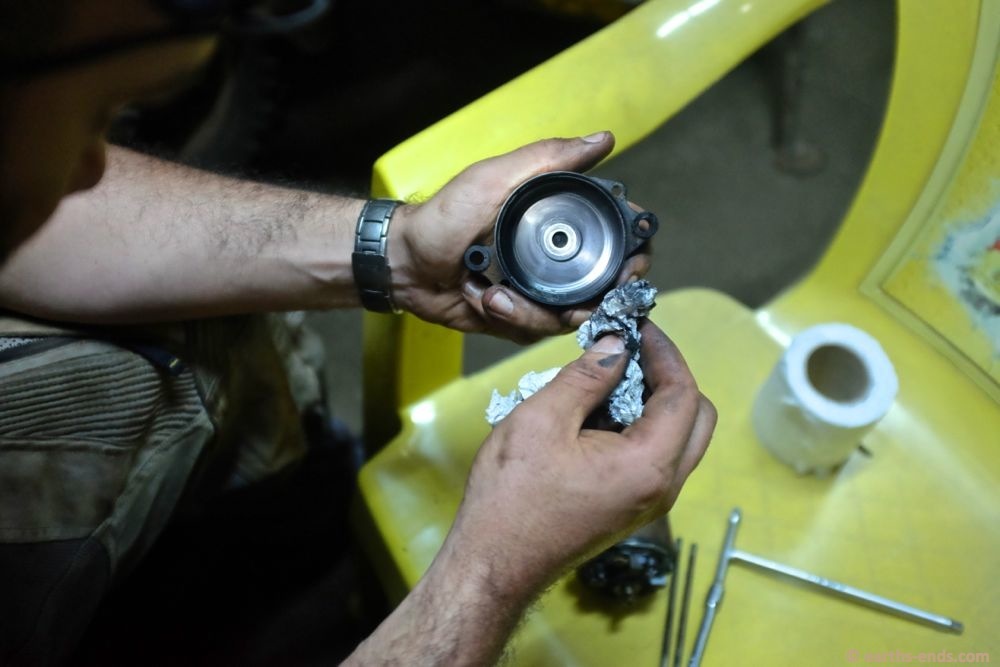
Tanya’s starter motor had been binding up for some time with carbon from the brushes and it needed a bit of a clean out. I also noticed that the bearing in the Warp 9 end cap was quite notchy so popped the seal off and greased it. I’d definitely recommend anyone who gets one of these new to do this, it was very dry in there and spun much better with some grease.
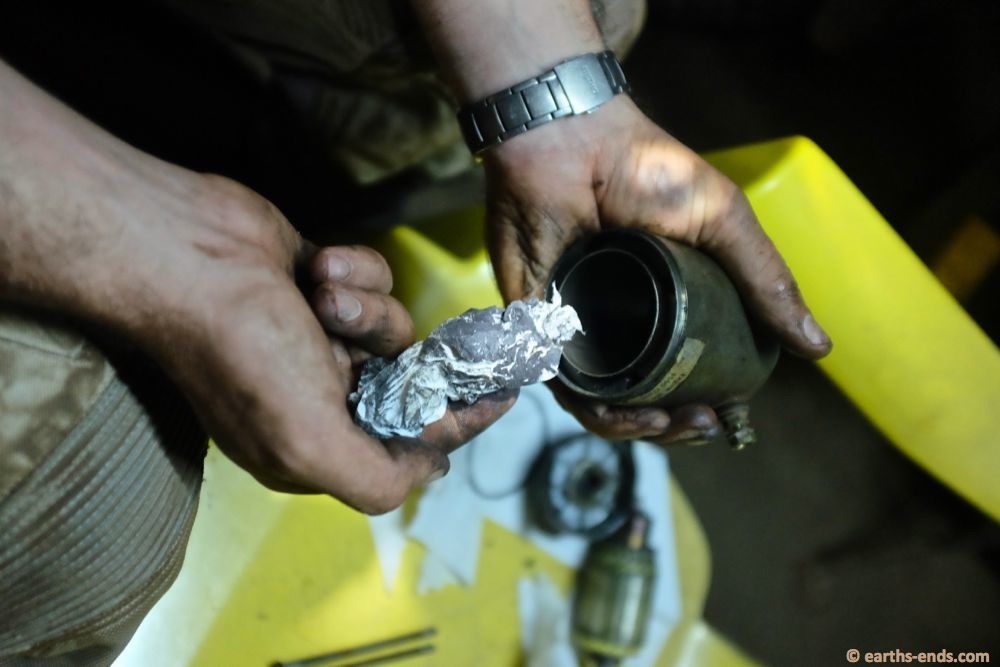
Carbon binding up the commutator

Cleaning the starter and re-seating the brushes before reassembly. We’ve put 15000kms on the bike since this quick bit of maintenance and its started perfectly ever since.
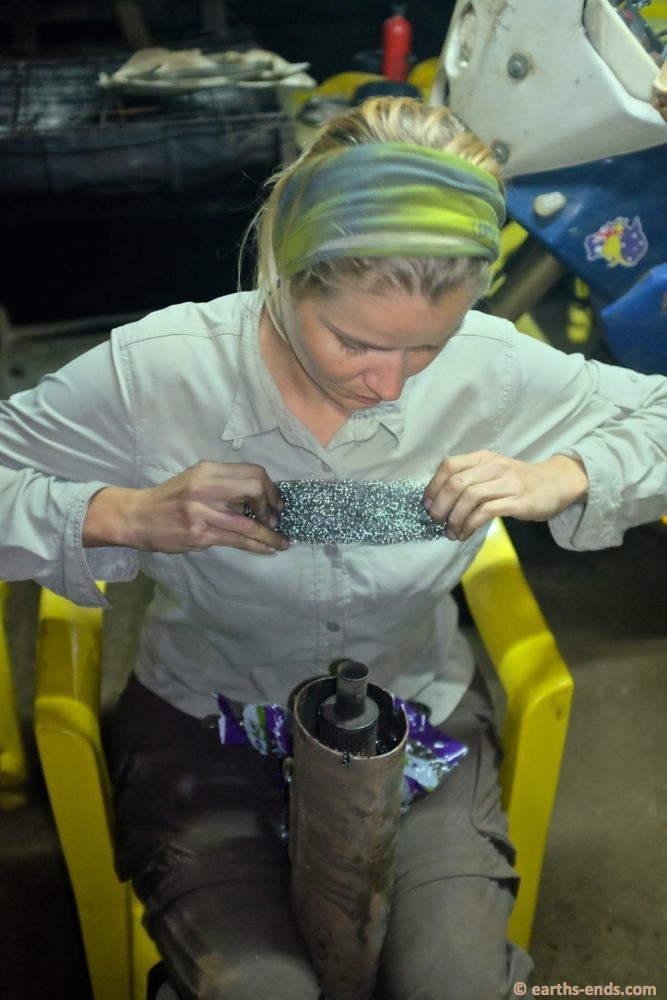
While we were at it, Tan repacked the exhausts. The last time we did this was about 23000kms ago in Stellenbosch, South Africa.
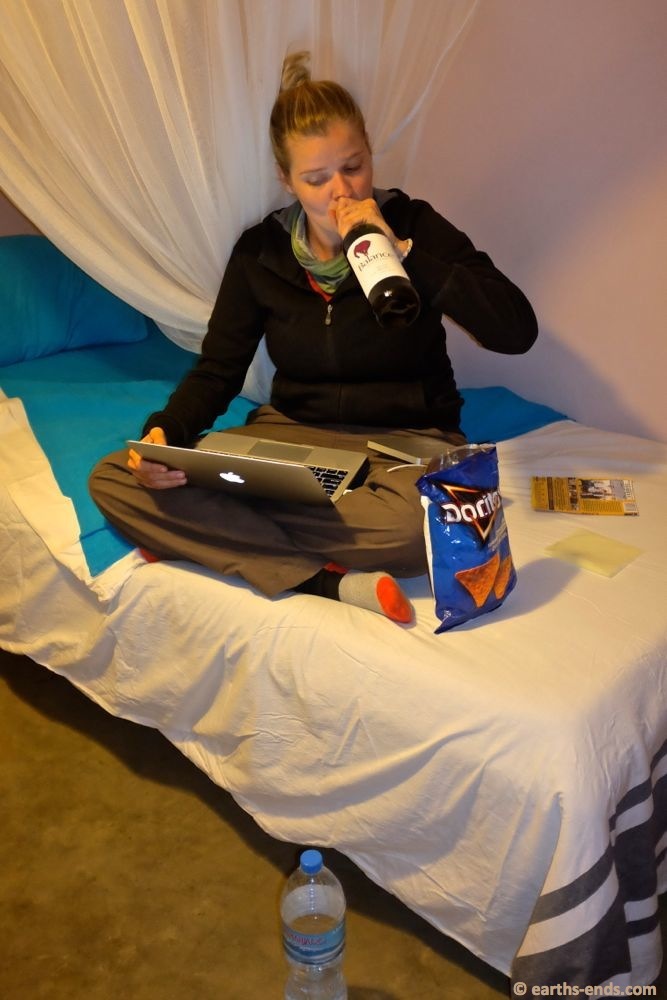
Movie night with wine and nibblies…. Busted arse RTW biker style

Some handy parking for brunch at a local restaurant
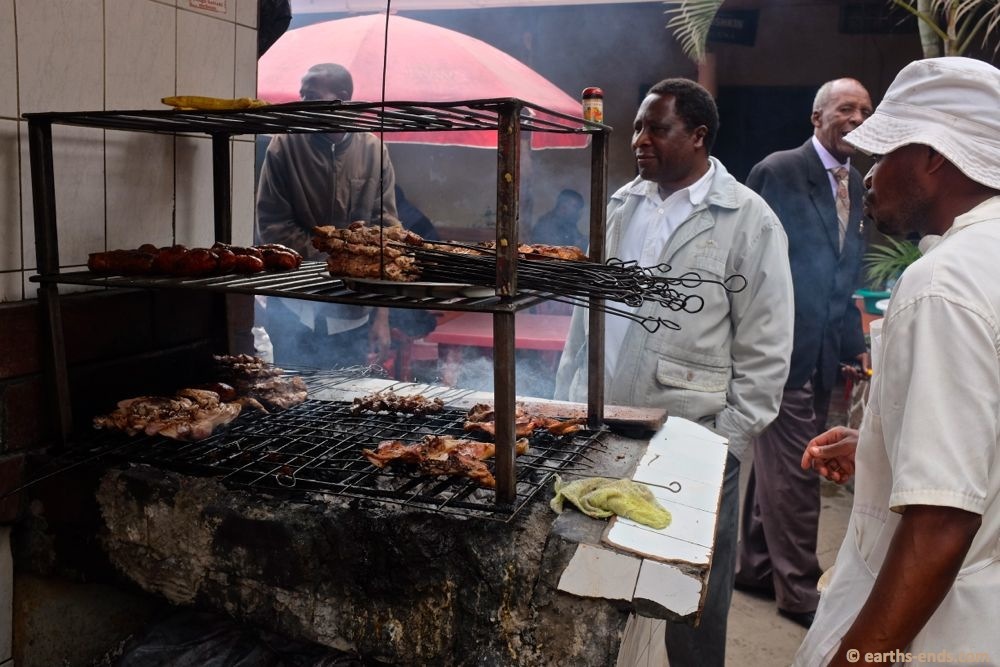
The ubiquitous bbq. Every little restaurant in this part of the world has one of these with some goat or chicken roasting away. This place did home made sausage which was really pretty good. We wisely never asked what was in it!
First stop wasn’t far away, just 160km west in the town of Karatu where we had been invited to drop in on a fellow advrider inmate. William worked at an American run private hospital providing first world medical care to the community at heavily subsidised rates. And it was a real impressive little show. Construction only started in 2008 and in the seven years since they have grown to the point they can provide all sorts of specialised services.
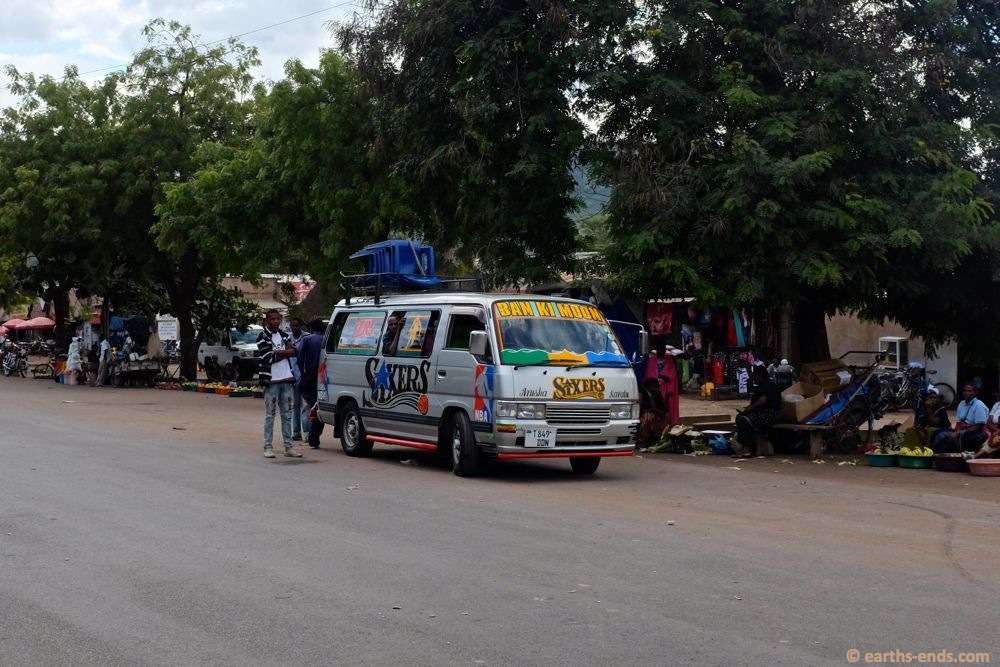
Every matatu/communal taxi has some sort of silly stickers on it. This one was unique though, the driver was obviously a fan of the South Korean UN Secretary General Ban Ki Moon.
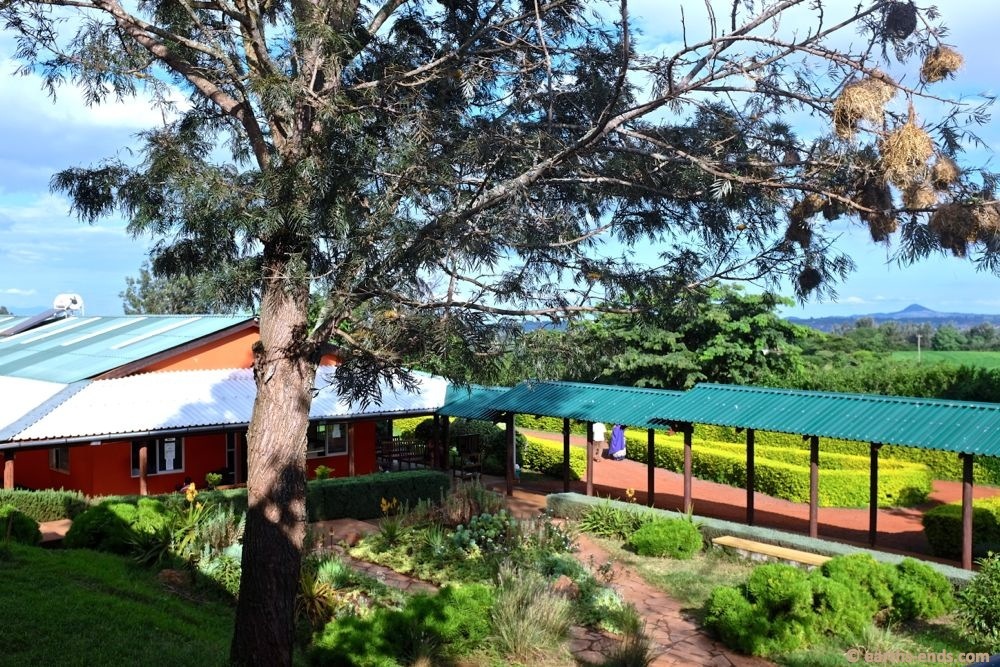
The grounds of the FAME (Foundation for African Medicane and Education) hospital (www.fameafrica.org). If you get sick or need medical attention in or around Karatu, I recommend you go here. It was an impressive little hospital.
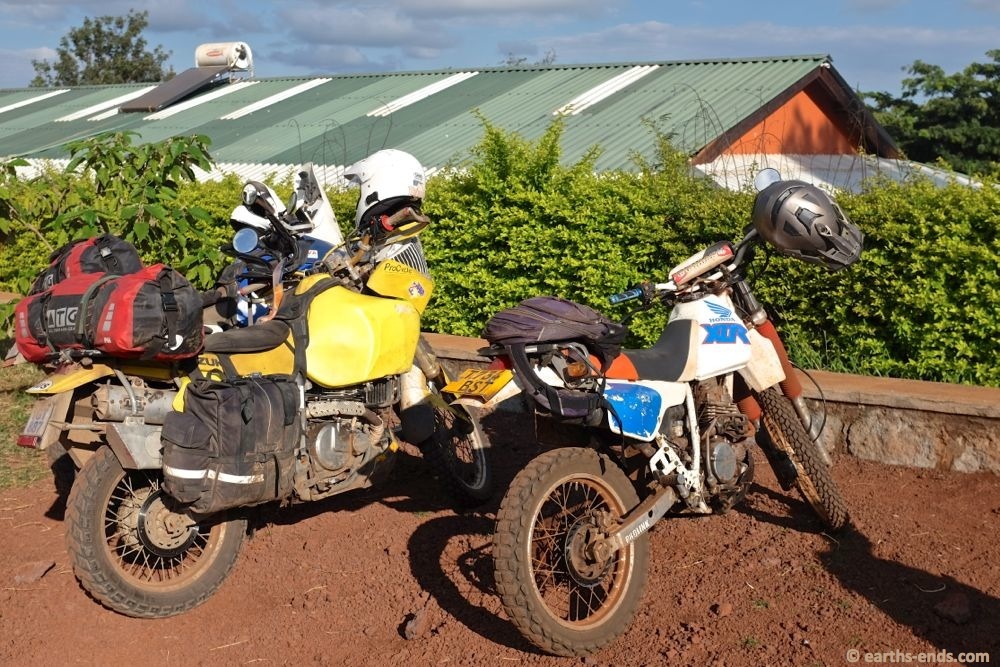
William’s little XR250 next to our big behemoths
William offered us his spare room for the night which we gratefully accepted as the sun was starting to get a bit low on the horizon. Over dinner we got talking about our route west to Rwanda and William mentioned there were 3 ways we could go; the tar, which we were avoiding where possible due to the insane buses; a main dirt road, which was shorter and what I had planned on taking; or a very interesting little route where at one stage there was no roads and we would be forced to cross a river in a canoe.

Discussing routes with William. Tan was like “act natural!”… err what?
Yep, you are probably right now just like I was when I heard that 3rd option. “Peaked my interest” is an understatement…. Put the bikes in a canoe…. That sounds rather interesting indeed. When William mentioned that we would be riding alongside Lake Eyasi which is the territory of the very rare Hadza hunter gather tribe or the Datoga pastoralist tribe, it was too much. “William! You had me at ‘canoe’! You had me at ‘canoe’!!!”
I hate Tom Cruise movies by the way, but the Jerry Maguire reference seemed fitting.
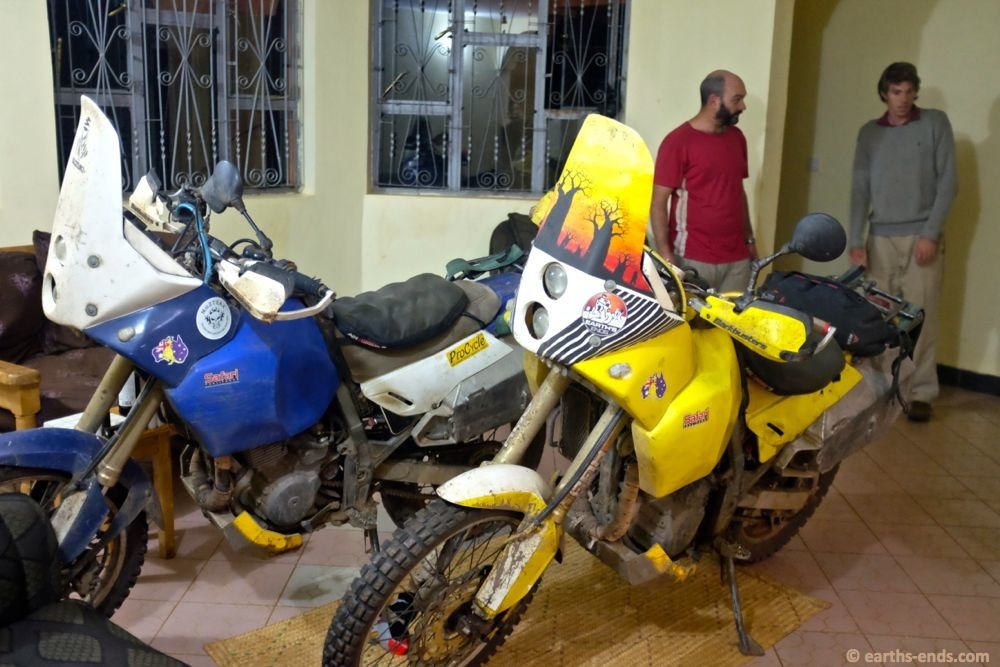
We parked our bikes in William’s living room for the night.
So we got away relatively (for us) early the next morning, about 9am. William had provided us with a list of village names to ask for as we made our way south, the co-ords of the canoe crossing, and the approximate location of a “tourist gate” we had to get through before they closed it for the morning. Turns out that a number of years ago the Tanzanian Government suggested that local tribal groups could charge tourists a fee to visit tourist attractions on tribal land. Sounds fair right? Yeah I think so too, but…. well, the trouble is those groups have interpreted the law to mean they can put gates over public roads and charge non-Africans (doesn’t matter if you’re a resident) a fee to use the road. Doesn’t matter if you’re using the road to access attractions (like a tourist) or just as a thoroughfare to get somewhere else (like us), you pay if you are not African. So basically it is a racial toll-gate, and an expensive one at that. Most are USD15 per (white) person!
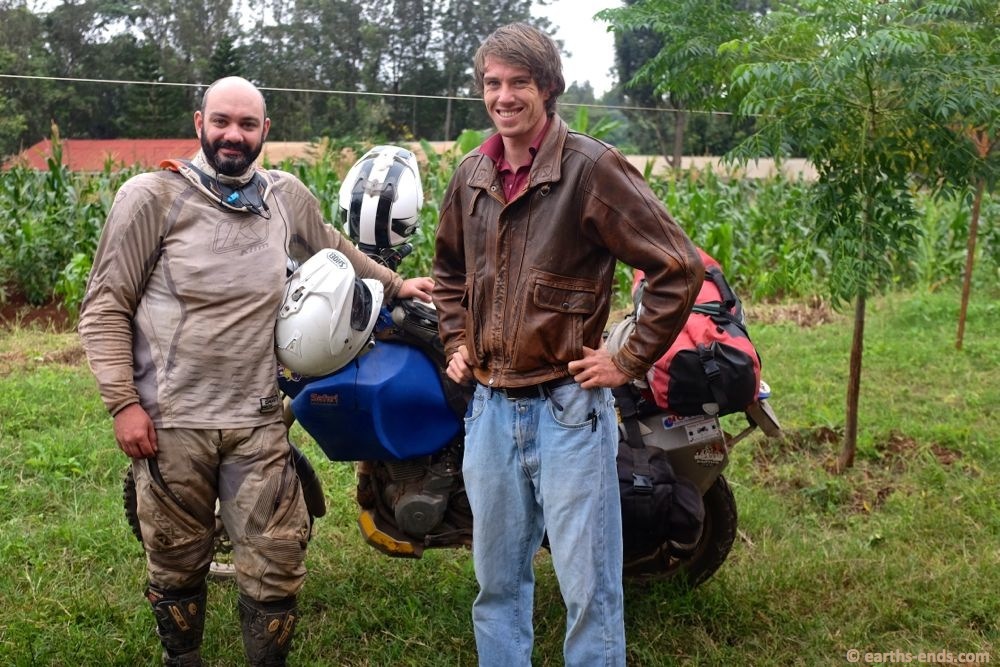
Saying good bye the next morning. Thanks for the invite William!
We would be going through one such gate on our way south and William suggested that that we should get through it before 10am, about when it closes. Apparently during ‘peak-hour’ when there is lots of local traffic, the gates are annoying so they are left open, but they are closed mid-morning when the traffic slows and the tourists (might) start turning up. So we timed our arrival for a bit before 10, and made sure we rode through side by side so there would be no first rider to alert the gate attendants and a second rider to cop the fee. Plan was for us to both slip through before they realised.

Just past the tourist gate we stopped to grab a snack and a photo
And so it turned out. We saw the gate house but zipped through and off into the figurative sunset before anyone spotted us. I’m not even sure if the gate house was actually manned at the time to be honest. We saw no one. Anyway, we immediately turned south and off the last of the marked routes on my Tracks4Africa GPS maps to head around the bottom side of Lake Eyasi. We were now navigating on a dead reckoning to the canoe crossing co-ords and following a list a village names. If we were lucky we would meet a few Hadza or Datogo people along the way. It had the makings of a bloody good day.

About 15km past the tourist gate the road quickly deteriorated… Lots of erosion damage and some sand to spice things up.

PHOTO STOLEN FROM THE NET. The Datoga who live in the area are known for their women who wear elaborate flat and wide copper looking necklaces. We saw two women like this; one quite close while we stopped for a warm coke in Bukundi. Once again, she was quite reserved and we missed our photo opportunity. But we were lucky to witness them none the less. We were also hoping to meet some people from the hunter gatherer Hadza tribe that lives along the lake side. We did get to see what we think were some of these people from a distance but they were very shy and reserved and difficult to approach. They wore shorts with knee and sometimes elbow jewelry. I’ve struggled to find a decent photo online of what we saw so a description will have to do!
It wasn’t far until the road deteriorated. Significantly. Many moons ago some adventurous civil construction types had come out here and built what probably was a pretty decent dirt road. Just one small problem. Drainage. It would seem that drainage wasn’t really considered, at all, and now the road was cut every 300 metres or so with erosion ditches were seasonal streams coming from the mountains had cut through the road foundations as they drained into Lake Eyasi. At some points the road was gone completely and what was left was unridable, forcing us to bush bash around the eroded mess and meet up again with what road the flowing water had generously left behind. There was about 70-80km of this stop start riding which took us over 2 hours to complete.

Some of the erosion damage to the road. Some of it was fine, some of it was a headache
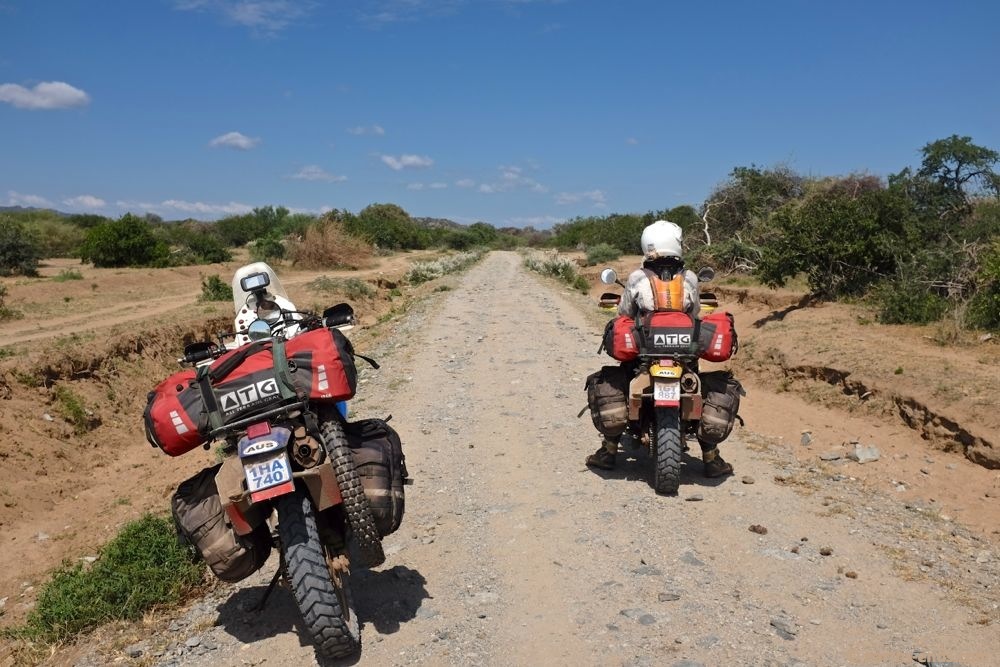
Heading south on a good section of old road. We would get 300m of this, then slow down for an erosion gully. Then repeat. For 70km.
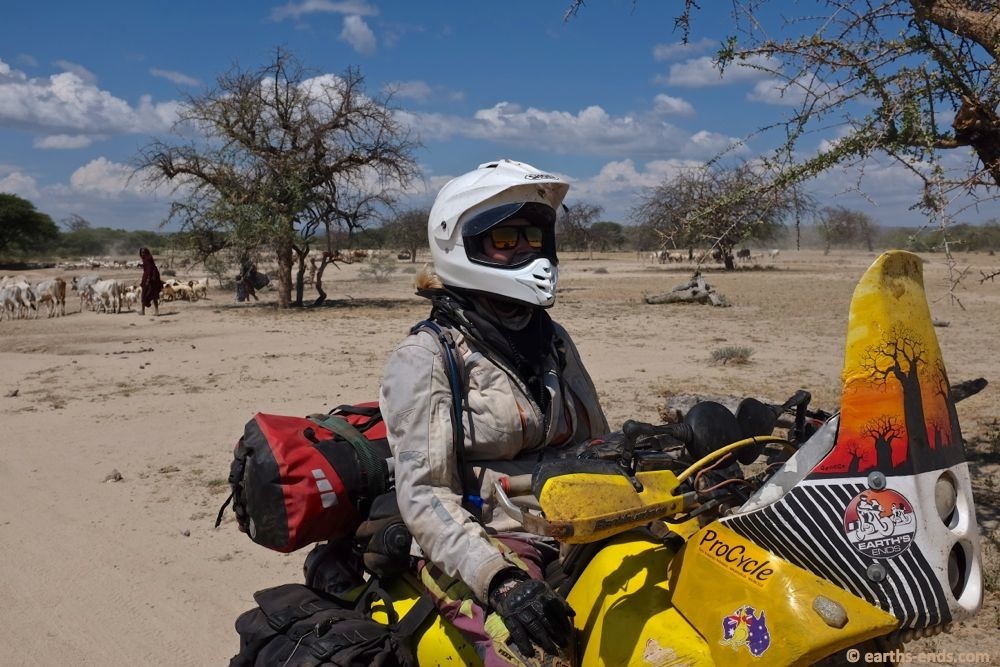
A quick break with some Datoga pastoralists in the background
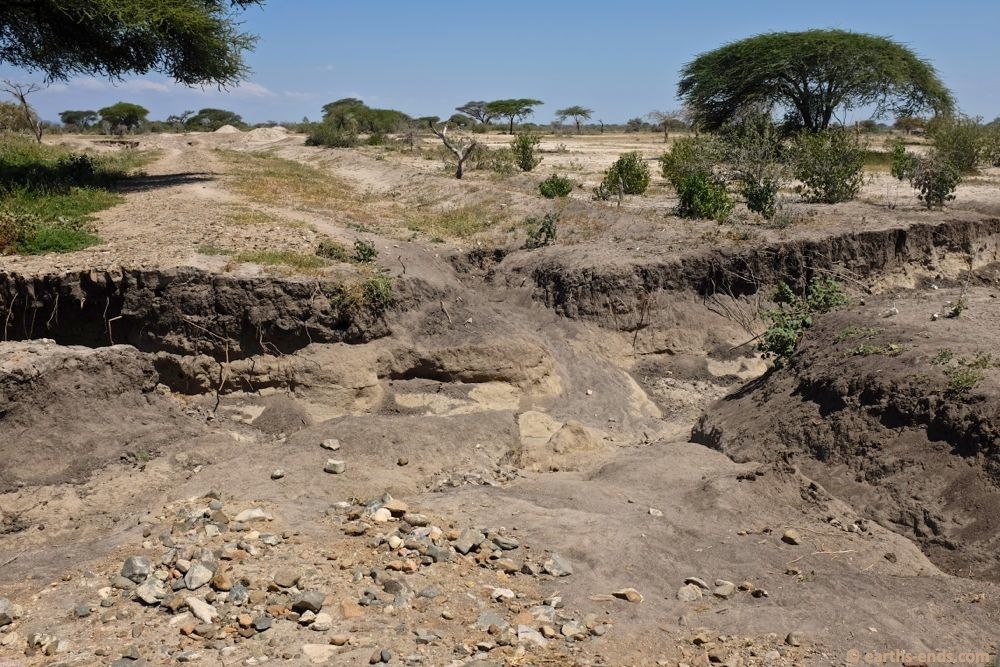
One of the more significant erosion gullies. There were a handful about this bad.
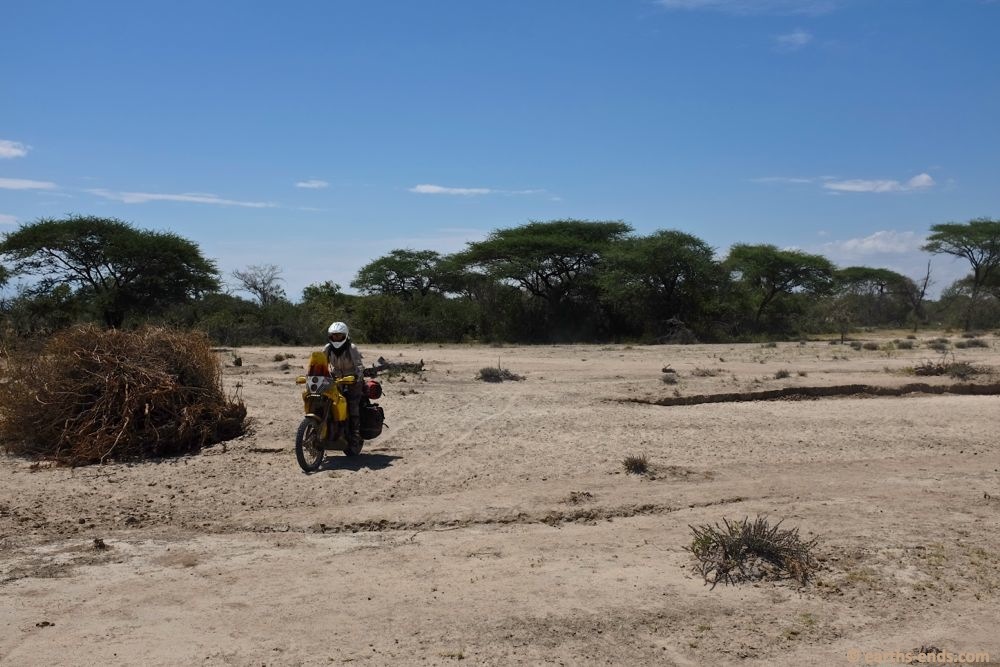
We bush-bashed around this one, thankfully avoiding flats

Yet more significant flooding damage. You’d struggle to get a car down this road.
We reached the last village that William had given us a name for on the eastern side of the river. Following the bearing on the gps towards the river crossing, the road disappeared and we were on nothing but piki-piki trails; Piki-piki being the Swahili word for motorcycle and used in these parts in reference to cheap, small capacity (between 80-150cc) Indian and Chinese bikes. They are everywhere in Africa, even in the remotest little village far from a service station.
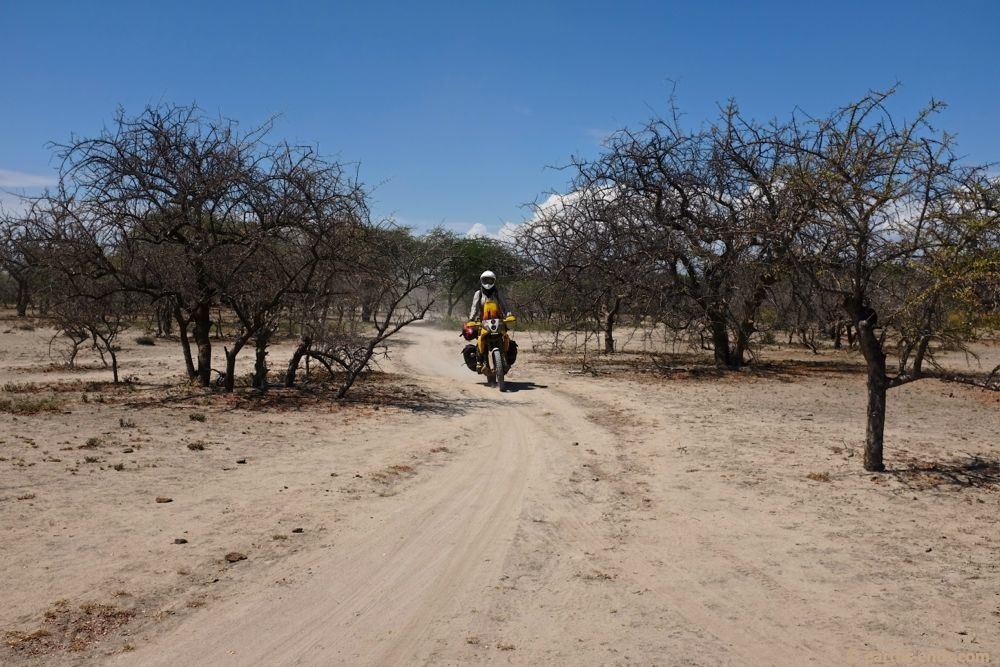
Tan on the piki-piki trails…. Its obvious I had the camera this day, every photo is of Tan…
One issue with them being everywhere is finding the right trail to get to the river crossing. We followed our noses and ended up on a trail heading too far south, so back tracked and found another trail on a more westerly bearing and got on that instead. We picked a winner and after some smooth single track through acacia thicket, we arrived at the river and were greeted with some amused and perplexed looks from the ferrymen.

Riding through the acacia. No roads out here.
While discussing the route with Wiliam, I had quizzed him as to the river’s width/depth/current conditions to ascertain whether it might be possible to ford the river. But now I could see why he wasn’t confident, and why the canoe ferries existed. While the river was not wide, maybe only 20m, it was deep. And worse still, the soil in the region was a very fine loamy clay meaning that the river bed was endlessly deep sticky mud. Even if the river was 20cm deep you wouldn’t get across without a winch to drag you through. It would have to be basically bone dry to ever ford.
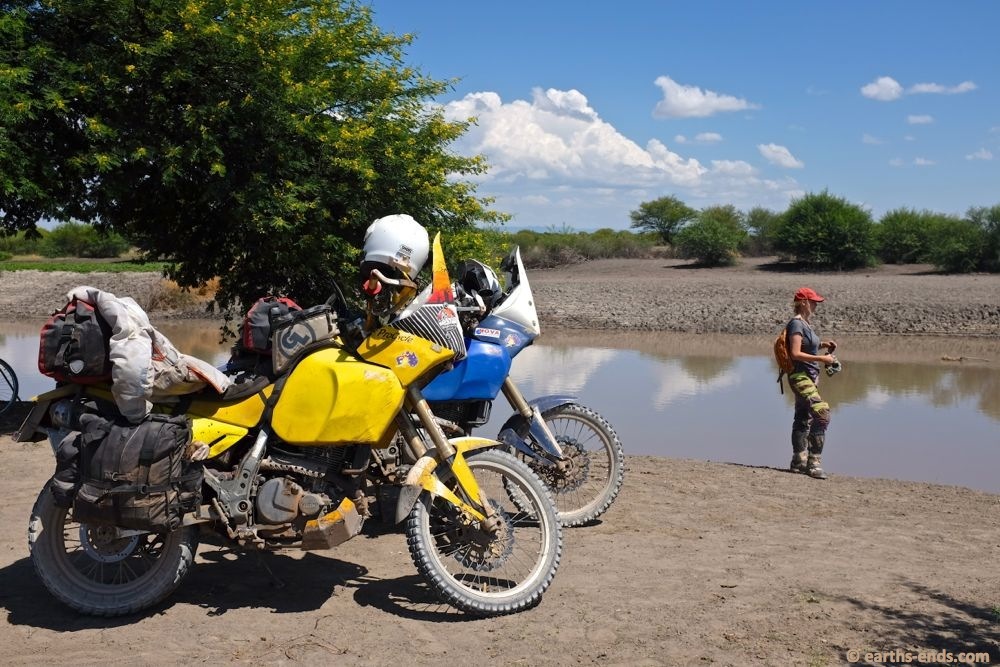
Contemplating our immediate future at the river. To cross, or not to cross? That is the question.
So the canoe was the only option across. That, or turn around and head south-west for the tar road. To be fair we were quite apprehensive to begin with. The canoes were dug-out palms with an open end dammed with a low mud wall to stop the water flooding in, and didn’t look too stable at all with their round bottoms and sitting so high in the water. And when William had done this route, he had done it on his little XR250. So we sat and waited with some snacks until two local piki-pikis came along, and watched how they went. It was a pretty slick and well practiced operation with two pikis in one canoe and their owners in another. Having seen that crossing, we thought it was doable.
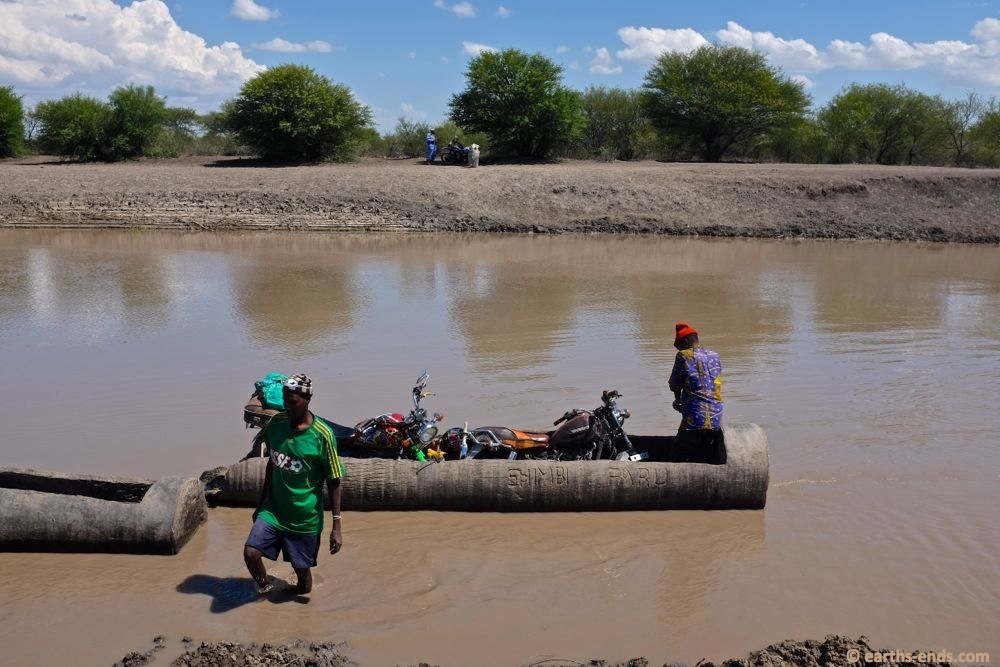
The two piki-pikis in the canoe. Looked doable… In fact it looked pretty good!
When the ferrymen returned to our side of the river, we used a bit of sign language to see if they thought they could get our bike across. They seemed positive, smiling and giving us the thumbs up while pointing at the dug-outs. Luckily, a masaai guy turned up who spoke quite good English and he helped us negotiate a rate across. William had advised he had paid 10,000 shillings for his bike and luggage, so when we got down to 12,500 shillings I figured that was fair enough considering our DR’s were a fair bit bigger and would require a lot more muscle. And they had started at a rate more that double that!
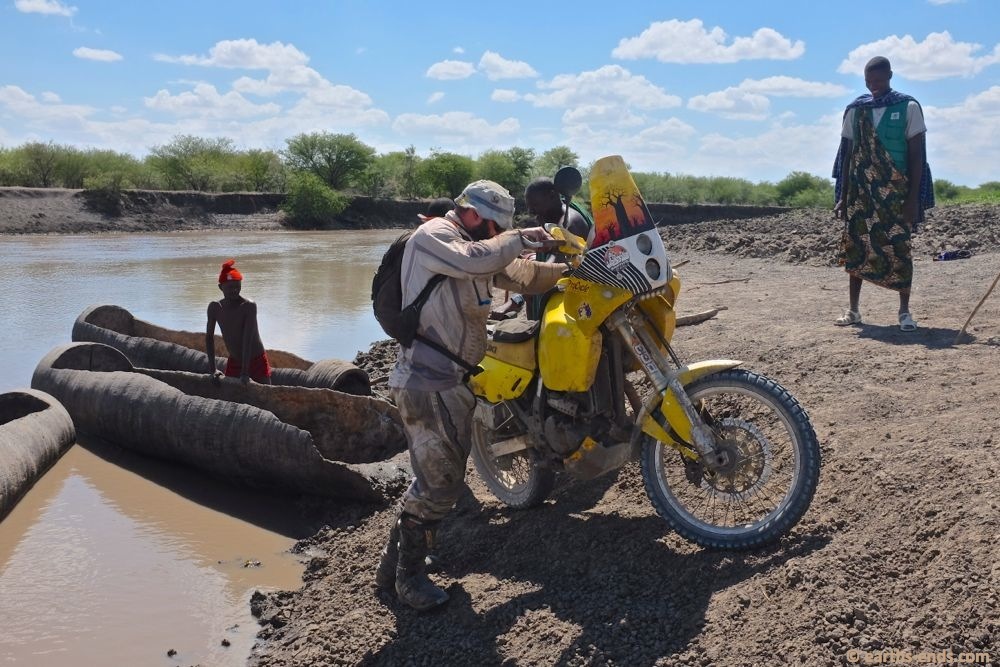
Backing Tan’s bike in. The bike moving dug-out had an open end with a dam made of pretty dry mud to stop the water flooding it. We backed the bike over the dam, then the ferry man patched it up with some fresh mud before we set off. Seemed legit, what could go wrong?

It was a massive group effort to get the bikes down the bank and into the dug-out canoe. The maassai fella who translated for us is on the right. He was a bit of a character, when we asked why he had crossed the river he replied “I have come to drink some LIQUER!!”
Tan’s bike went first. Its 1” lower than mine and the rear fuel tank was empty at the time, so it seemed like the better guinea pig. Plus it wasn’t mine. We backed the bike over the mud dam and into the canoe and loaded the luggage with me into another. When the ferryman pushed off and the canoe sat down in the river, we were relieved to see it looked pretty stable. It was leaning a bit with the bike but these guys knew what they were doing. This was going to work.
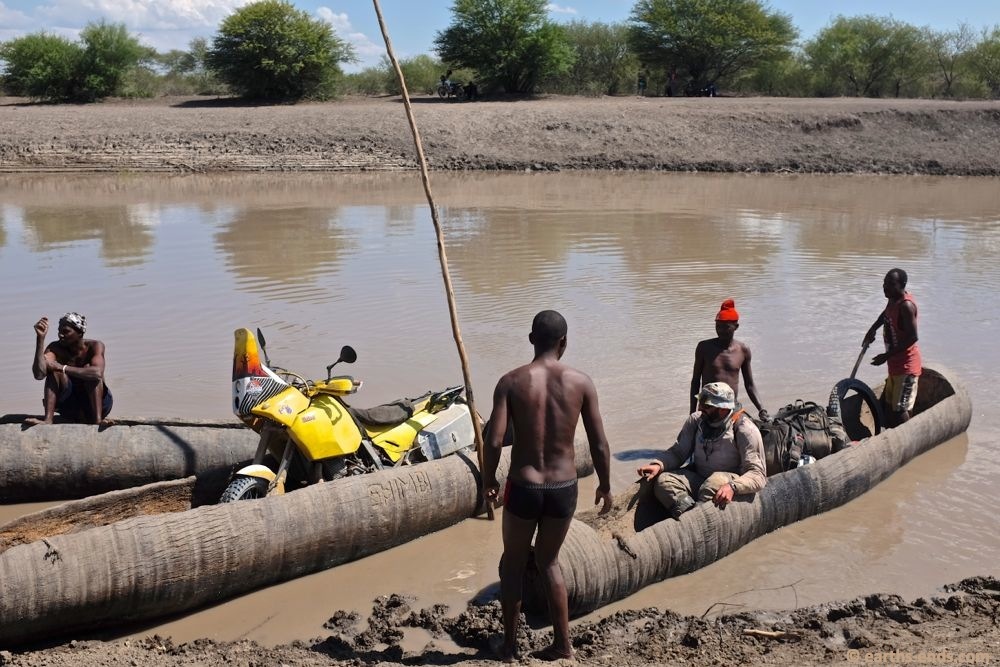
Tan’s bike about to set off, and me in the second canoe with luggage. Looking good so far.
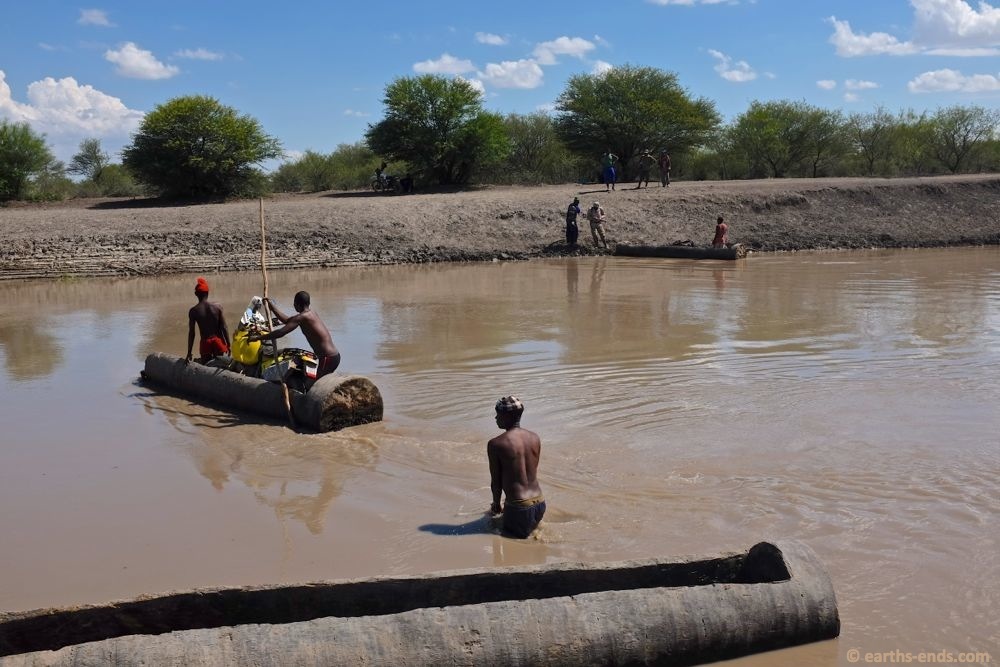
You can see the canoe with the bike had a bit of a lean on it, but it was stable enough.
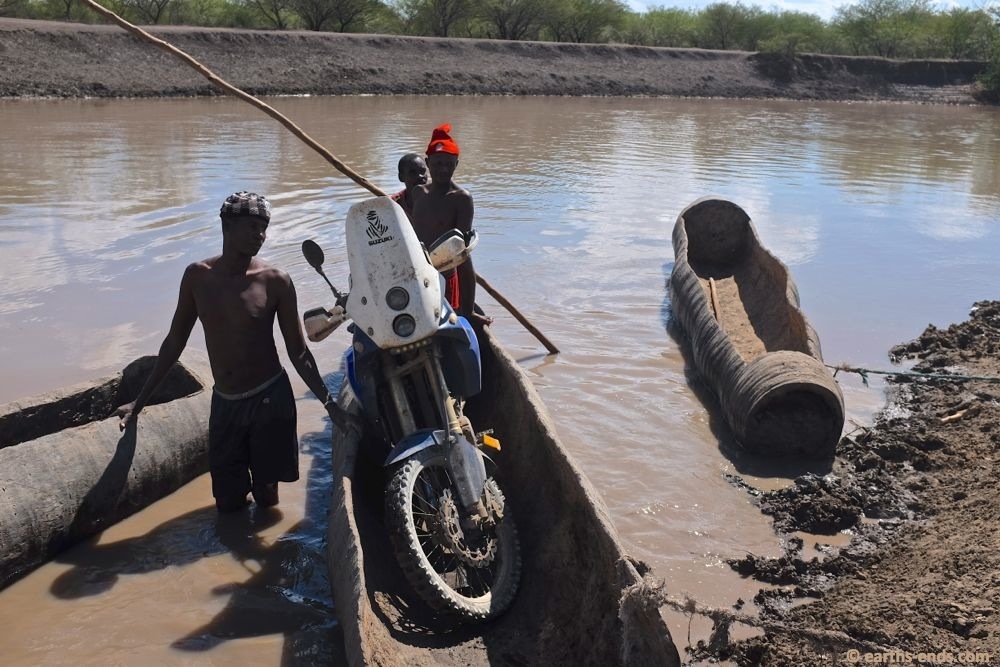
My bike in. The canoes were pretty narrow, I think you’d struggle to fit a beemer boxer twin in there.
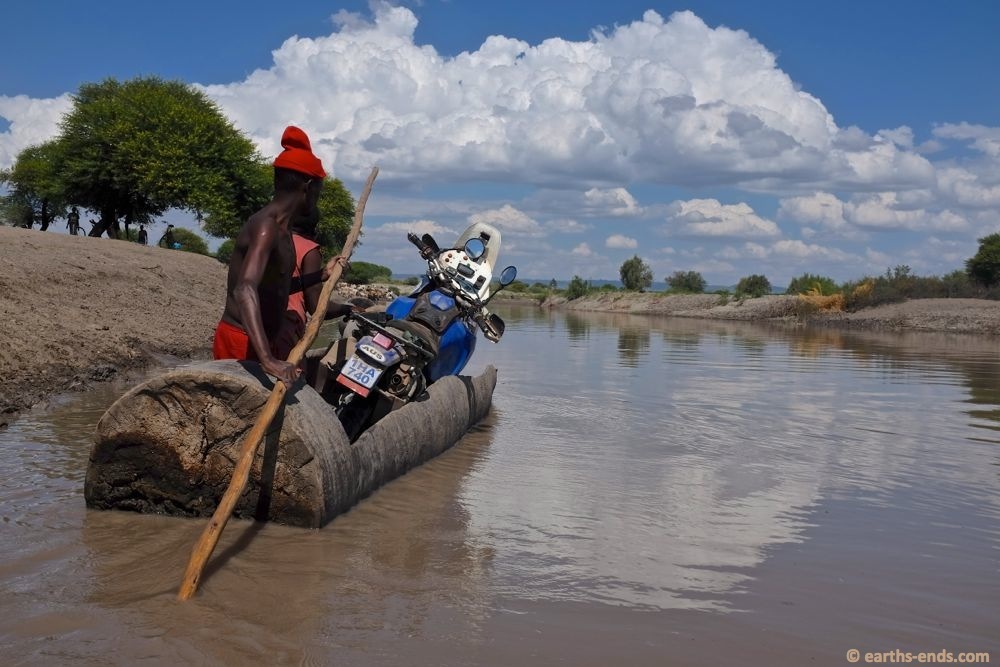
View from the dugout…
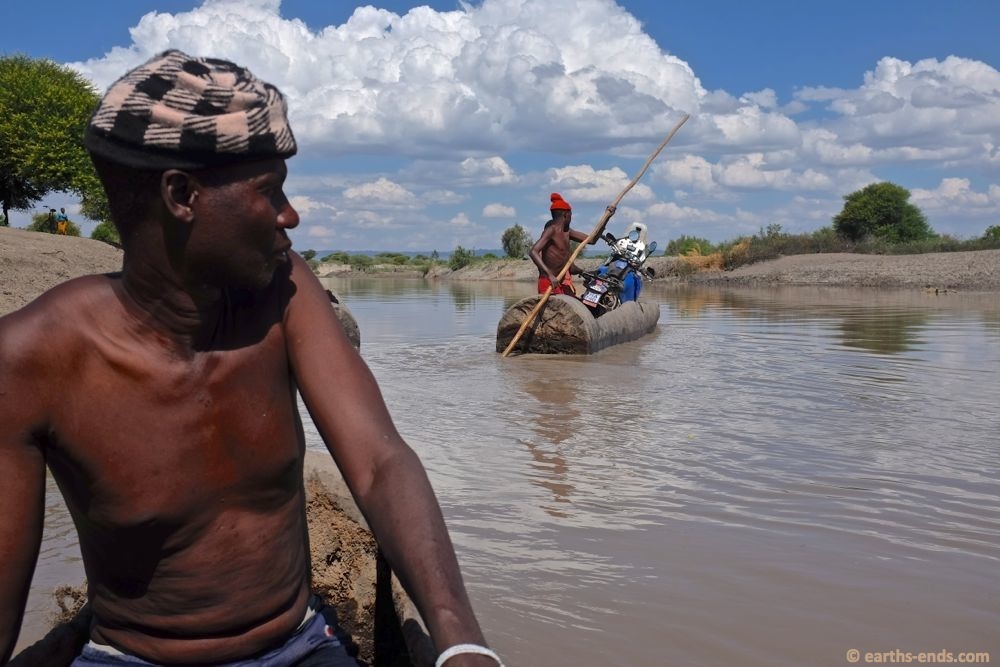
Piece of cake… sort of… ok…. This really was a bit heart in mouth…
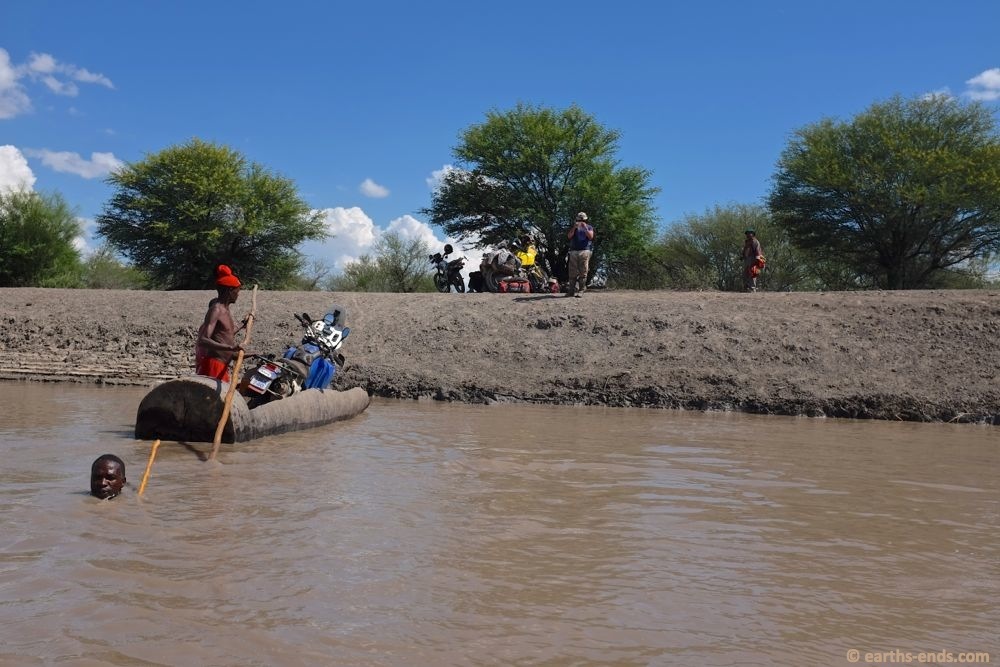
Did we mention it was deep?
Getting the bikes out at the other side was an effort. The canoe could only push onto the bank so far, meaning that the bike when it came out the end of the canoe sank into the last of the soft sticky mud. It was massive group effort to push it through. My bike came next with Tan supervising the guys as they loaded the bike and me looking on nervously from the opposite bank. Everything worked really very well in the end and the guys were stoked when we gave them a small tip (we paid once we got to the other side, just like the song says), I hadn’t planned on it and its not expected in a place like Tanzania, but everyone was sweating and huffing and puffing after unloading the bikes and luggage it seemed only fair.

Getting the bikes out was a mission.
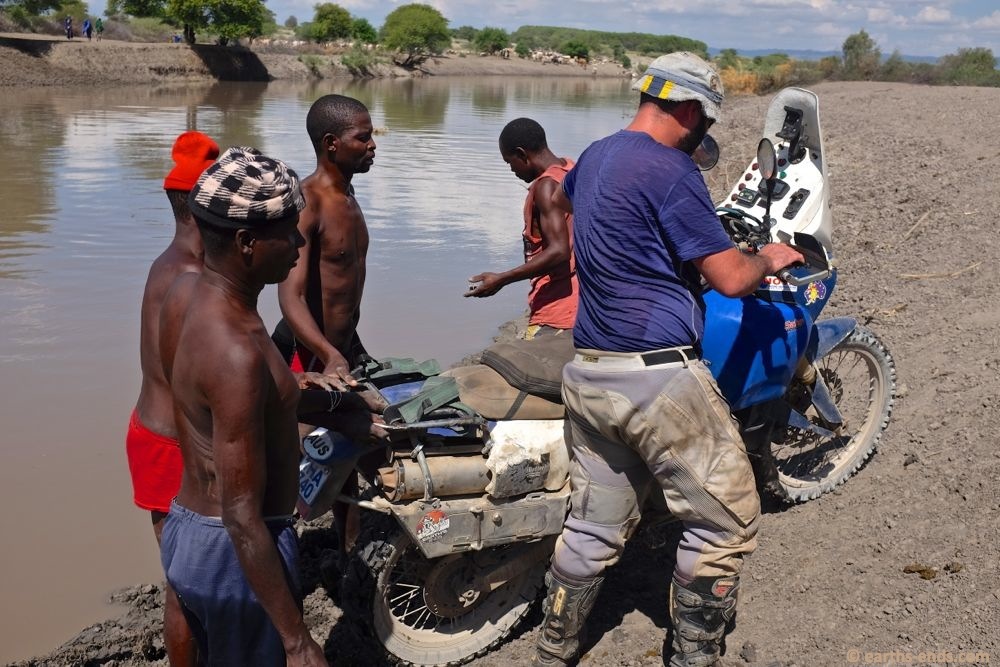
Between unloading all the luggage and then two bikes, I had a bit of a sweat on.
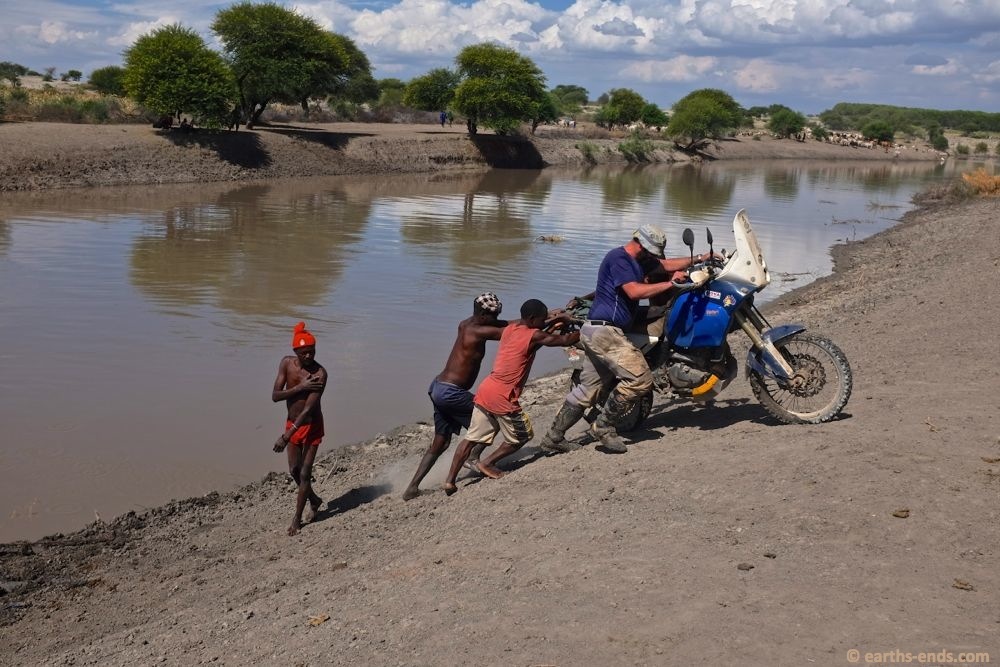
It was steeper than it looked! Promise!
After a rest in the shade we pushed on to the next village of Bukundi for a warm coke. From there the adventure subsided a whisker as we were back on proper dirt roads, however our pace picked up and we headed north-west. At the village of Laloga we found a clean little guest house for USD2 and with the sun about 30minutes from setting, it seemed like a good place to stop.

Obama is a popular bloke. At least out of the states anyway.
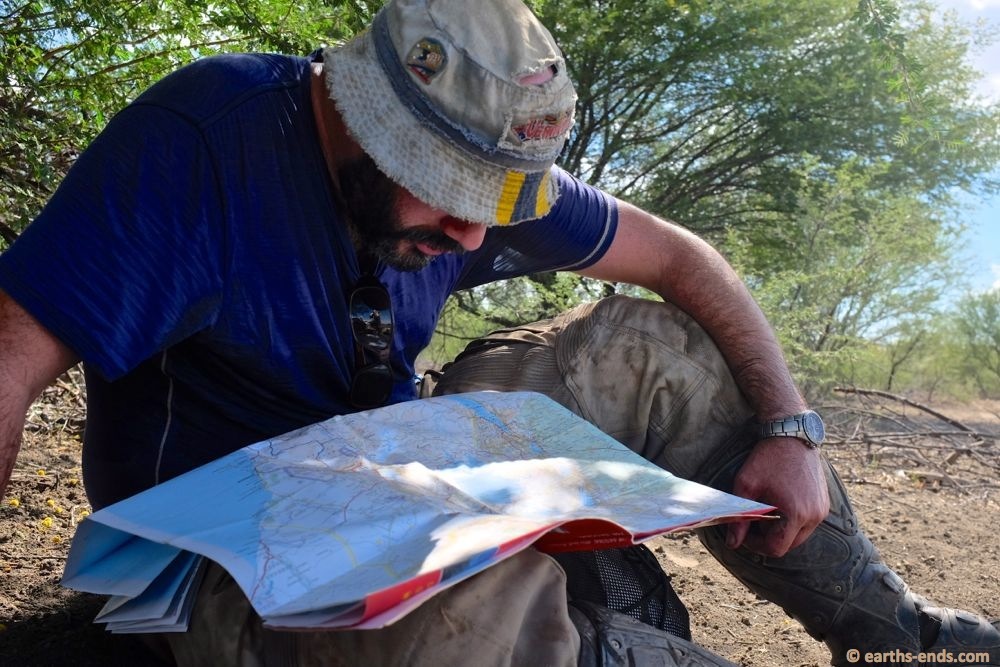
Ok, we are over the river. Now where?

After a bit of a rest and repacking the bikes we were ready to go.
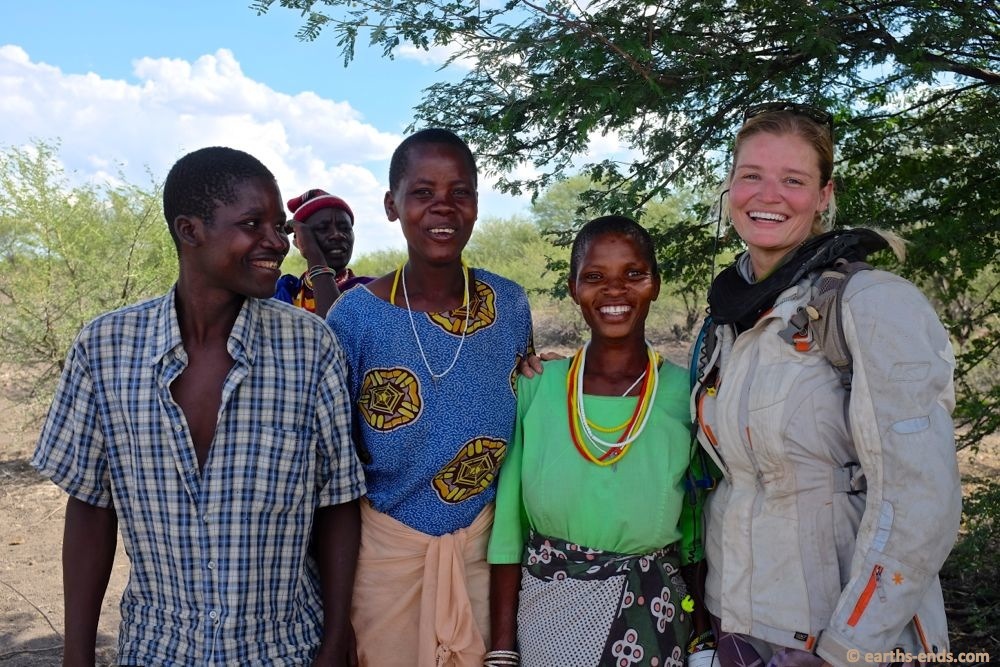
There were some friendly locals on curious to know what on earth two tourists were doing all the way out here in the middle of nowhere.
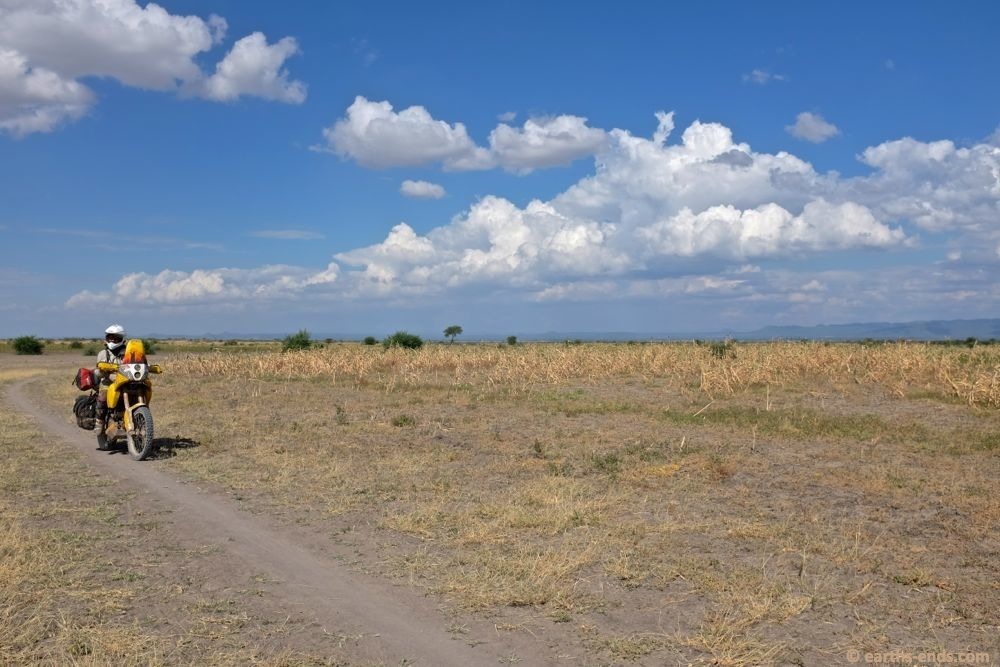
Piki-piki trails on the west side of the river. No cars here.
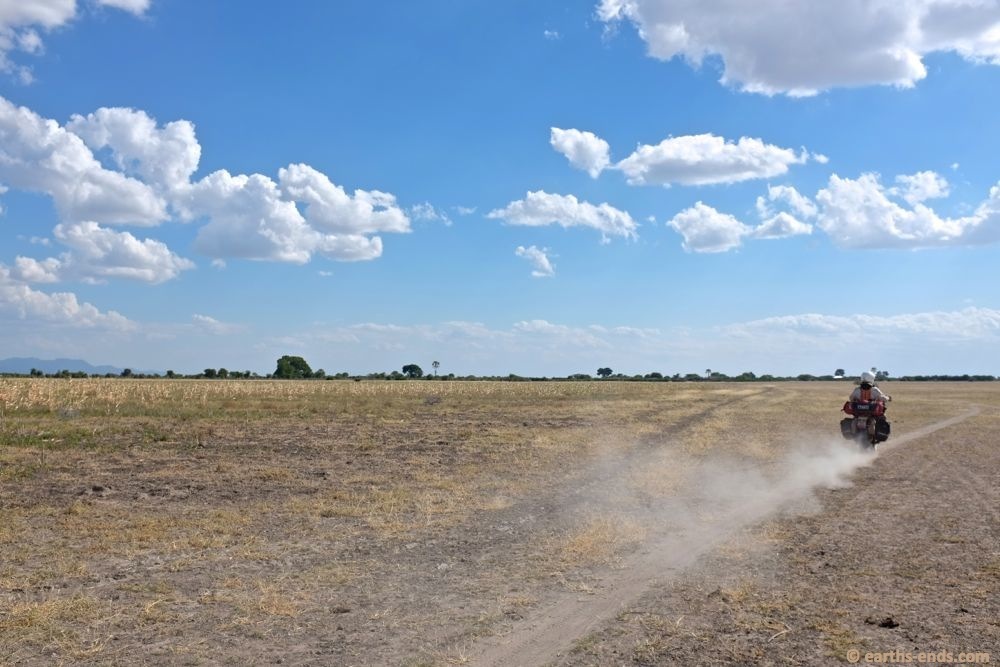
Go west!

We stopped for a cold drink in Bukundi, but failed. Only warm coke available.
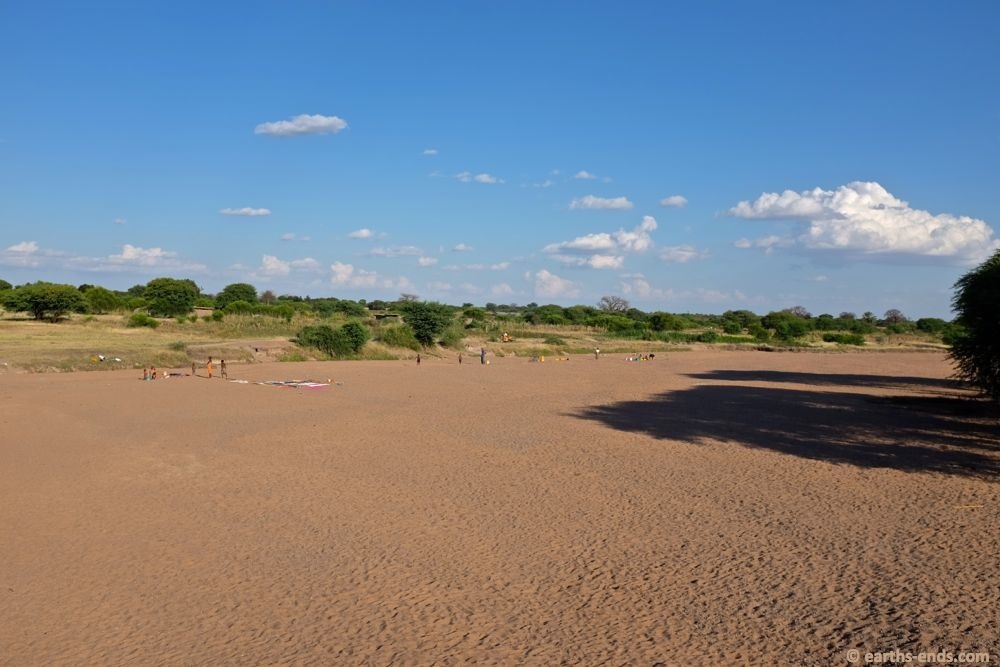
No running water out here, they are people decanting water from holes dug in the river bed. Every river we crossed had holes dug in the sand to extract water and people everywhere with water containers.
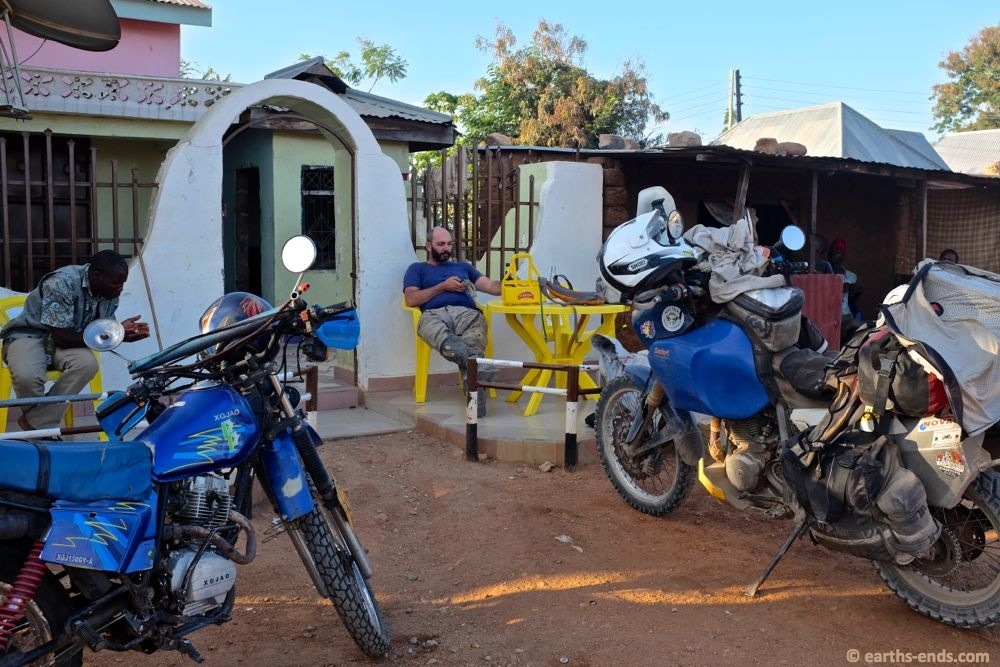
Our USD2 accommodation for the night. The beers were nice and cold which was very important after such an eventful day.
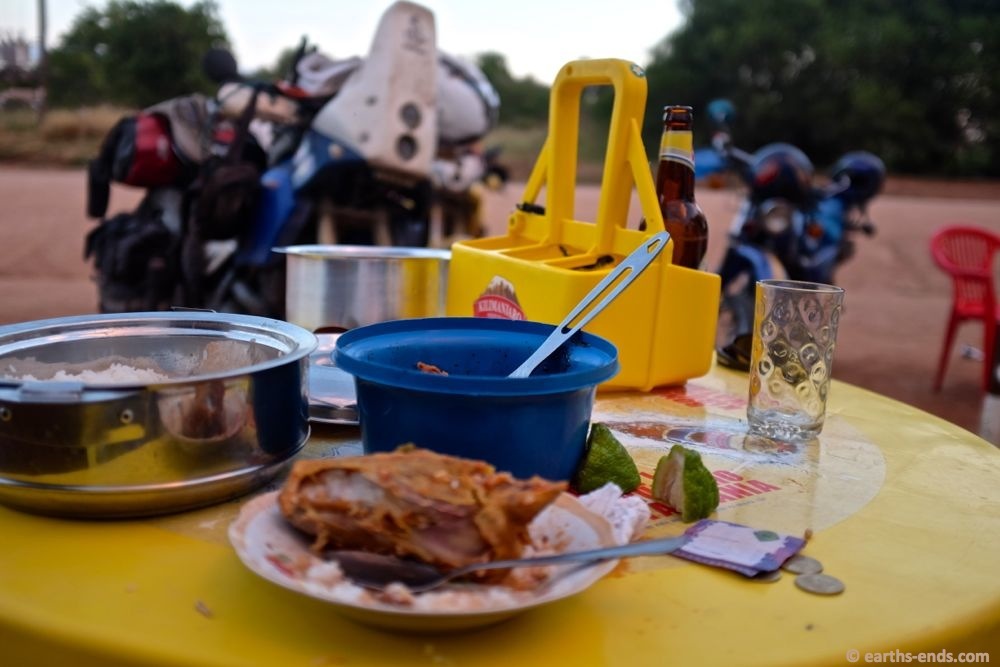
We got some dinner of chicken and rice and beans for TZS5000, about USD2.5 for both of us. The lodge owner was nice and got a good rate for us. A local guy wanted to sell us a whole chicken for 10000, and with rice for 15000. When we baulked at the cost the owner sorted us out a good dinner for cheaper.

These kids hadn’t seen many tourists. They were curious….
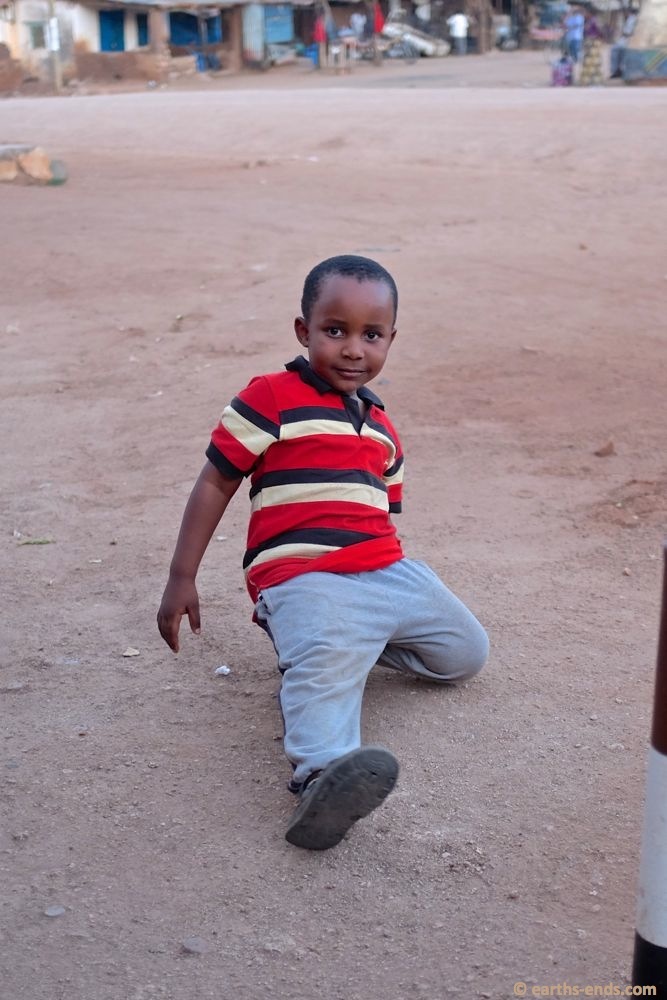
…. And keen to show off for the camersa.
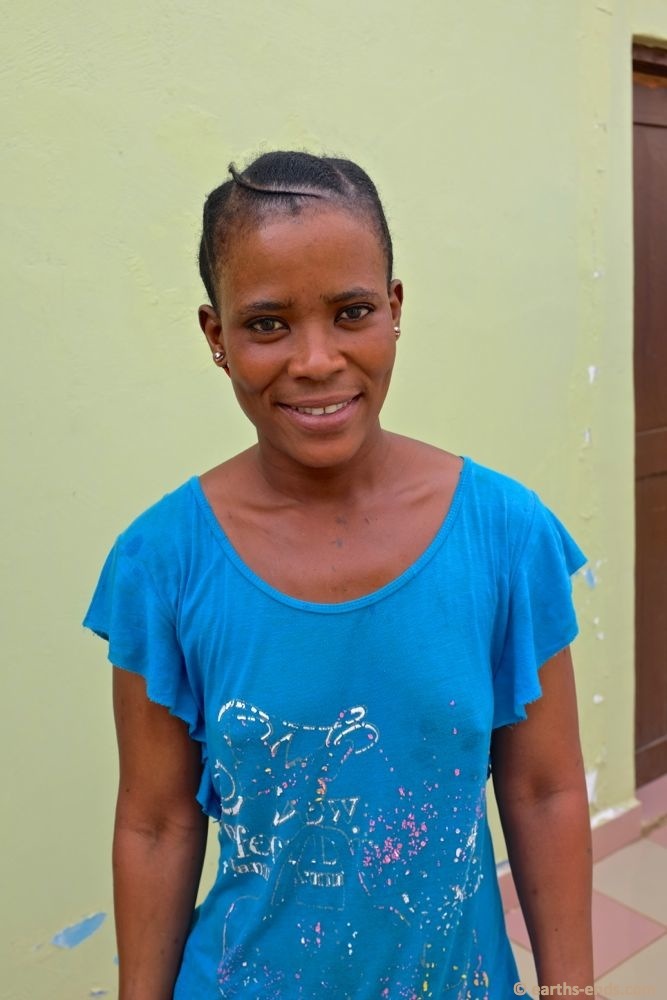
One of the ladies who worked in the hotel was keen for a photo, she asked us to take on of her.
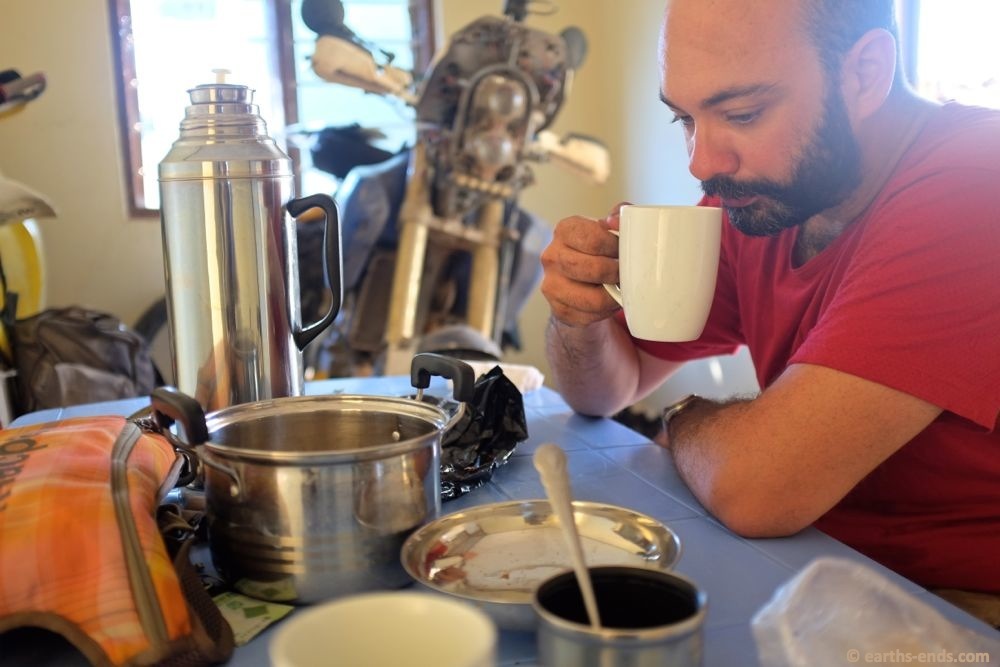
Breakfast in Tanzania is always tea and chipatis. Nice sweet milk tea, generally spiced, and fresh chipatis. Awesome.

We had to sortout some issues before hitting the road. The mud from riding around kili or maybe from the crossing made my fork seals leak so quickly cleaned them. I also had a few electrical issues; a fuse was out meaning I had now power to the front of the bike and I also found a broken wire which meant the high beams weren’t working.
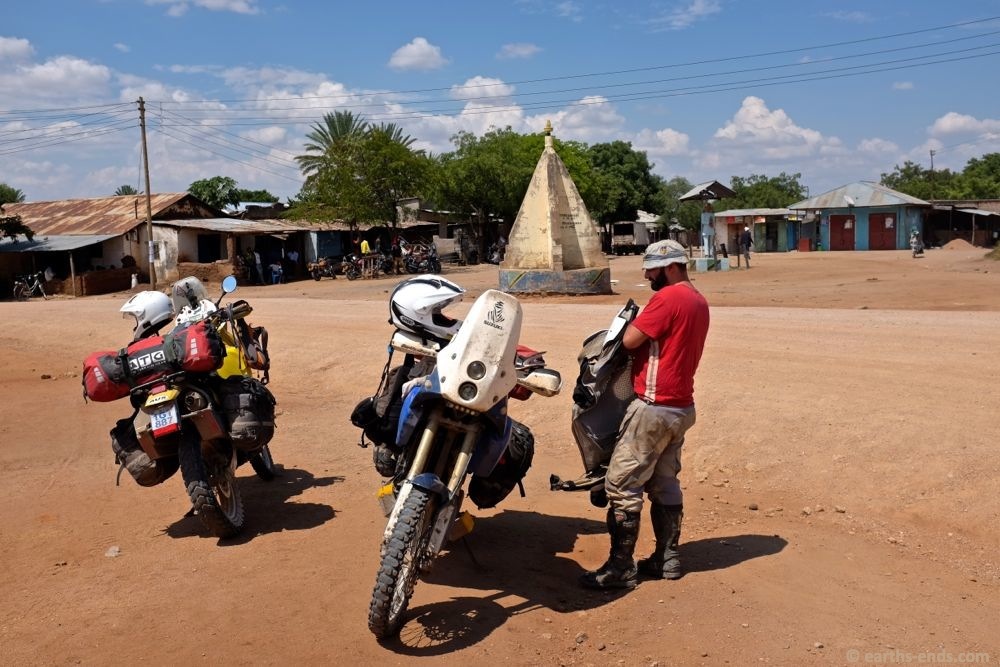
Hit the road Jack!
From there we had about 70km of dirt road, then we were on the tar that we would have to share with the trucks and buses all the way to Rwanda. We made about 400km that day and ended up in a tiny little town about 100km from the border. It was our last full day in Tanzania – for now anyway. We did our usual trick of getting some chipatis and tea in the market for dinner and breakfast the next morning and made the last dash for Rwanda.
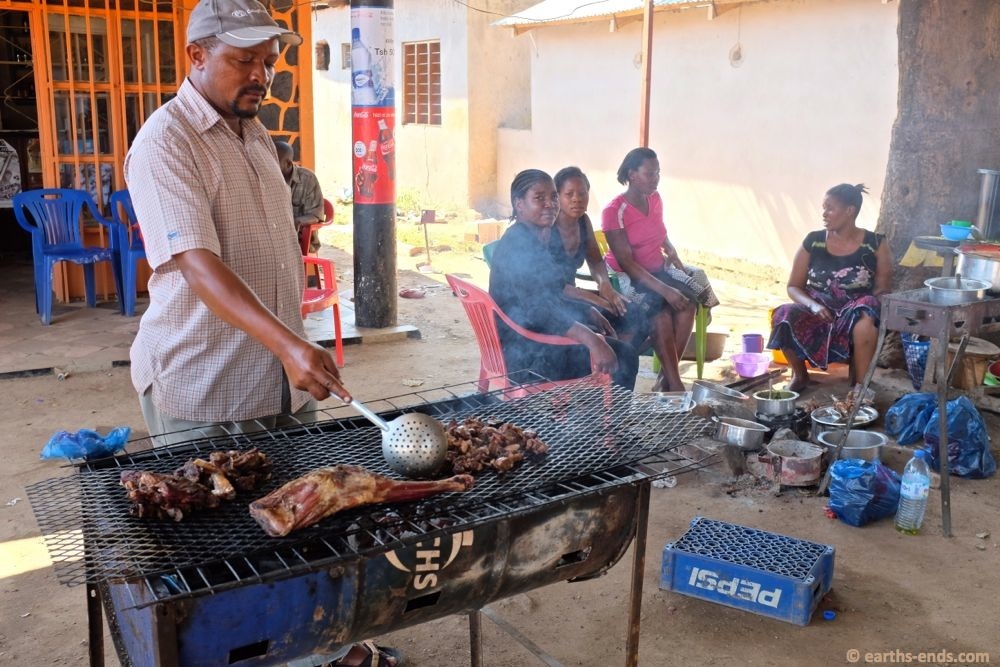
Lunch stop on the way to the border…

Our cheap accommodation for the night. No running water and the toilet is just a hole in the ground, but it was only USD2 and had a mosquito net. And no bed bugs… Places like this are so tight for cash that when we arrived, the lady who ran it sent a text message to the water delivery guy who then turned up on a bicycle to deliver water so we could wash.
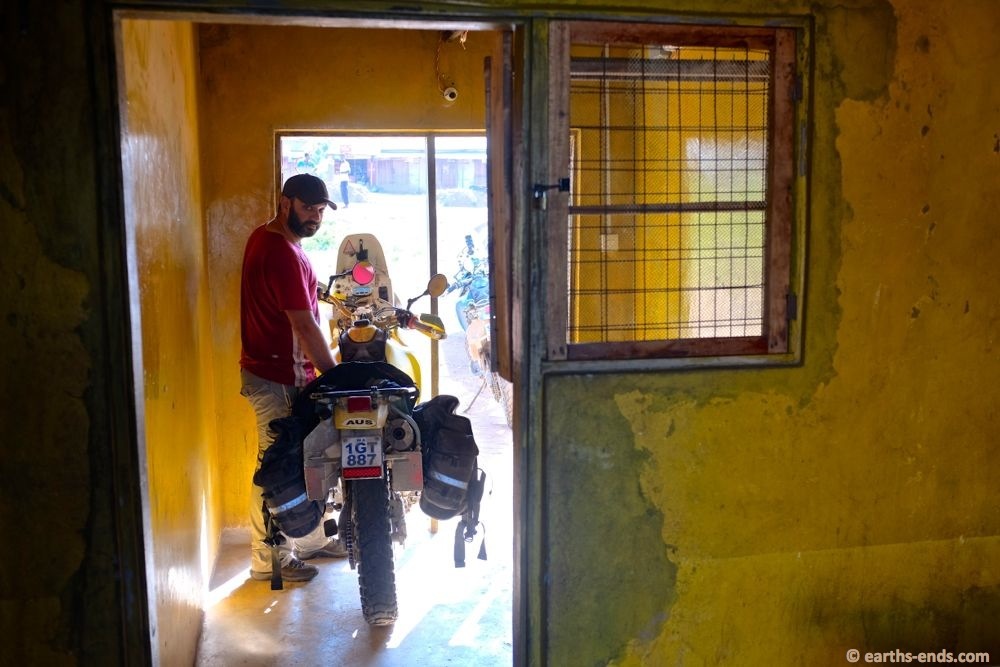
Getting our bikes out in the morning.
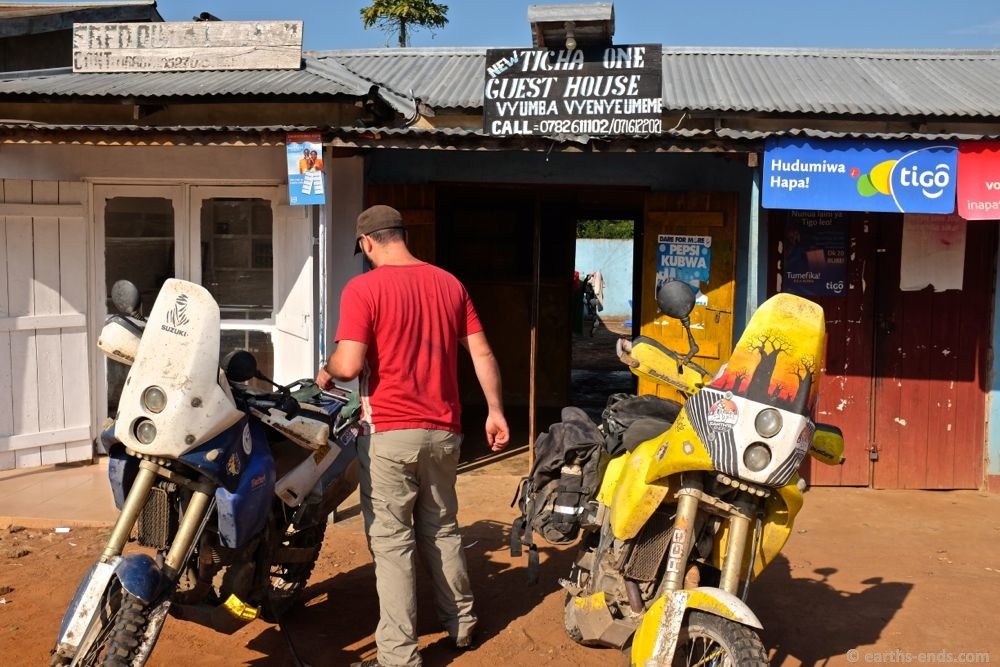
Our tiny little guesthouse. Seems no matter how tiny, every town in Tanzania has a tiny guesthouse of some description. Most are pretty basic, like this one.

Blog 39 by Tan: The Perils of an All Meat Diet
The next few days were taken up with periods of essay writing, even larger periods of procrastination, pizza eating and hot shower taking. Our guesthouse was staffed by exceedingly kind and dedicated workers who couldn’t do enough for us. One young waiter had just moved to Moshi from the countryside and was so proud of his job and executed it with the intensity of your average bomb disposal expert. Soon enough the essay was completed and handed in and we could once again go back to being free wheeling, responsibility free, RTW motorbikers. Before leaving the guesthouse I had promised to take the receptionist for a spin on the bike. She couldn’t understand why we would want to travel so far on our bikes. I told her she’d have to get on the bike to understand and she was extremely keen. So off we went down the main drag of Moshi and she was soon yahooing on the back and asking to go faster and proclaiming loudly ‘I feel so….freeeeeeeeeee!’ Another biker is born. I was further encouraged when she requested we ride back on the poor quality dirt road instead of the tar.

Our receptionist and new motorbike enthusiast
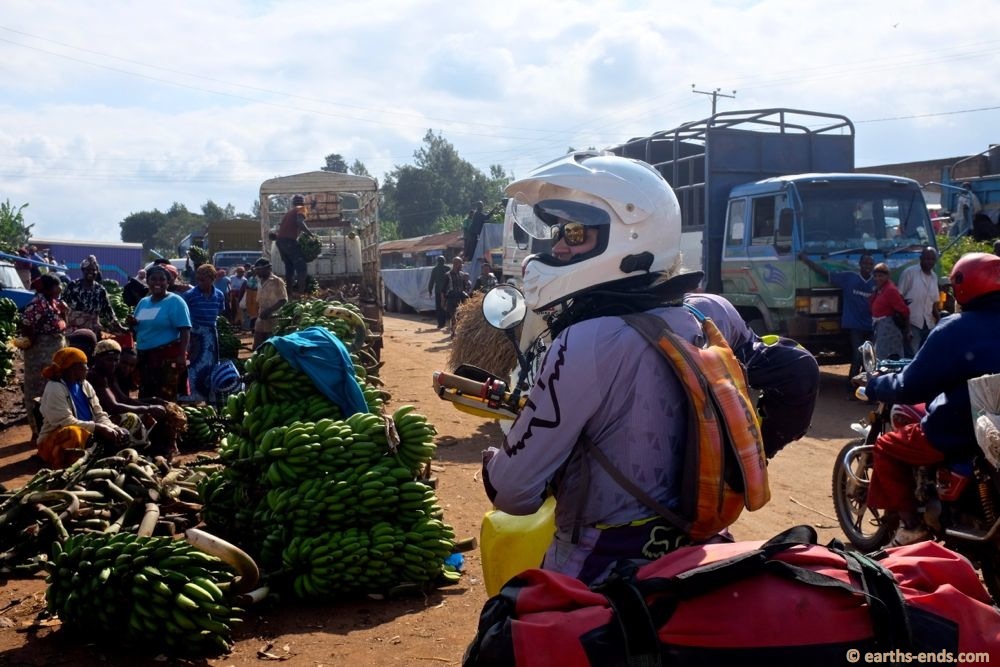
On our off-road excursion we came across ‘Banana Town’ a village where bananas were big business.

Sweet milky tea is one of the best things about riding in Tanzania
Before starting this trip we had a handful ‘must do’ things on our list for Africa. We wanted to lock in these expensive experiences ahead of time to avoid the guilt one gets on spending extravagantly while on a budget. Doing a safari in the Serengeti and Ngorongoro was firmly on that list. We’d been recommended a tour company called BobbyTours who were supposed to offer the cheapest 4 days camping safaris in town. That said, the best way to get a cheap tour is often to rock up and go from office to office and use the ample competition to your advantage. A few things were working in our favour; there are said to be 400 tour companies operating in the National Parks around Arusha (seems quite possible), we could leave the following day, it was the low season, and tourists to Africa were down on the whole due to Ebola fears (never mind the fact there were no cases in southern and east Africa). So off to Arusha we went.
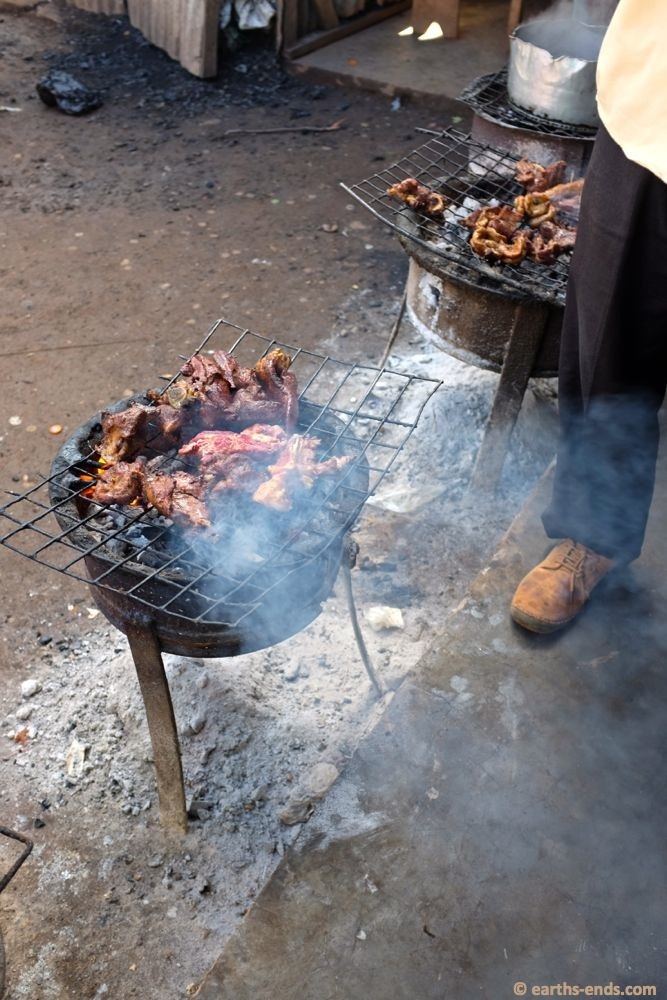
We stopped and got chapattis and a bowl of bbq beef
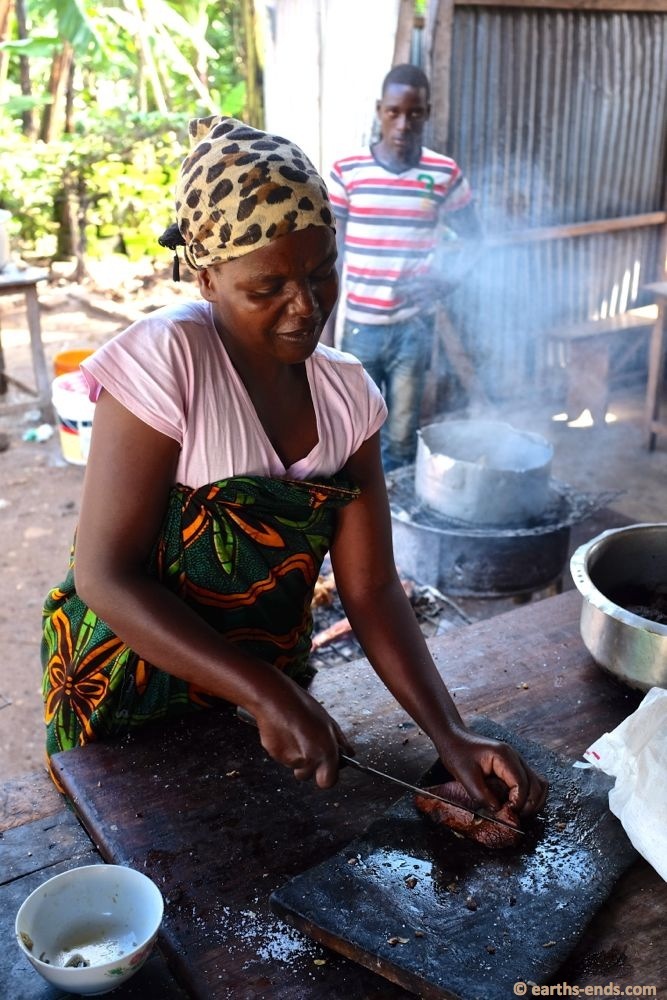
The cow had a hard life and it was a mission to get through it. In Africa it seems in many places cows are collected and only sold when they need to be and usually they are old and tired at that point.
Rather than take the highway from Moshi to Arusha we opted to do some exploring. We’d been told there were some great tracks around the base of Mount Kilimanjaro and that you could do ride around most to the mountain on dirt trails and come around the back of Arusha between Mt Meru and Kilimanjaro. That sounded far more appealing than dodging trucks and harried tour vehicles on the tar.
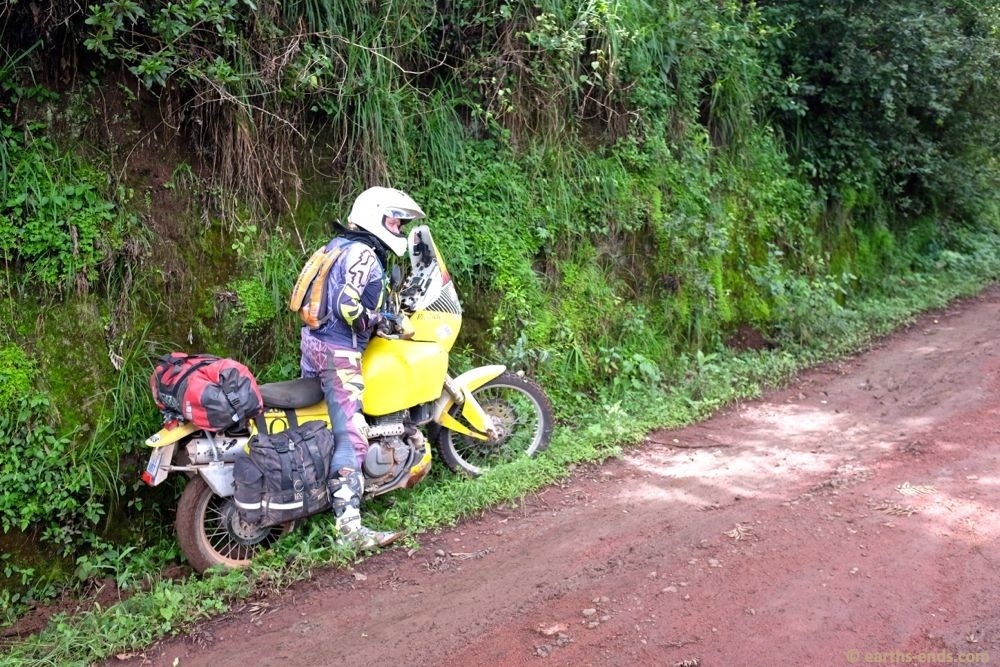
The trails were beyond slippery. I was happy that I didn’t bin it, not so happy that I was now stuck in a ditch
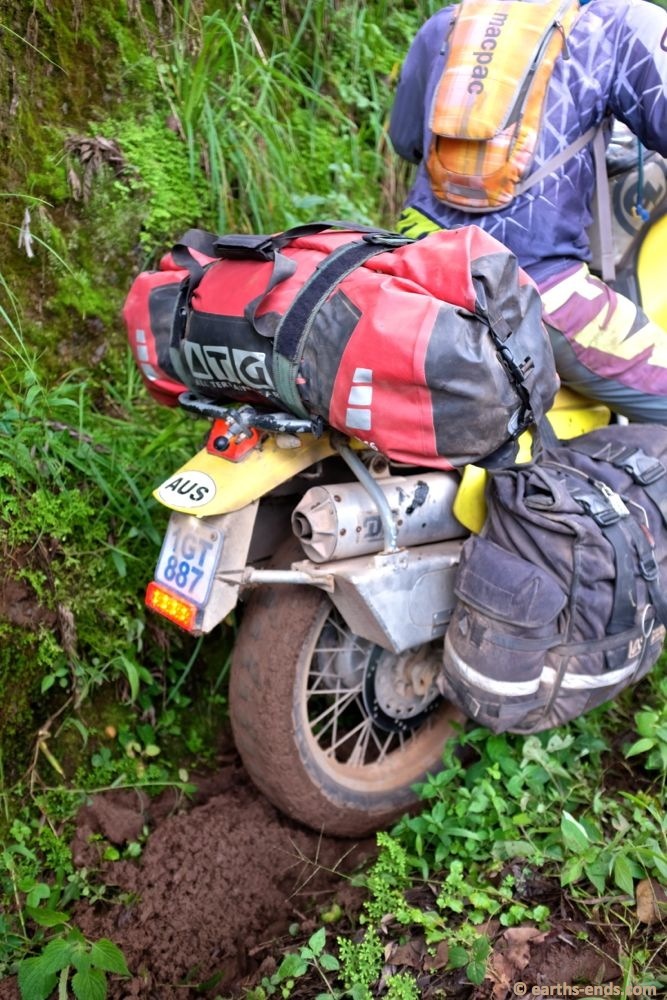
The K60s are a particularly ineffective mud tyre
Only having a bit of an idea where to go we managed to find track that snaked its way up the foothills of Kilimanjaro. Having just come out of Tanzania’s little wet season it was hardly the best time to be riding these muddy tracks but we had nothing better to do so went for it. We quickly found ourselves on slippery, red mud tracks. While our 50/50 tyres weren’t exactly inspiring confidence, they were managing. Mick and I are both pretty experienced riders, however our desert riding background in Australia gives us little opportunity to experience mud. We are bloody clueless in the stuff. Give us a desert full of sand dunes and we’ll monster it. Put us in front of a bit of mud and we look awkward as a newbie riding attempting a hill start. Yet we managed quite fine. It was indeed good practice for our upcoming ride through the Democratic Republic of Congo. If the wet season arrives in the DRC before we do we are bound to become proper mud riders….either that or have to get a residents permit for the place.
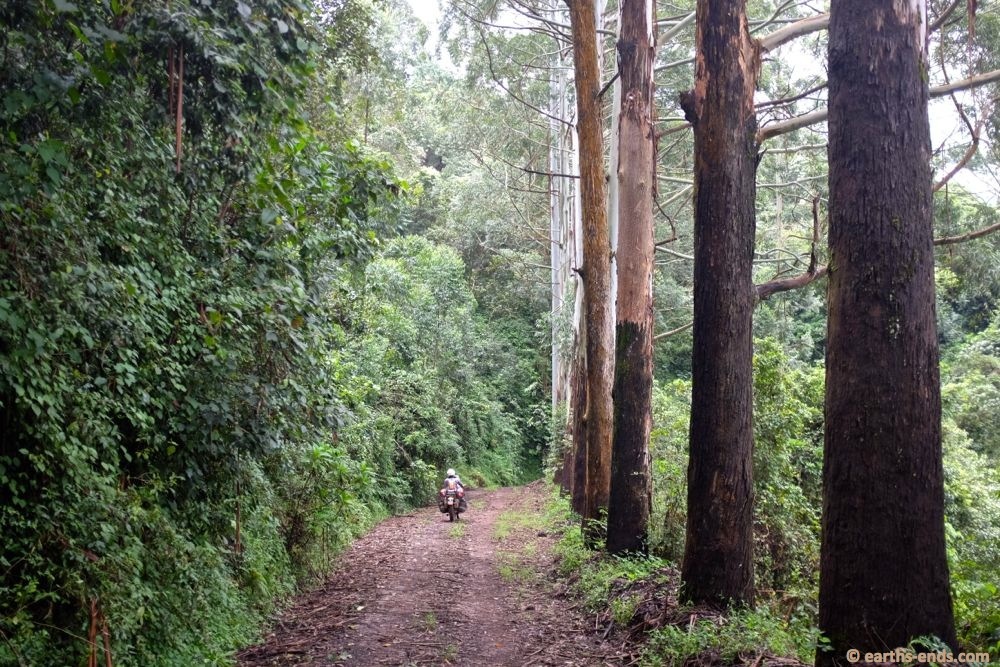
The huge Eucalypts reminded us of home
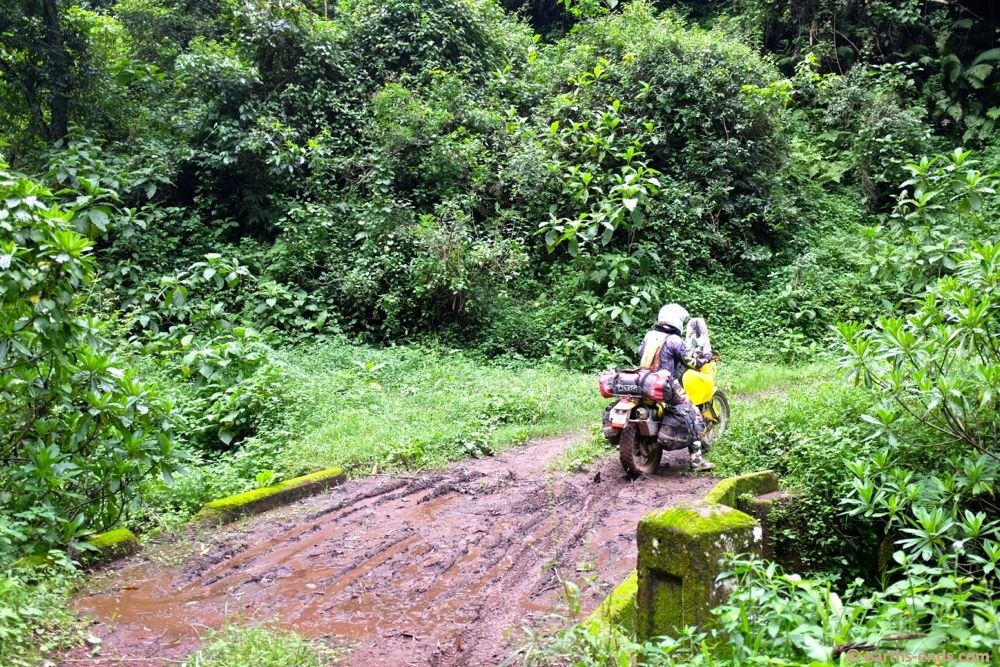
This mud was easier to deal with than the ‘grease on a mirror mud’
As we progressed higher up the slopes we encountered stuff you would hardly call mud. It was a lot more like grease. Or ice. Or grease on ice. It was difficult to even walk on and when picking up the bike it was hard to find sufficient purchase with your feet to do so. It made for an interesting outing and a fantastic exercise in throttle control. Unlike sand where you can pretty much just accelerate yourself out of any type of trouble, this stuff required such a steady throttle hand. Anything but the most gentle and controlled acceleration or deceleration would instantly result in wheel spin/skid and a near instantly horizontal bike.
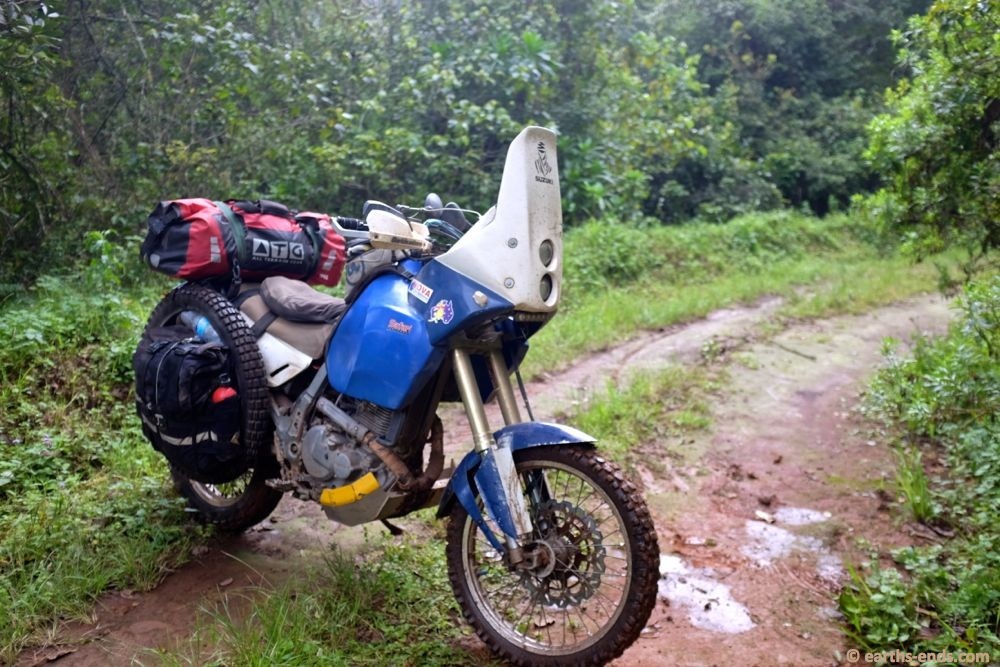
It was seriously slippery
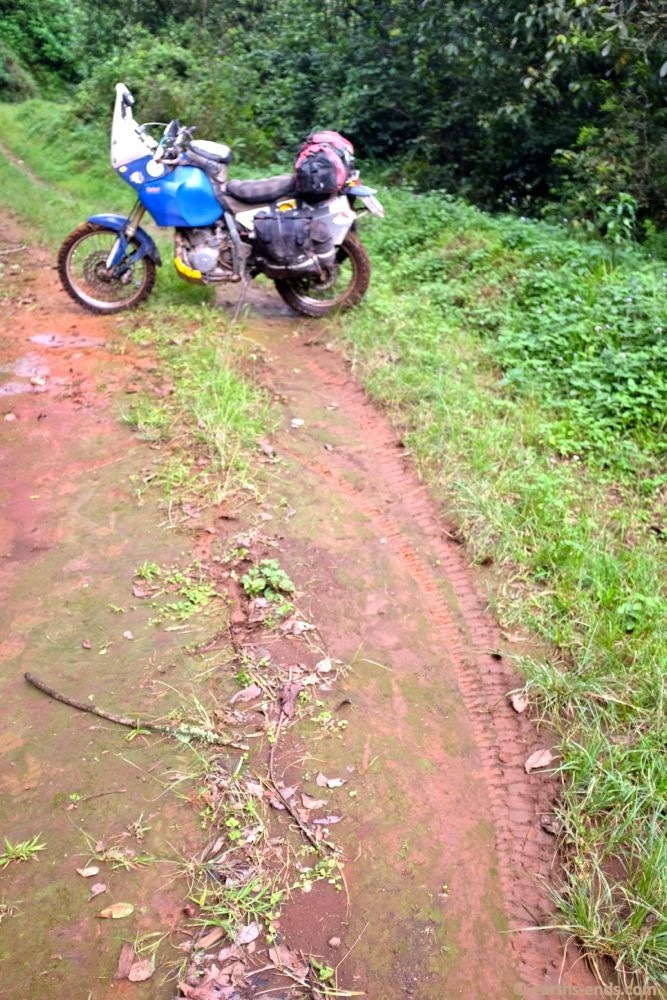
Yet looks completely innocent
We continued until we hit a quality tar road which wrapped around the back of Kilimanjaro and lasted for long enough for us to wonder why our intrepid mate Michnus (insert ride report) recommended it so highly as a great off road route. Patience paid off and we eventually hit some lovely dirt tracks though sparsely populated farmland. We found ourselves riding through some tiny villages and past a bunch of Masaai men and children herding their animals and looking at us with friendliness and mild surprise. The road was manageable though somewhat eroded in parts. The lack of significant challenges meant we could really drink in the scenery.
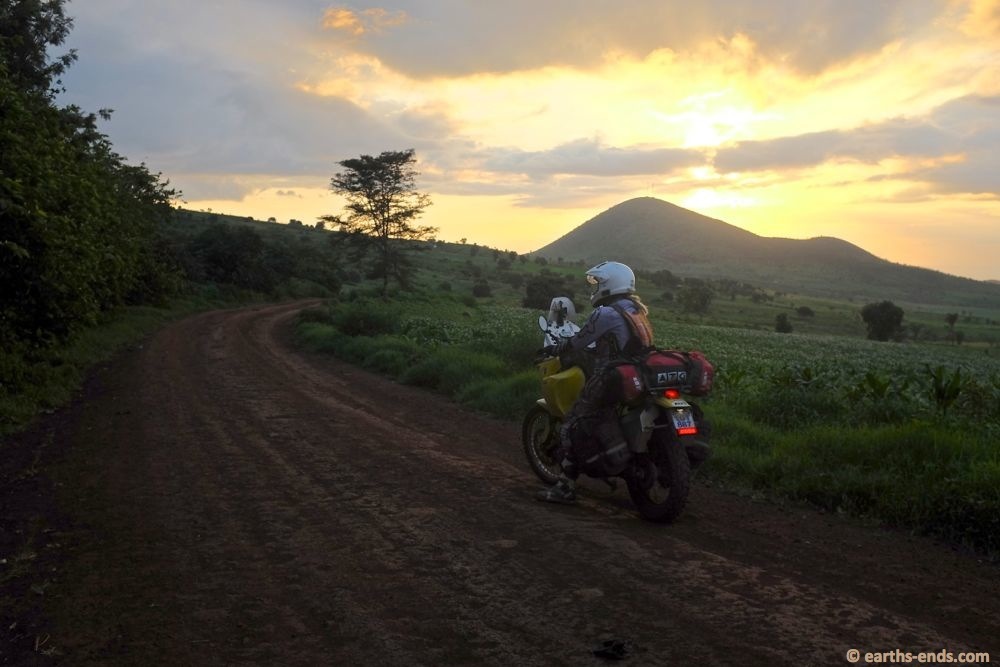
The sun going down far from our destination
Once again sundown was coming too soon and we were far off making it to Arusha. This is why we are taking so long getting through Africa. Instead of taking the straight forward way (in this case, the 77km of highway) we couldn’t help but ‘make it more interesting’ (~270km of dirt, mud and winding tar). So there we were looking like we wouldn’t make it to Arusha. Finally we came across a village with a slightly larger collection of dwellings and asked if there was a guesthouse. We found one that looked like the worst guesthouse we had encountered on the trip (and that is saying something) and they wanted a pretty penny for it too. Our decision to move on was sealed when we noticed the many hundred of gin in plastic sachets littered all over the ground in front of the place and some half-cut (Aussie slang: very drunk) guys loitering around the place. It gave us the creeps so we pressed on despite the setting sun.

Negotiating the gardens of the West Kili Lodge
We never plan to ride at night but every few months or so it happens. And when it does we are glad for our ridiculously bright bi-zenon headlights. We weren’t riding in the dark for long but it was tense and we were looking to find a guesthouse asap. The first couple we came across didn’t seem all that safe for the bike and had some serious drinkers in house so we carried on. Eventually we happened upon a place that we found out was worlds outside our budget but the guy who owned the West Kili Lodge was a legend and didn’t want us to go out riding again and took the price down to whatever we could pay. And included a brilliant 3 course dinner so we rather unexpectedly found ourselves in some pretty impressive lodging for the night.
The following day we organised our 4 day tour of Manyara, Segergeti and Ngororgoro National parks. We were the only ones on the tour and managed to get the tour for US650 with Bobby Safaris. And while that is massive coin by all accounts that is ridiculous cheap even for the low season. When we learned the cost of the park fees the expense all of a sudden became quite reasonable. They really can’t have made much margin off our 2 person tours.
The next few days was spent doing little but eating and checking out African wildlife. They says pictures are worth a thousand words which means I don’t have to write any more in this blog – Hooray!
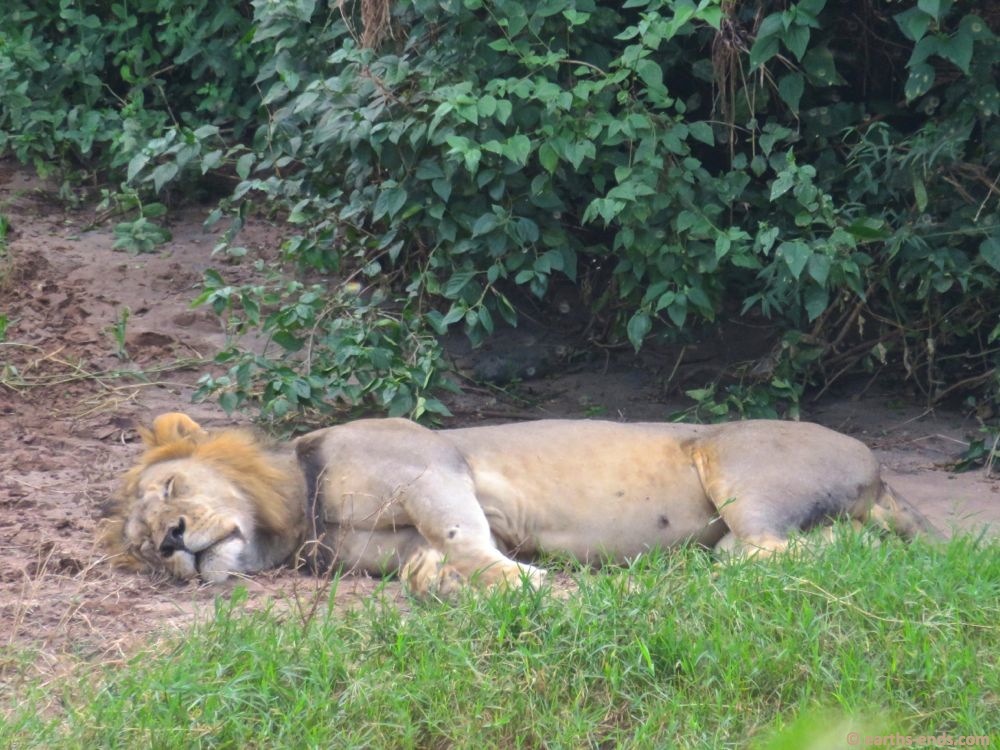
Behold our first ever lion in the wild

We found him near this gruesome find – a baby buffalo head. Looks like this poor fella was taken right when it was born. Lions often choose the moment of birth to take the young while the mother is suitably distracted.

This was an amusing display. The larger giraffe with the dark markings is a Masaai Giraffe and was trying like mad to mate with this other giraffe.
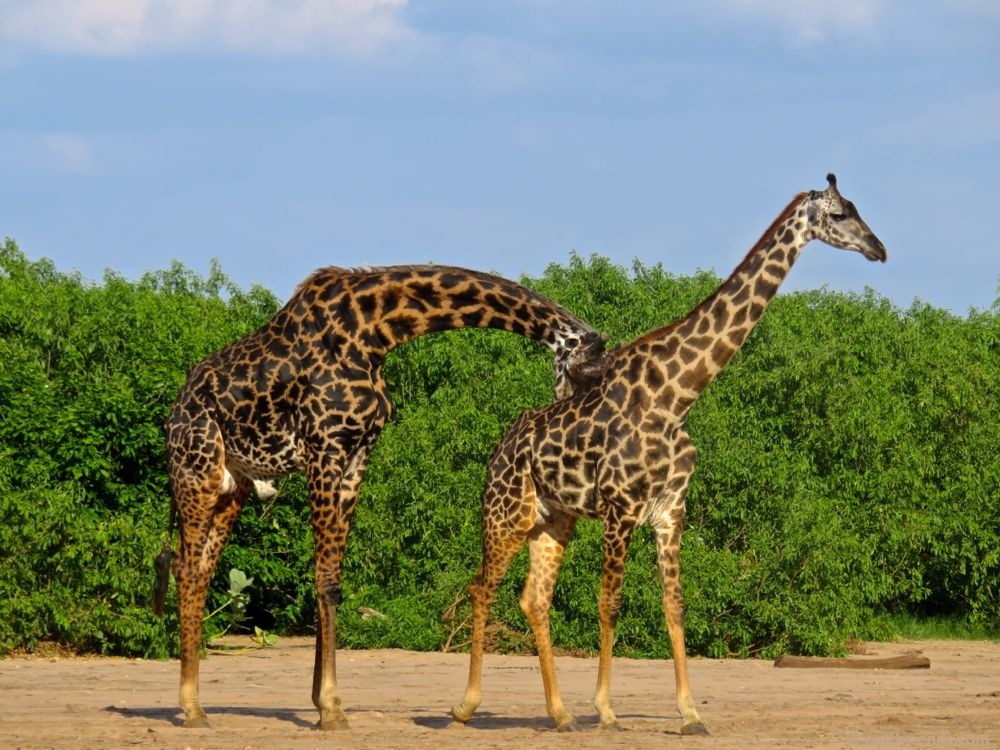
We watched him for ages willing him on as we were keen to see the no doubt hilarious sight of two giraffe getting jiggy. But he got epically rebuffed despite trying all the moves. He kept trying to the point we were embarrassed for him. Better luck next time big fella.
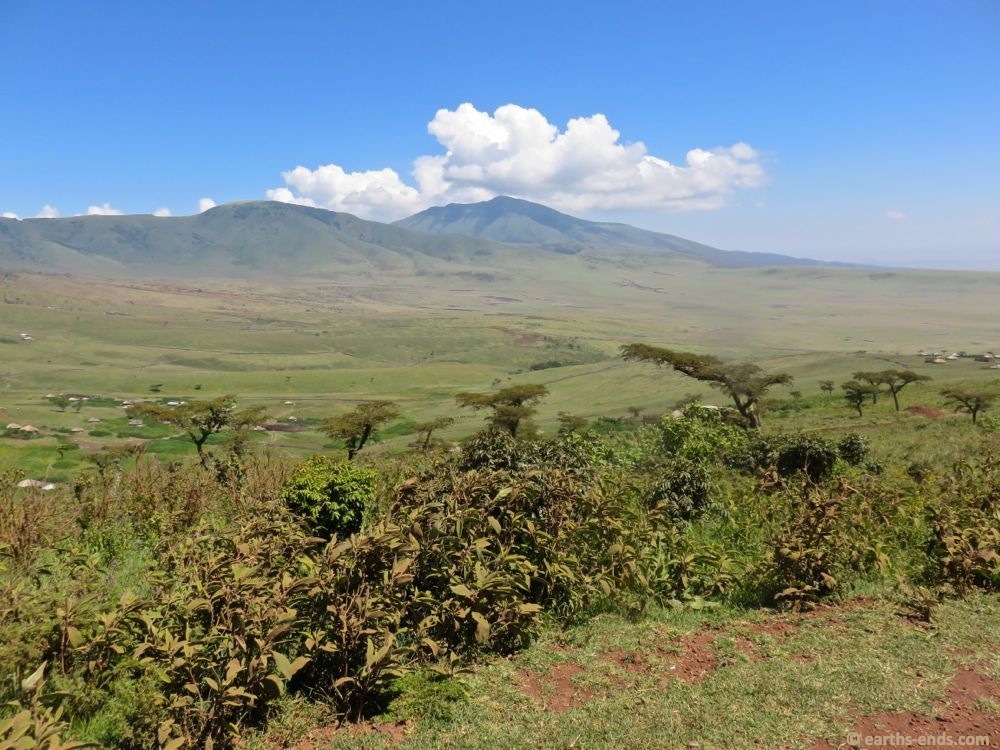
Some of the fantastic views on the drive to Serengeti NP
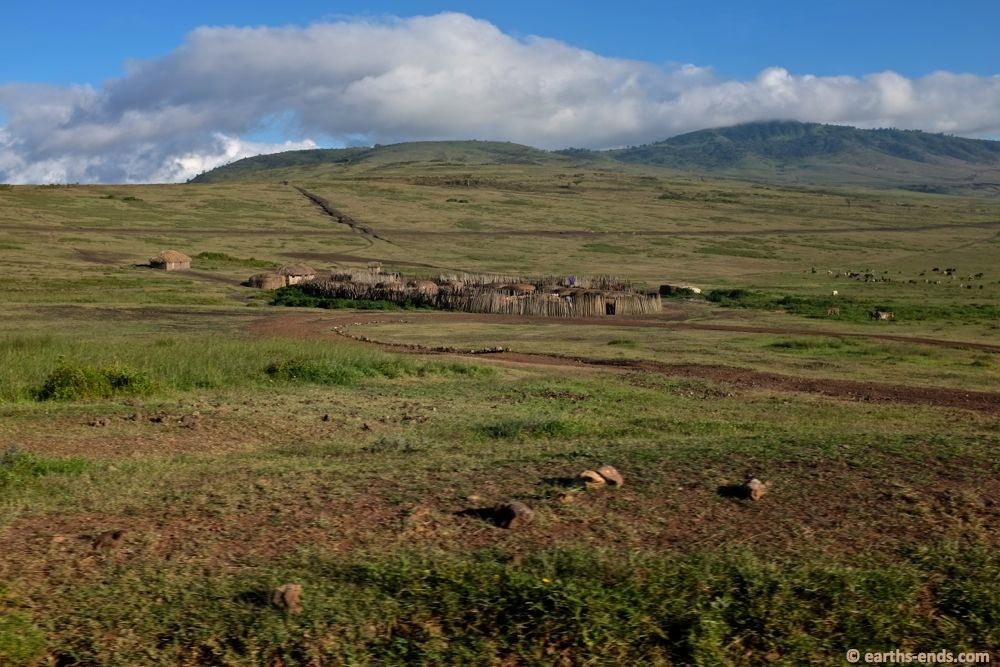
This is one of the Masaai cultural villages along the route to the park. It costs a whopping $US50 per car load to visit the boma. Naturally we didn’t do it. It was actually really depressing to see young kids lining the route sitting by the road all day. When a car pasts they will jump up and down willing the cars to stop for photos. Our guide seemed embarrassed by it and was adamant that it was the Aid organisations that work in the area that have forced them to do it. He says they don’t give medical treatment for free instead insist the locals go out and make money to contribute to the cost of their care. So this is what they do….Doesn’t sound true when they could simply sell a goat to pay for treatment. But it seemed to make him feel better about the activity

Mick at the Serengeti park gates. We were out of place in our non-safari attire. All the other foreigners were dressed like they’d just raided David Attenborough’s wardrobe. The animals didn’t seem to mind our clothes
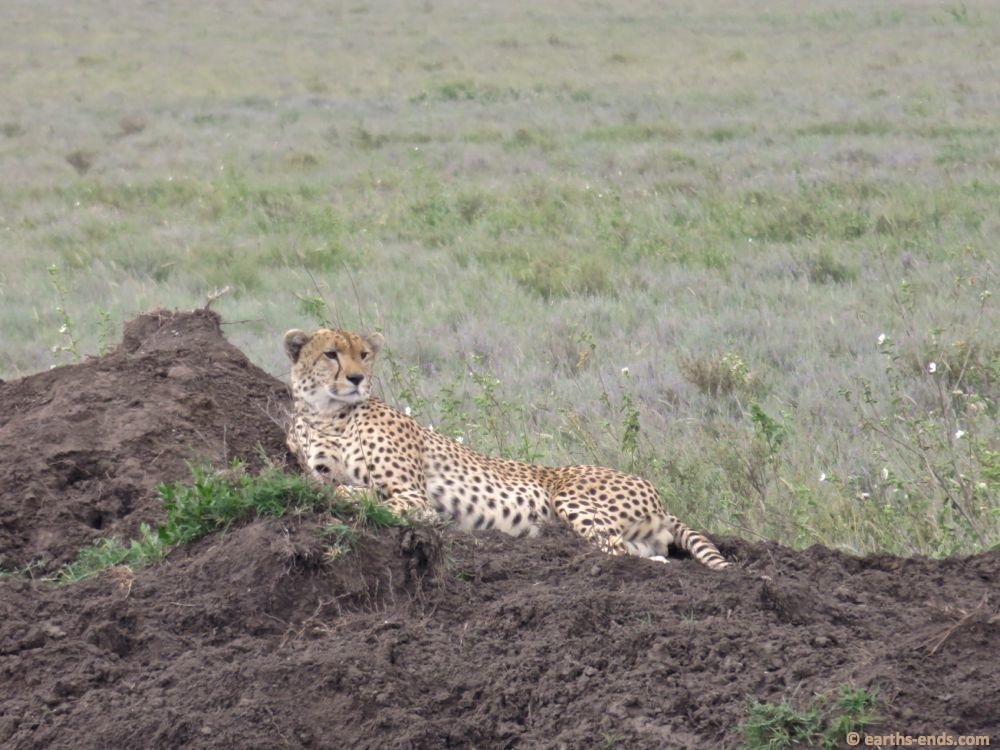
We found this guy right after entering the park. May have been a remote control puppet.
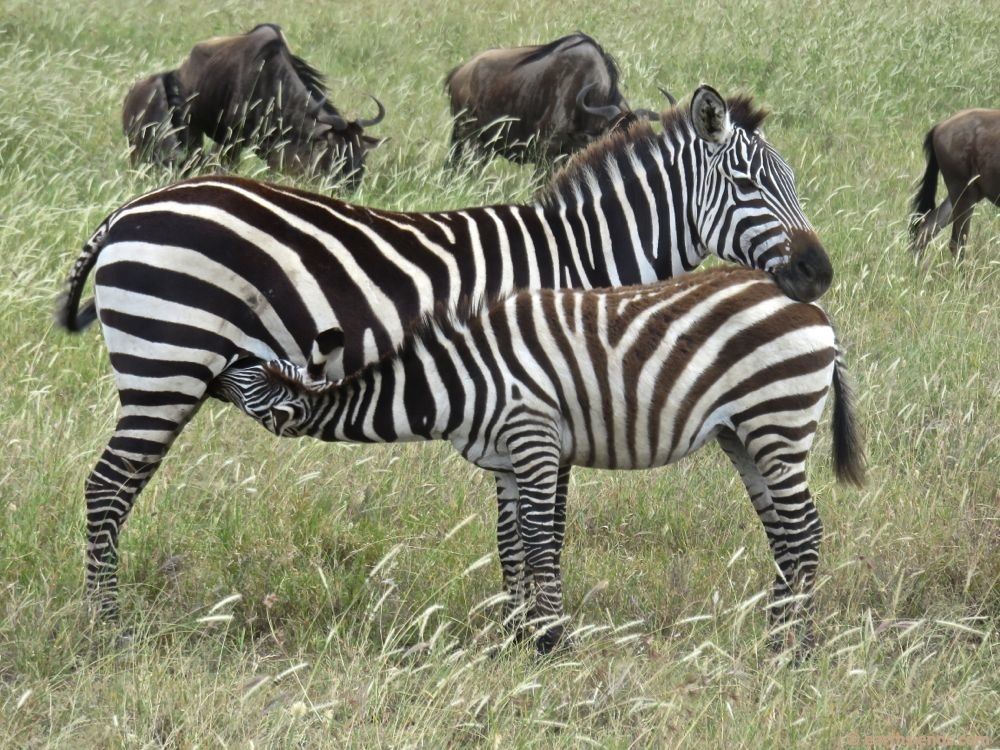
Mother and child
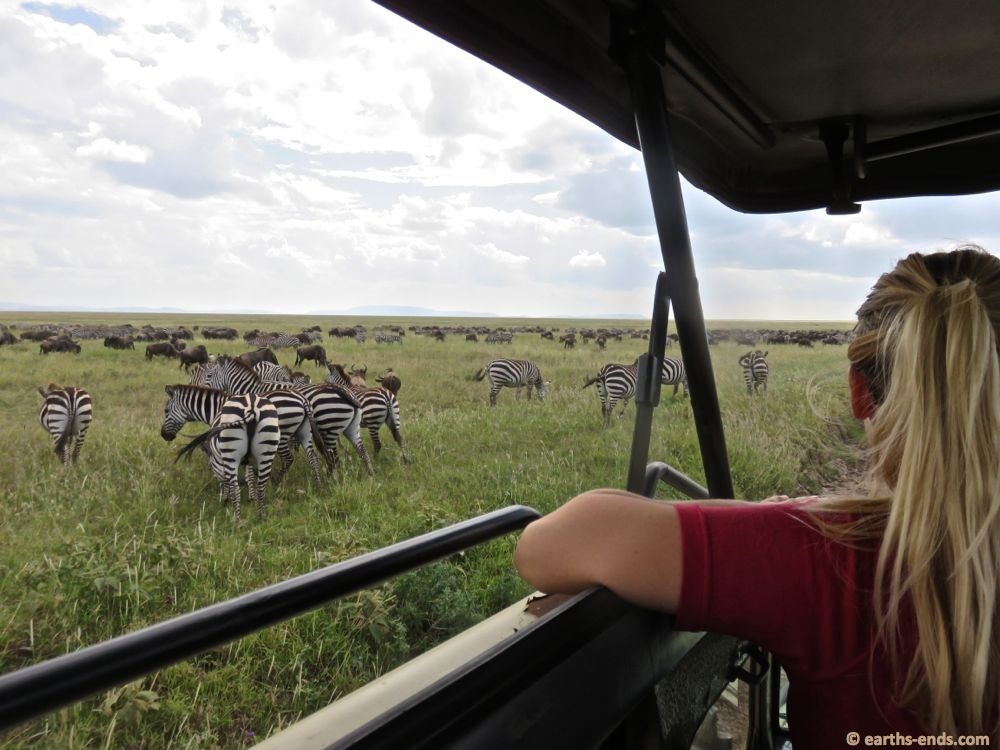
Some zebra telling me what they think of all this photos taking

Some elephant showing affection
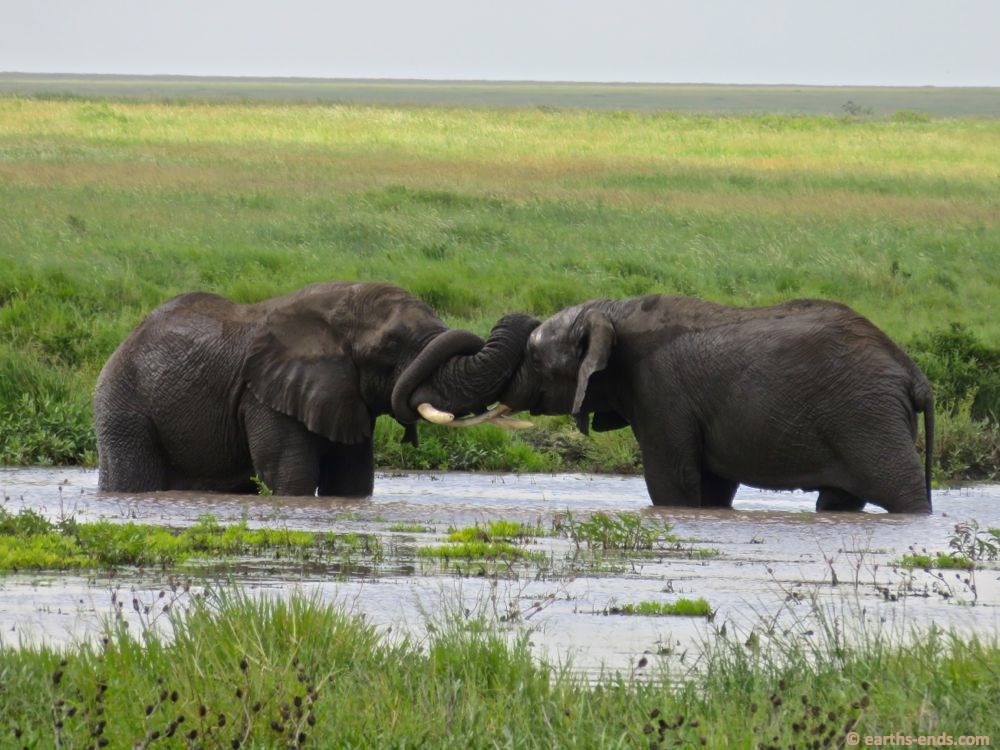
Seriously, get a room guys!

We were lucky to see the nocturnal serval cat out in the day and hunting no less.
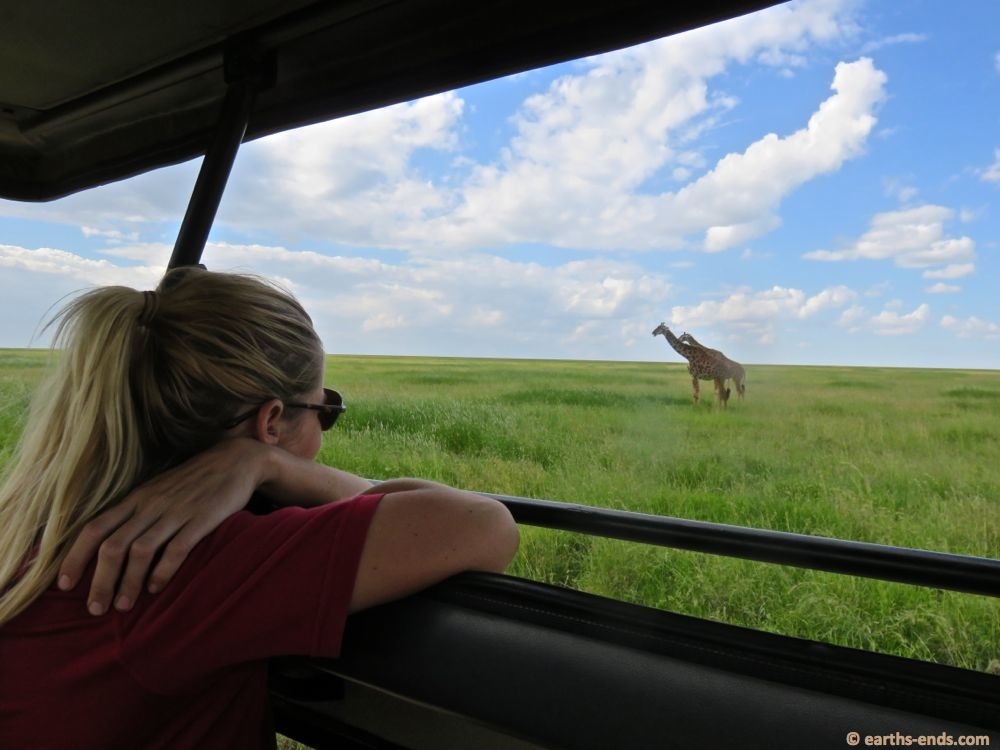
The views were amazing. And would you check out how freakishly large my hands look

This photo is for anyone thinking you could evade a lion by climbing a tree

Gorgeous girl
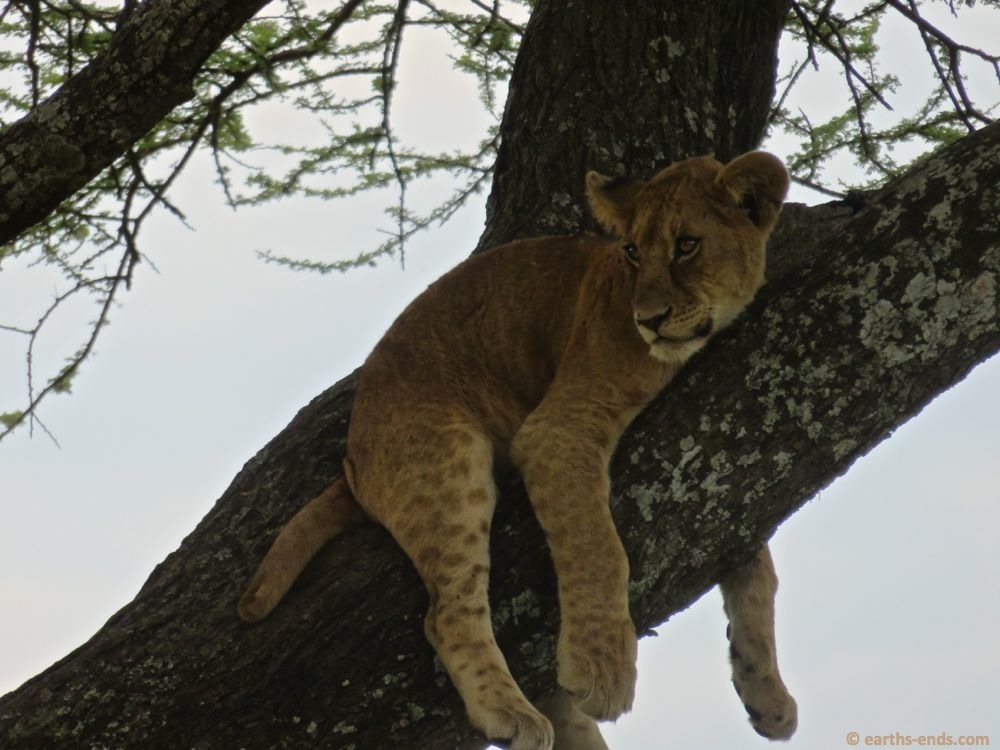
A young cub missing half of his tail
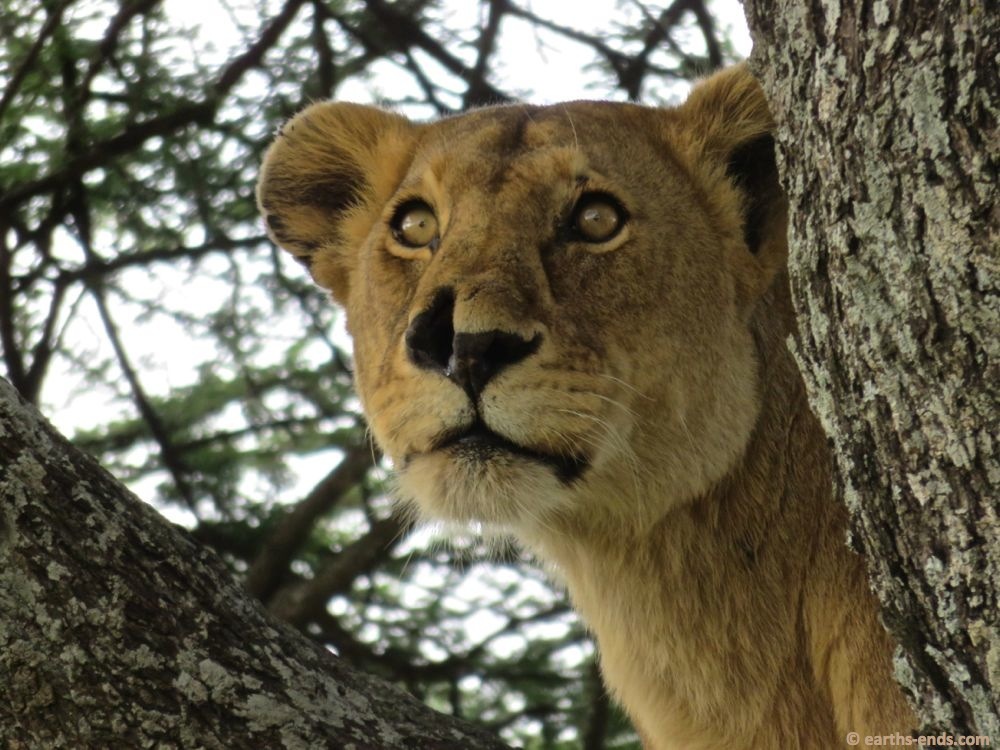
And a lioness missing part of her nose
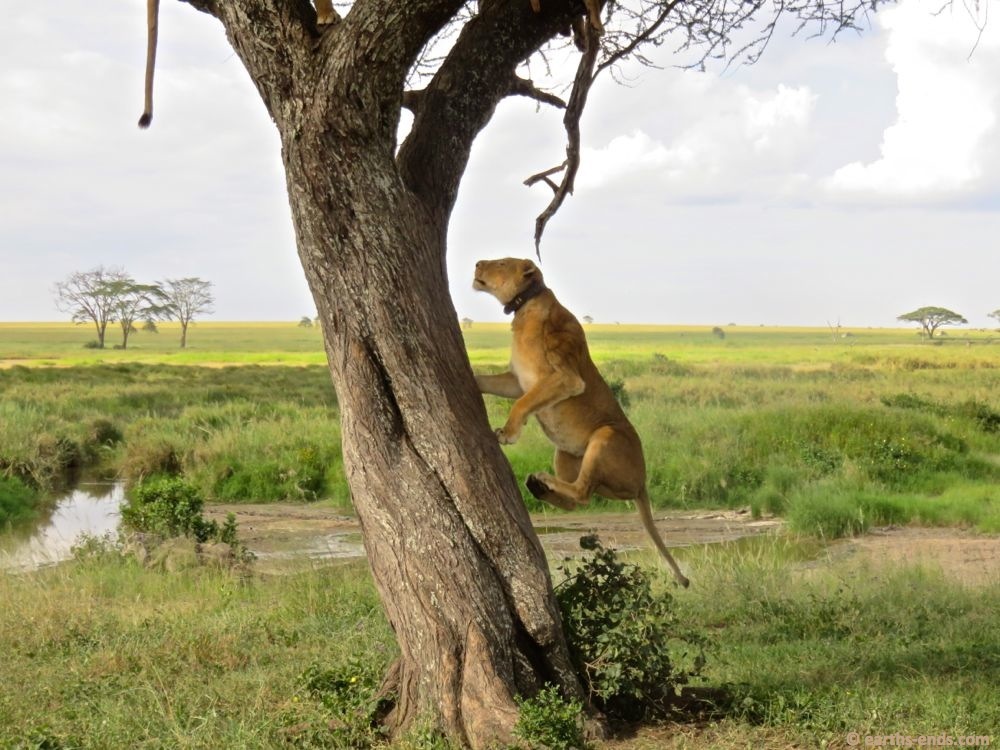
Sure they can climb…but they aren’t actually all that good at it
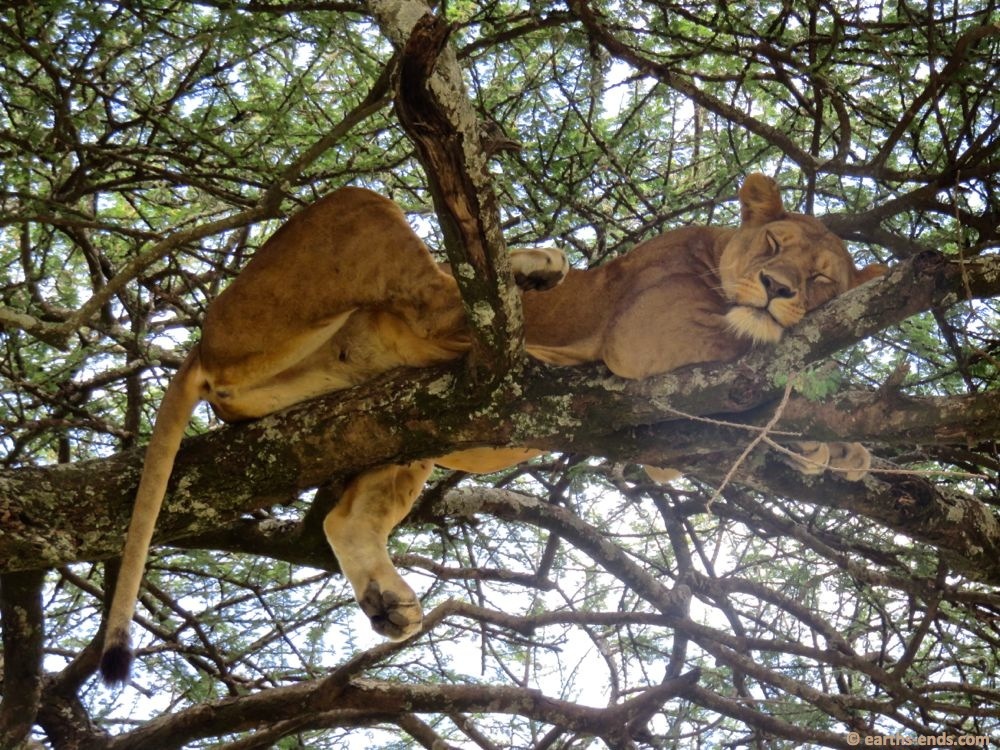
However some were really comfortable up there
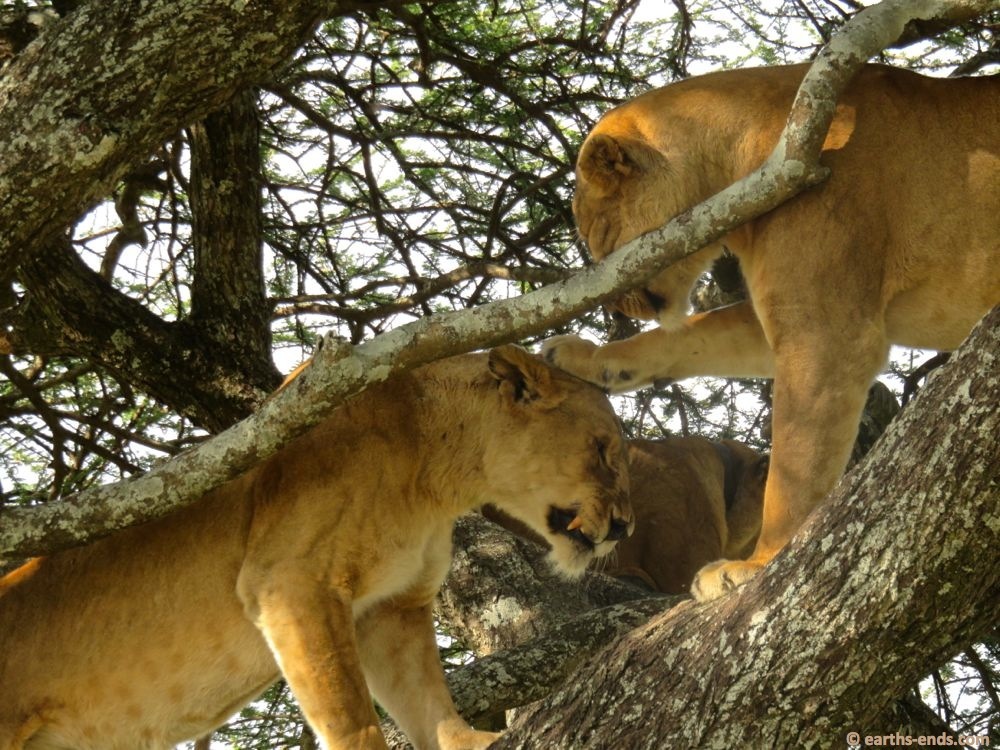
There were minor tussles over the best spots on the tree

Which were fun to watch
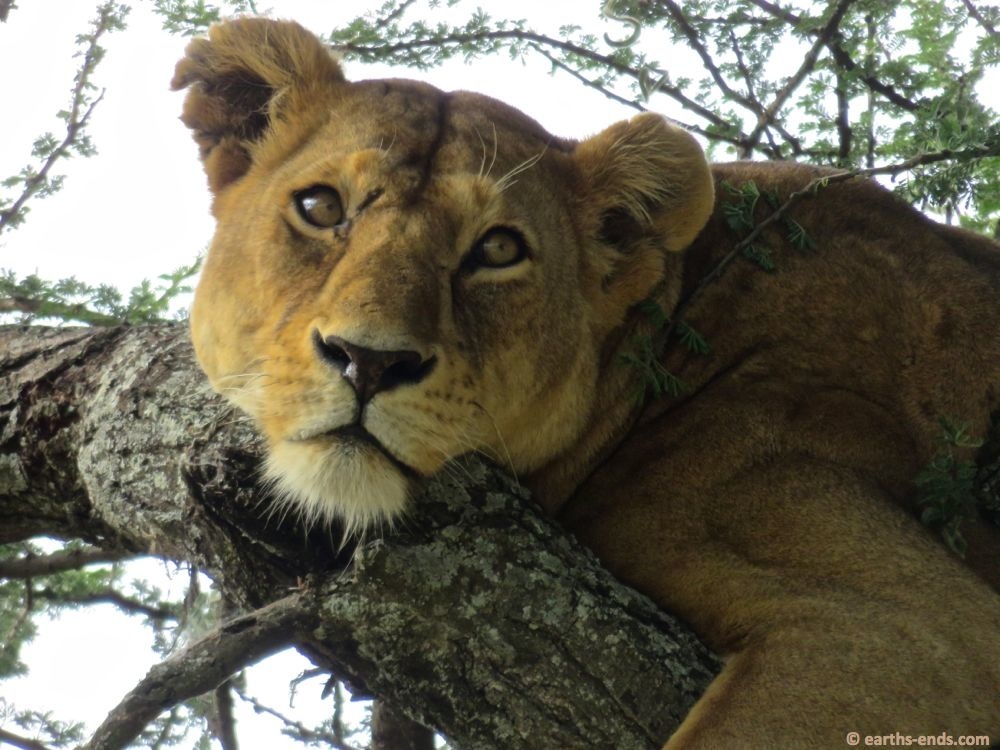
She could totally put this in her modeling portfolio

With all the attention on the tree it took us a long time to notice the dozen or so lying in the grass right by us

There were a lot of babies about

And large herds of elephants

This guy was a stunner. We got close

Too close for his liking (bear in mind this camera has no zoom)
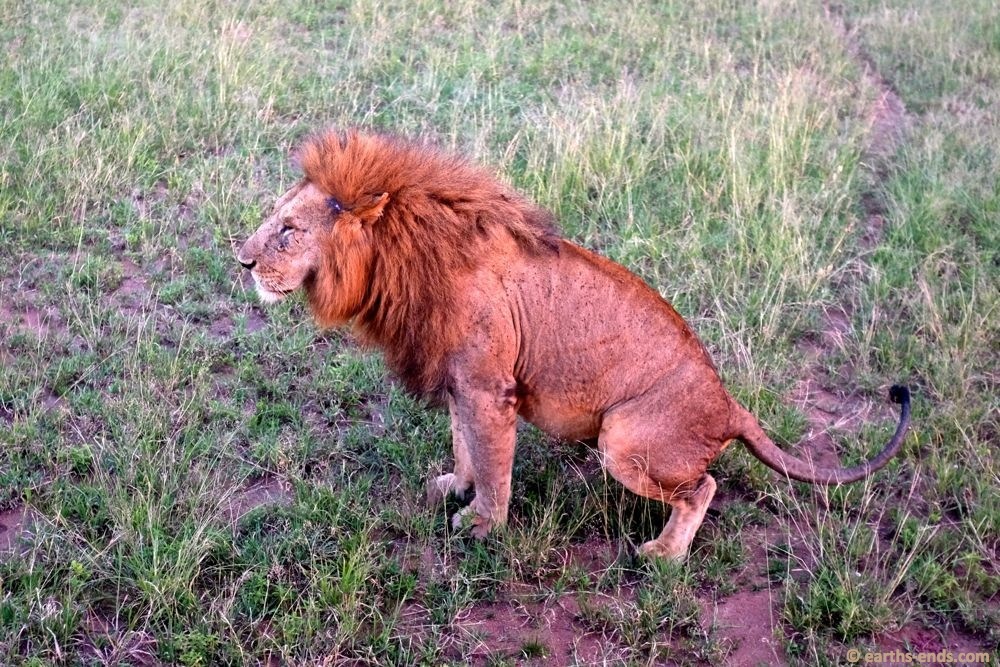
Lion on the Job – We were up wind from this and were gagging at the smell. Seriously it is like the devil ate the worst smelling shit on the planet then shat it out himself. Lions create the most awful smelling poo as they exist on a full meat diet. Something to keep in mind when someone tells you how awesome their Paleo diet is going.

The animals are so used to the tour cars you can get pretty close

The big boy
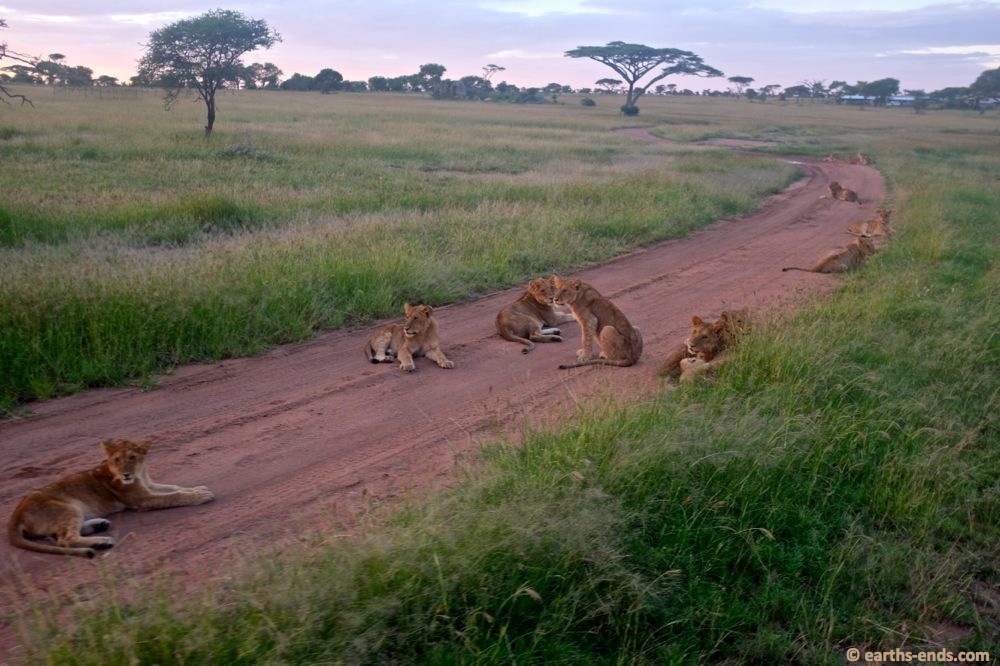
This pride was less than 600m from our unfenced campsite
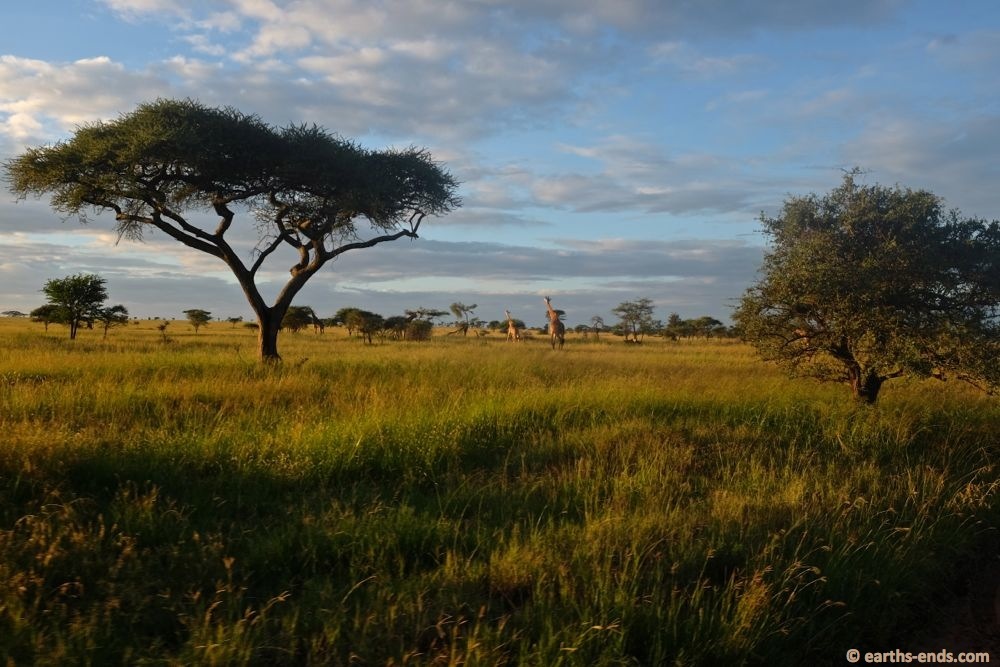
Classic African scenes
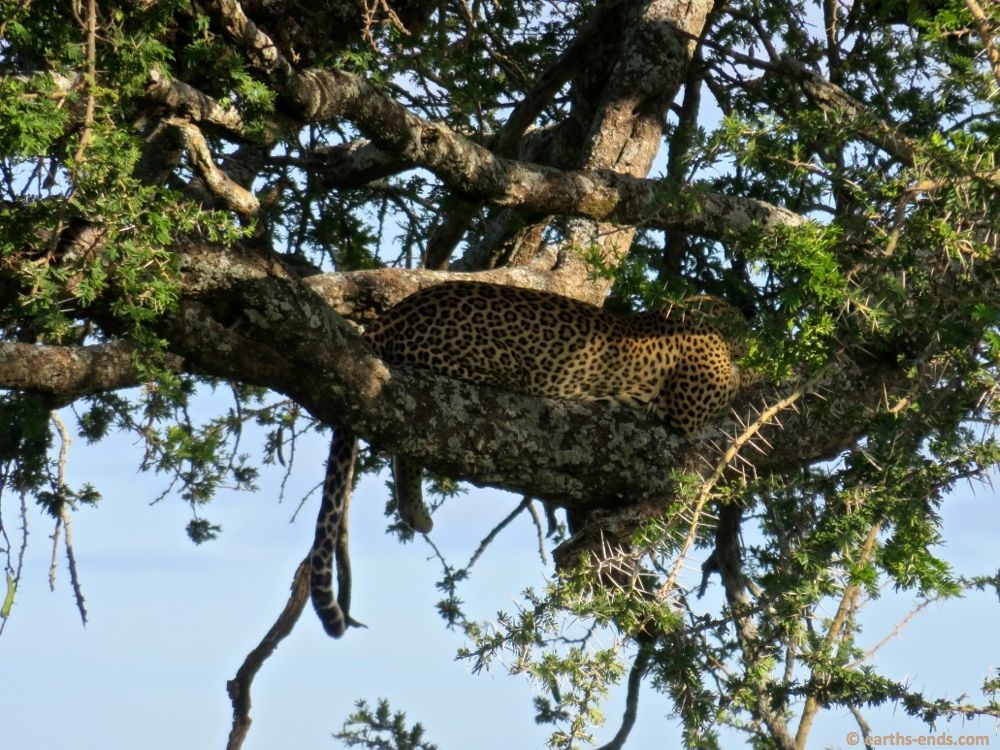
We saw a leopard in a tree

With two of her cubs
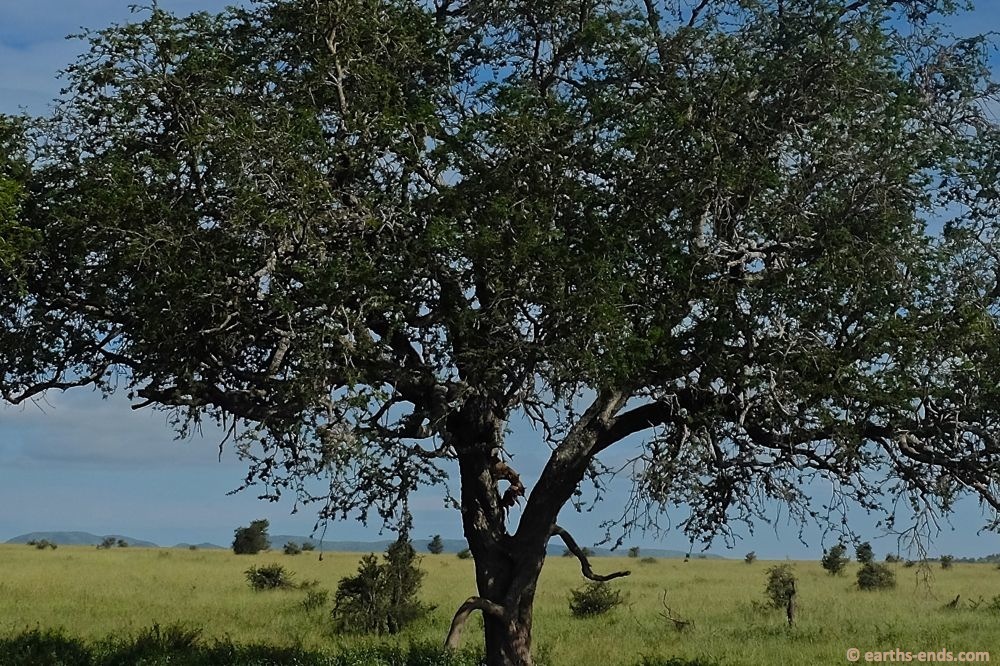
And she had a kill in the tree with them
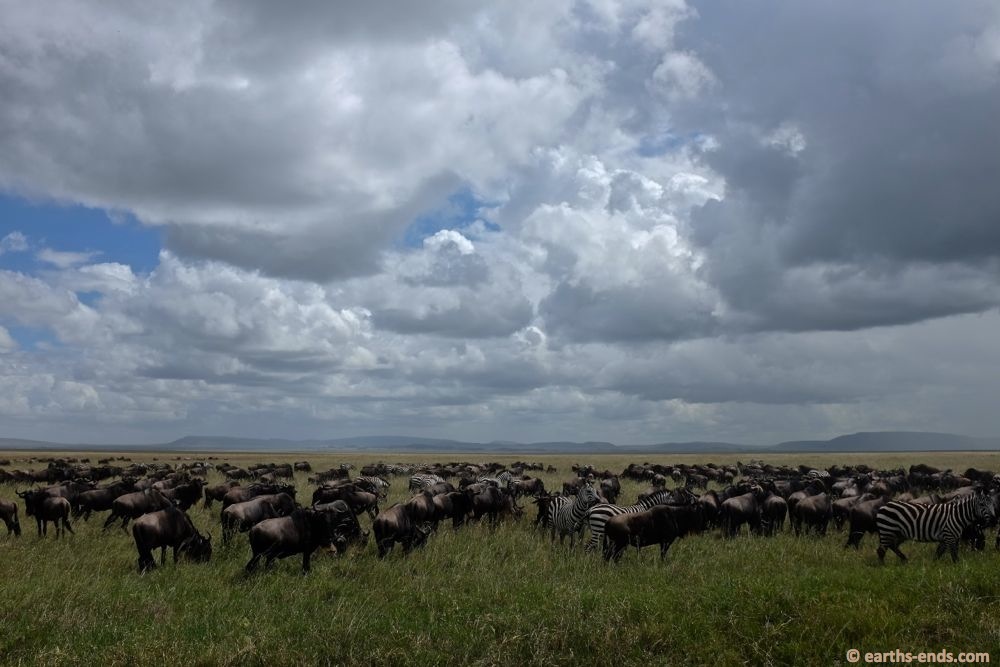
The plains of the Serengeti were full of zebra and wildebeest. The Zebra stick with the wildebeest as they are the experts in following the rains. The wildebeest benefit from the zebra as they eat the longer grass, which allows them to follow and eat the shorter grass. We were told that during the great migration 7.8 million animals are on the move. So many that you can barely see the grass. Just a sea of wildebeest and zebra…all heading in the one direction. We think we might just have to return one day to witness that.
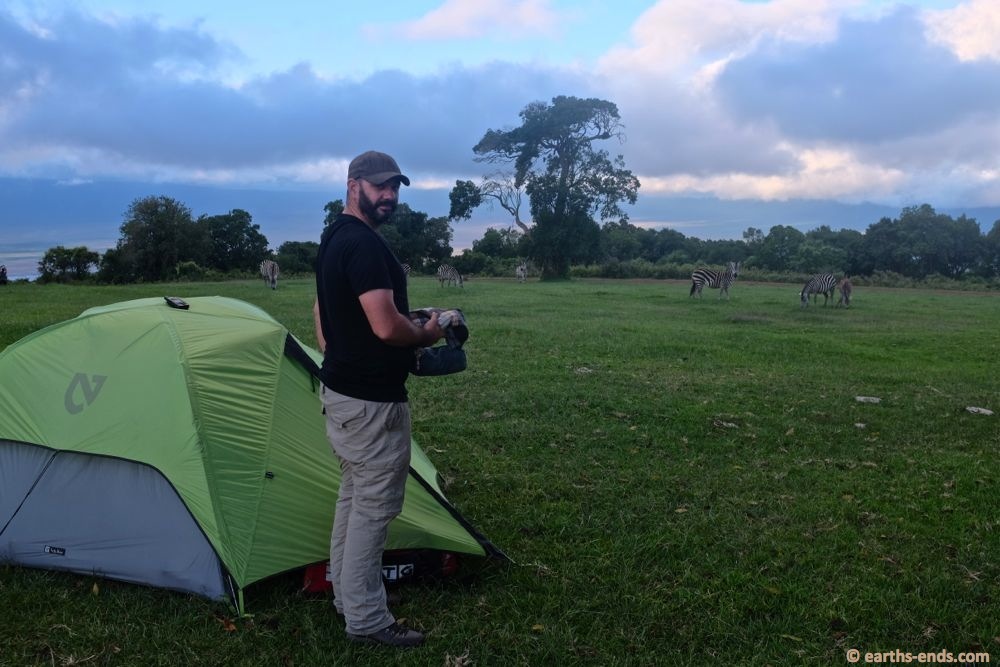
Setting up camp among herds of zebra on the rim of Ngorogoro crater. Soon after the photo above we had a heard of buffalo invade the camp ground. I had to hide in the toillets until they were cleared away. That night however we woke up to the sounds of buffalo eating grass around all the tents. We could hear them chewing and breathing. It was not a good feeling as buffalo are extremely dangerous when they become alarmed. We managed to get back to sleep but woke to a commotion, lights and shouts at about midnight. We assumed it was the guards chasing off the buffalo for getting too close to the tents. Not so….they were chasing off the lions that came and started hunting them RIGHT AROUND OUR TENTS!!!!!! I was glad it was our last night camping in the parks and that I didn’t find this out until the morning.
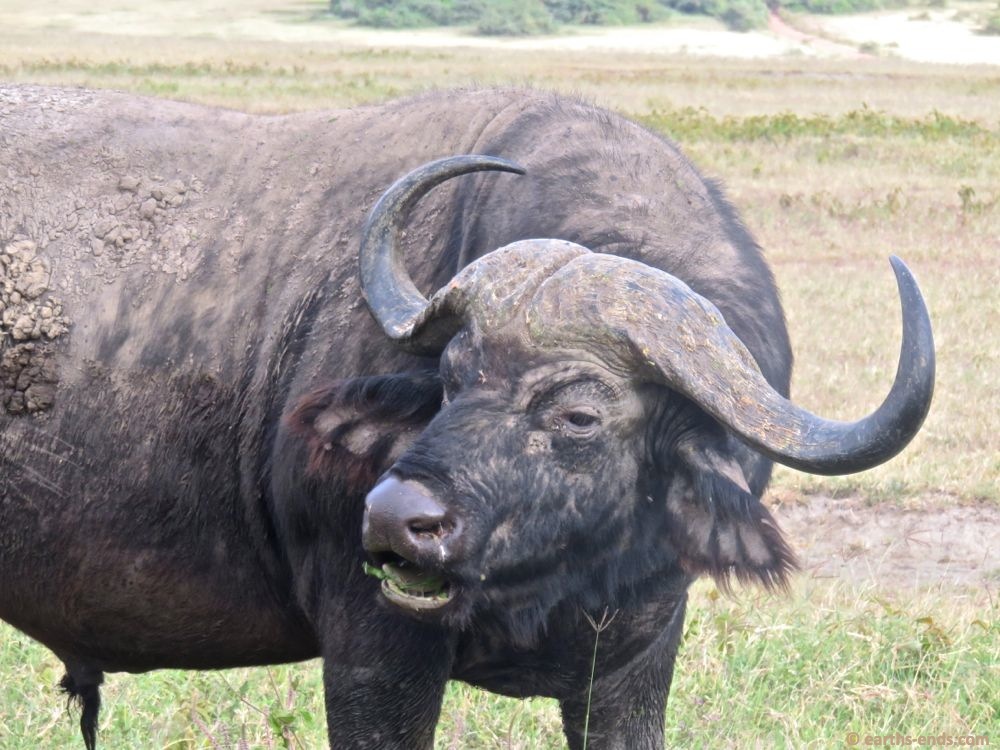
Here is one of a herd of old buffalo. When a buffalo gets old or injured they are kicked out of the herd as they attract predators and make the whole herd unsafe. So they try to protect themselves by making a herd of geriatric buffalos. I imagine they spend most of their days being nervous and complaining about ‘kids these days’ and their rheumatism acting up.

The crater is the world’s largest unbroken, unflooded caldera in the world. It’s 20km across, 600m deep and 300km2. This natural protection of a steep crater with just 2 roads in and out makes it one of the few places on earth where rhino are sort of safe. We got to see this big boy (a black rhino) in the wild. How many people will be able to say that in 10, 20 years time I wonder?

We came across this big group of lion cubs who were left alone with instructions to stay together and stay put by the lionesses that went to hunt an nearby lone buffalo.

While the hunt was underway we noticed this guy in the distance trying to pass himself off as a delicate flower.
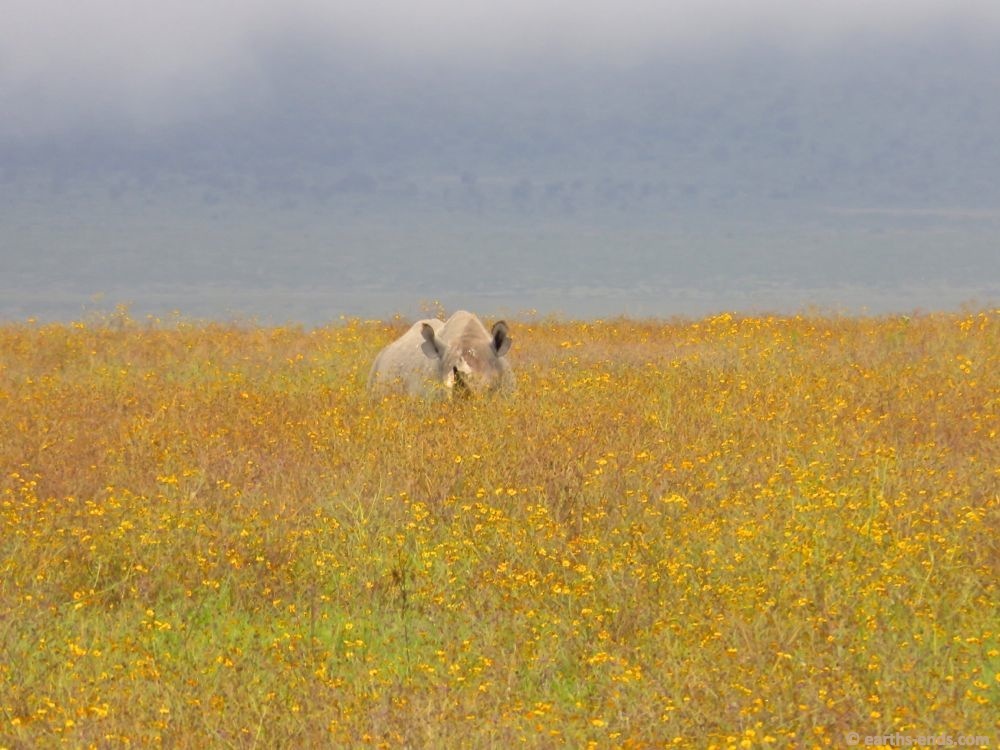
Nice try buddy
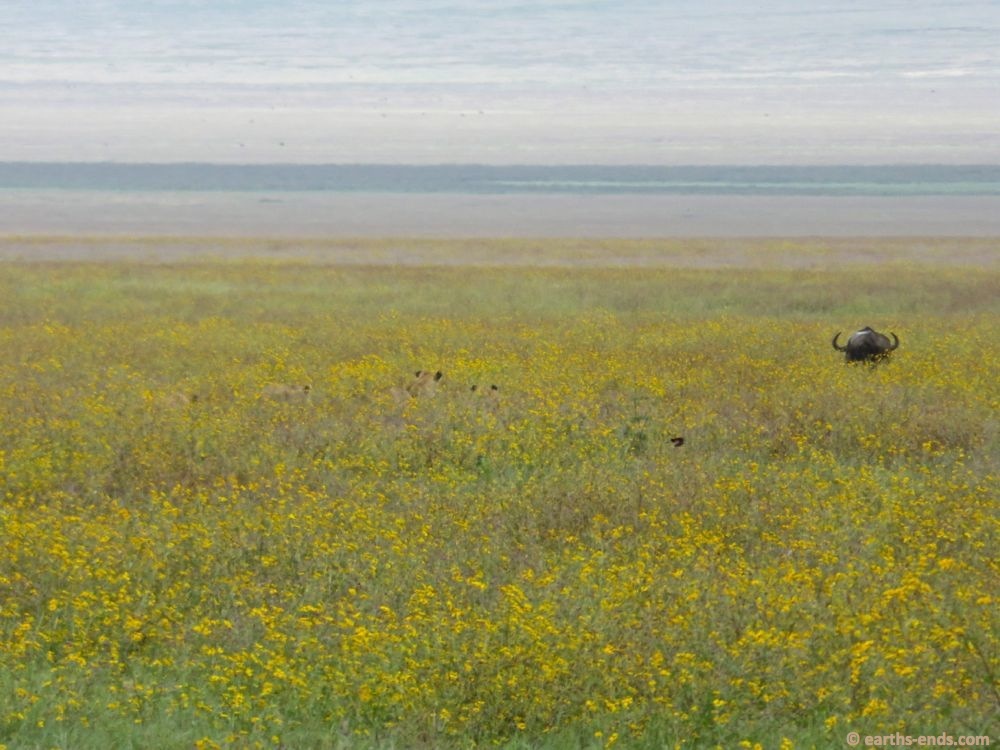
This is how close the lionesses got to the buffalo. At the beginning we were excited and rooting for them to get him. Bu then we watched the moment he smelt their presence and ran in alarm. Then we were wanting him to get away. Which he did. Once he was aware of their presence the lionesses gave up. Buffalo are the most dangerous prey to hunt.

Meanwhile the cubs did what they must have been told and stayed put
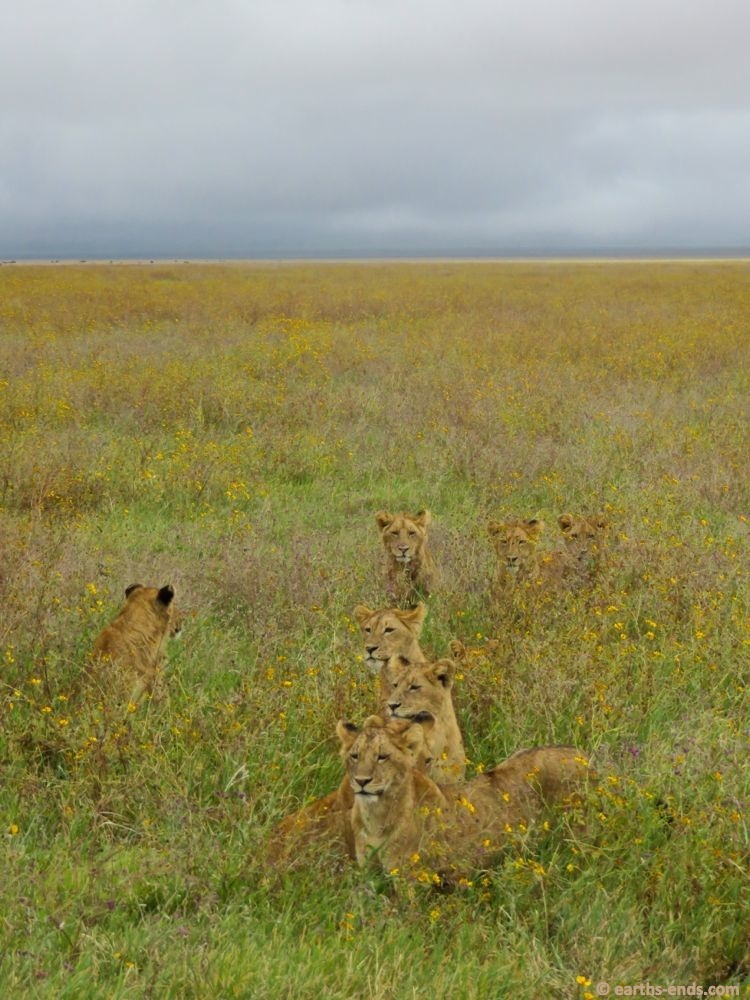
They were gorgeous

Lovely scenes from in the crater. There is such a concentration of wildlife in here. Only thing that is missing is the giraffe. The descent into the crater is too treacherous for them
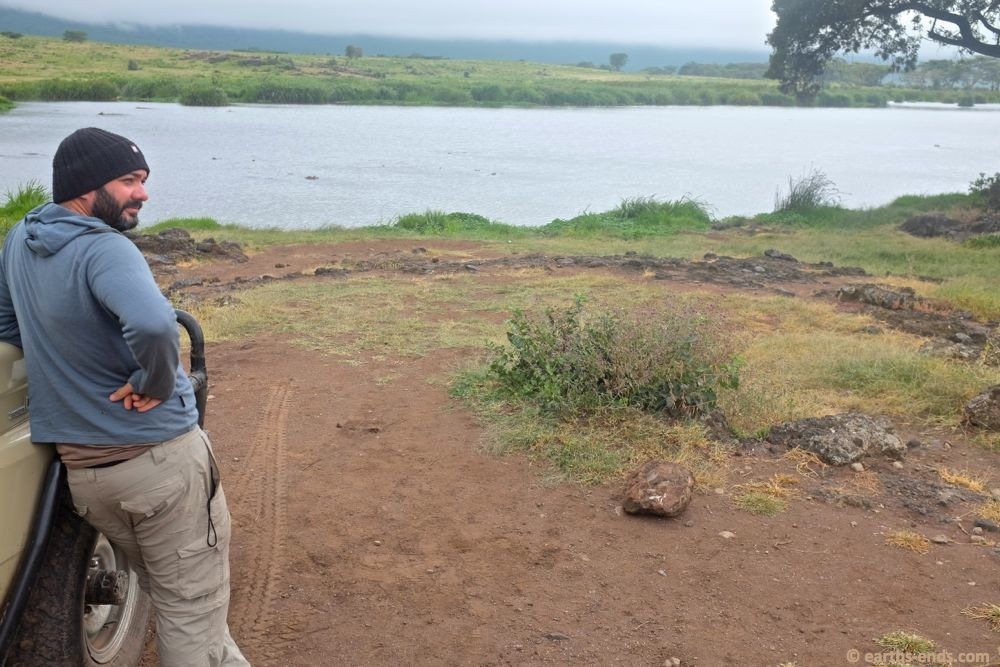
Mick checking out the hippo

Zebra on the run
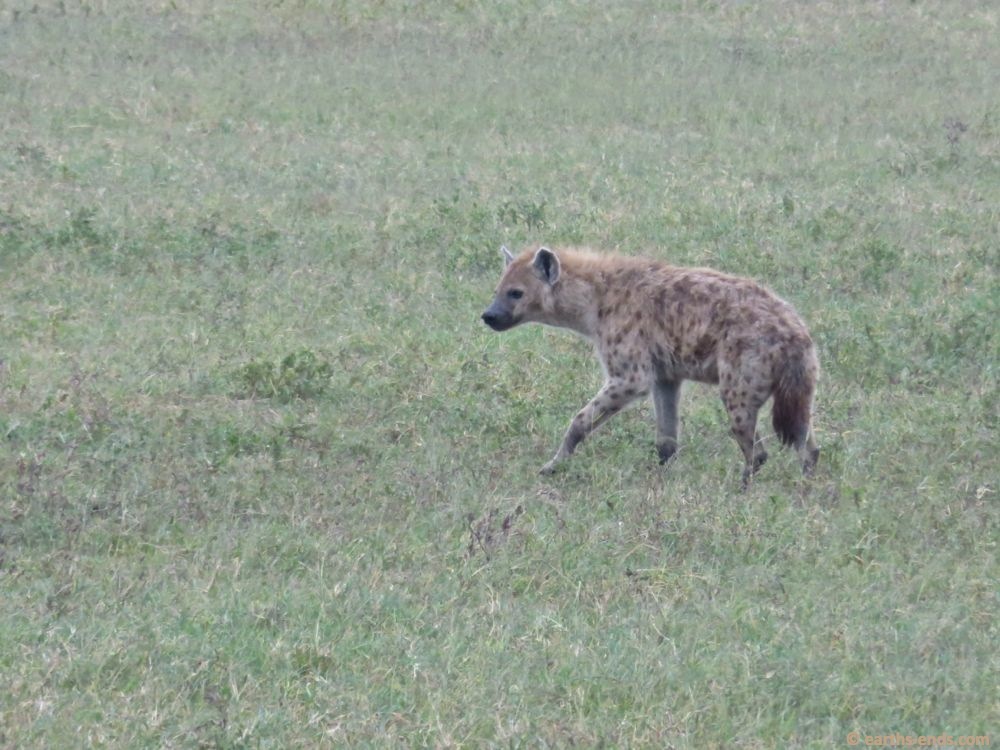
Strangely this was the only hyena we saw in 4 days of safari

It was prime mating time for the wildebeest so we say a lot of these fighting displays underway all to impress the ladies.

A lioness teaching her cub how to hunt
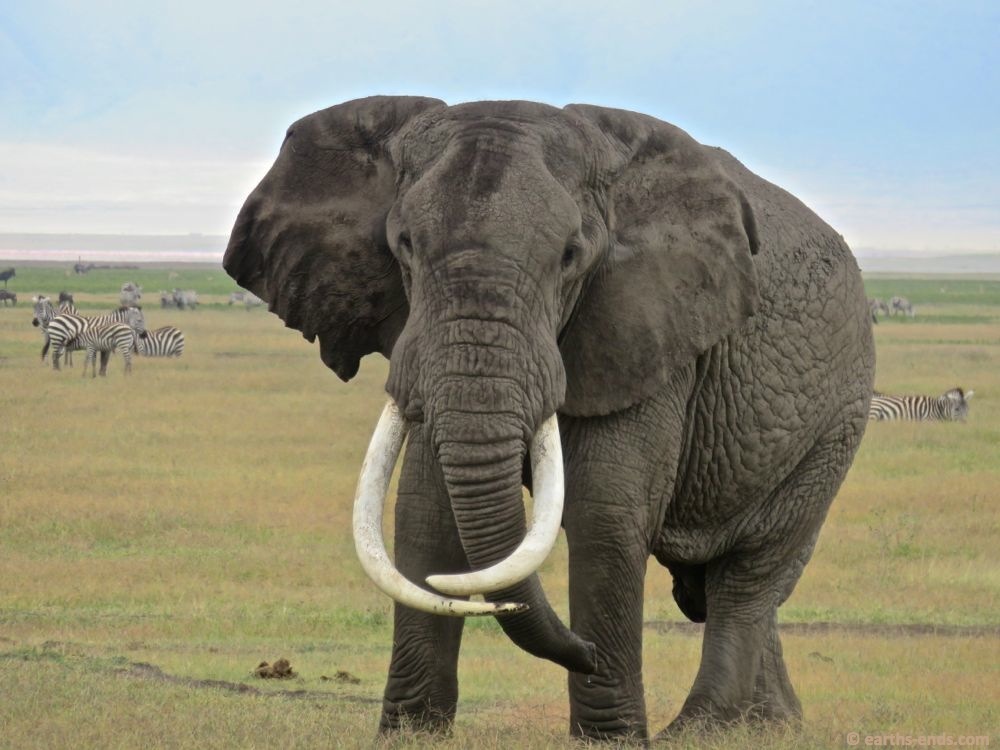
This was the biggest elephant we had ever seen. Looked the size of a wooly mammoth. With tusks like that lets hope this big boy stays in the crater
All up our safari experience was excellent and we were extremely glad we did it. It made for a pretty relaxing 4 days where we didn’t have to organise or thing. We got waited on had and foot and fed possibly too well. For us the Serengeti was a clear stand out from any other park we had visited in Africa. Really it made Etosha look like a petting zoo. The size and scale of the animal life there was immense. Seeing plains full as far as the eye could see of hundreds of thousands of wildebeest and zebra was a positively humbling experience. As a person in a 4wd you couldn’t help but feel rather insignificant in the grand scheme of things. And knowing that the herds of animals had been migrating to and fro from the Serengeti to the Masaai Mara for millennia upon millennia, predicting the rain more accurately than anything yet created by man it made you feel like perhaps mother nature knew what it was doing far more than we did. I think everyone should try to visit the place once in your life. And for people travelling through Africa I would recommend you resist the urge to visit any other park on the continent. Save you cash and put it toward a horrendously expensive though undeniably worth-while trip to the Serengeti (or Masaai Mara – the two are connected and essentially the main park just on the other side of the Kenyan border.)

Blog 38 by Tan: A Market for the Larger Woman
While Mick slept and sweated and shivered with fever I tried to decide what to do with him. He maintained he didn’t want to go to a hospital that night and just wanted to sleep. He was rocking a 39.9 degree temperature and was too hot to even sit next to in bed. I got in contact with Pete our doctor friend from South Africa about whether Mick could wait until the following day to get tested for malaria or whether I should get him to a hospital now or whether we could start him on the anti-malaria treatment we carried with us. Pete tried his best to advise us but was in the middle of a 3-day mountain bike ride from Sani Pass in Lesotho to the sea – typical South African doing something outdoorsy and incredibly cool. He managed to track down a phone and offer advice before the line went dead due to South Africa’s ‘loadshedding’/brown out situation. Thanks Beth and Pete for all your efforts! Not all overlanders have an expert doctor on call. Made us feel as important and pampered at Ewan and Charlie.
Based on the symptoms, Pete thought Mick could potentially have malaria, however a test was necessary as malaria does present early on like a lot of illness; fever, nausea, sweats, diarrhea, headache, muscle/joint soreness along with a general feeling of unwellness. Mick had all of those, apart from the muscle soreness. We had been taking a prophylactic, doxycycline, but we had also been traveling through areas which have malaria strains resistant to doxy (there are strains resistant to each of the 3 common prophylactics; doxy, malerone and larium). We had just been through Malawi and Mozambique right after the wet season, and arrived in Tanzania in the little wet season, all being pretty prime malaria time. Pete advised to get tested asap, however he suggested we could start a treatment if there was no convenient way to do that immediatly. I thought we had a diagnonis kit in our medical kit but its seems it somehow didn’t make the journey, so at about midnight we started a treatment.
After a mammoth 18 hour sleep and two doses of the malaria treatment, Mick was feeling very weak but better and his temperature had gone down to mild fever, only 37.7. We found a foreign medical clinic and got a malaria test done, 2 in fact, and while still unwell and running a mild fever (which would persist for the next day aswell) we were relieved to see he didn’t have malaria, but rather a demon of a virus. It was all very strange as Mick almost NEVER gets sick while I succumb when someone merely talks about illness in my presence. Naturally we were glad and spent the next couple days chilling out and getting Mick bikeworthy again.
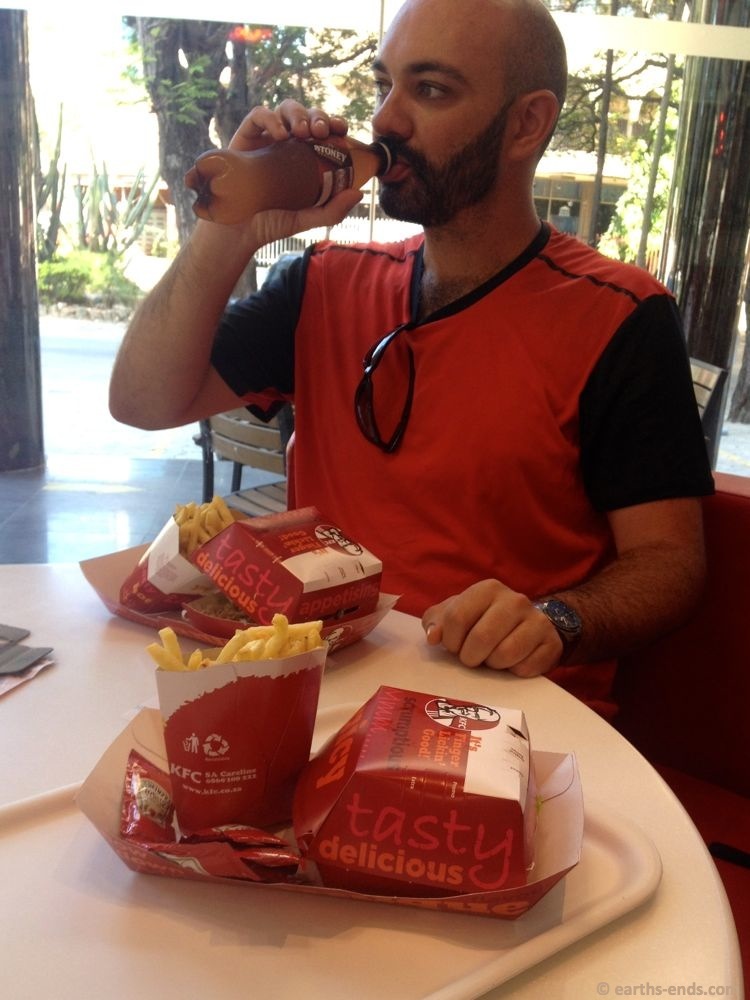
First Dirty Bird of the trip. What a milestone!
These days were spent eating the awesome Indian food on offer in Dar, mooching free wifi from the nearby Holiday Inn and trying to please the highly regimented old ladies who kept the YWCA running like clockwork. We also took the time to be your typical westerners and go to KFC for a feed (our first ‘Dirty Bird’ in a year). We were ridiculously excited and subsequently deflated when the service was shocking and our burger buns were thoroughly stale and we calculated how much quality Indian food we could have got for that price. TIA, baby. Afterward we went to the movies like regular people and watched Mad Max: Fury Road. I learnt that my bike clearly needed to be renamed: She will henceforth be known and Furiosa. After another 4 days, Mick was well again and we were ready to leave Dar.
There were a number of pressing chores we failed to do while in Dar so after an altogether unproductive day we set about getting the hell out of dodge. Dar Es Salaam….. not wanting to sound like a whining first worlder judging the place on impossible standards but …. it is a bit of a dump. I couldn’t fathom its lack of development compared to that of all the developing world and African cities we have been to Dar Es Salaam was officially our least favourite city in Africa. Had we had more positive experiences there would we would have viewed the place differently? Probably.
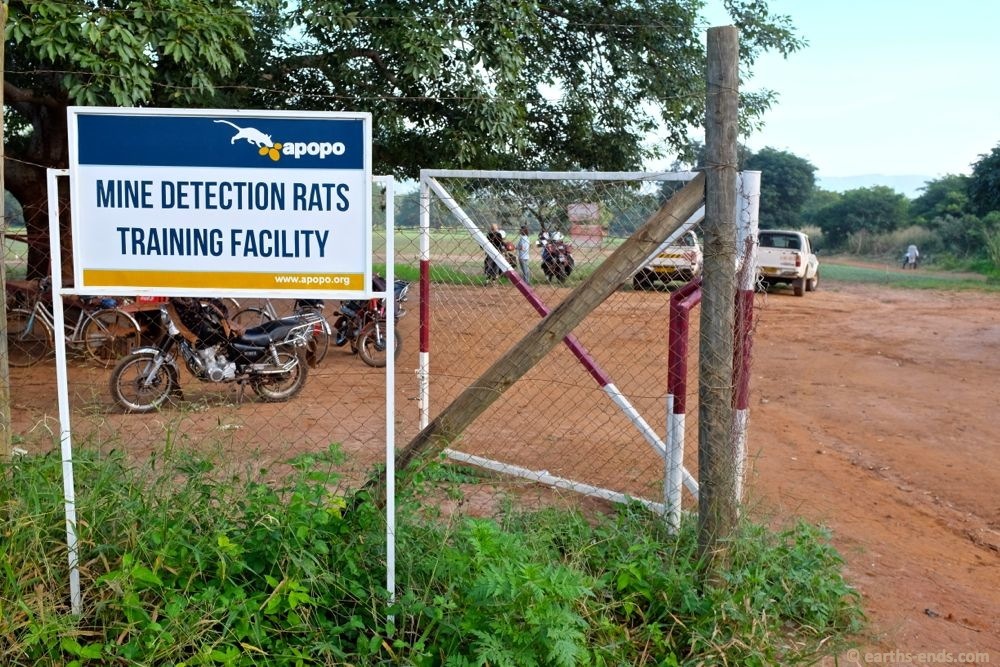
Just gonna stop riding for a bit to look at rats learning to detect landmines – no biggie
Another good reason for leaving Dar was to travel to Morogoro for our appointment to visit APOPO’s land mine sniffing rats. That’s right, we had another rat date. After checking out the TB sniffing rats in Maputo we were excited to drop in on their more hardcore mine sniffing colleagues. The APOPO rat training area is surprisingly large at nearly 6 acres and has 54 rats currently in training at all levels. We learned that it costs about 6000 Euros and takes 9 months to train a rat for mine detection work. The rat can then go on to work for about 7 years so much like the TB HeroRats, their cost effectiveness compared to human technicians can scarcely be compared.
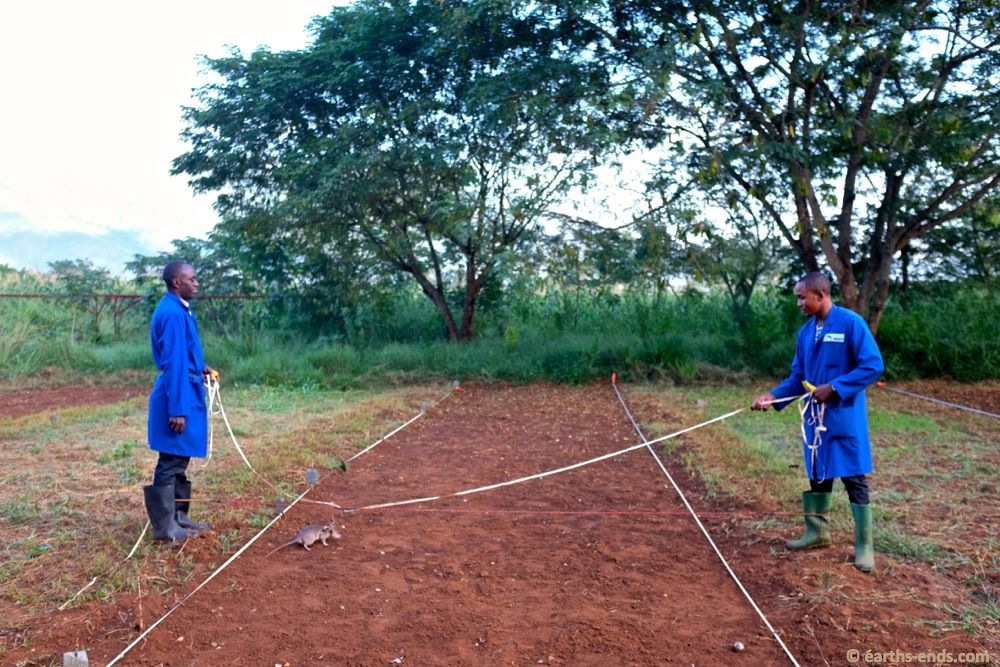
New recruits in the early level training plot. In the bottom right corner you can see a TNT laced ball sitting on the surface
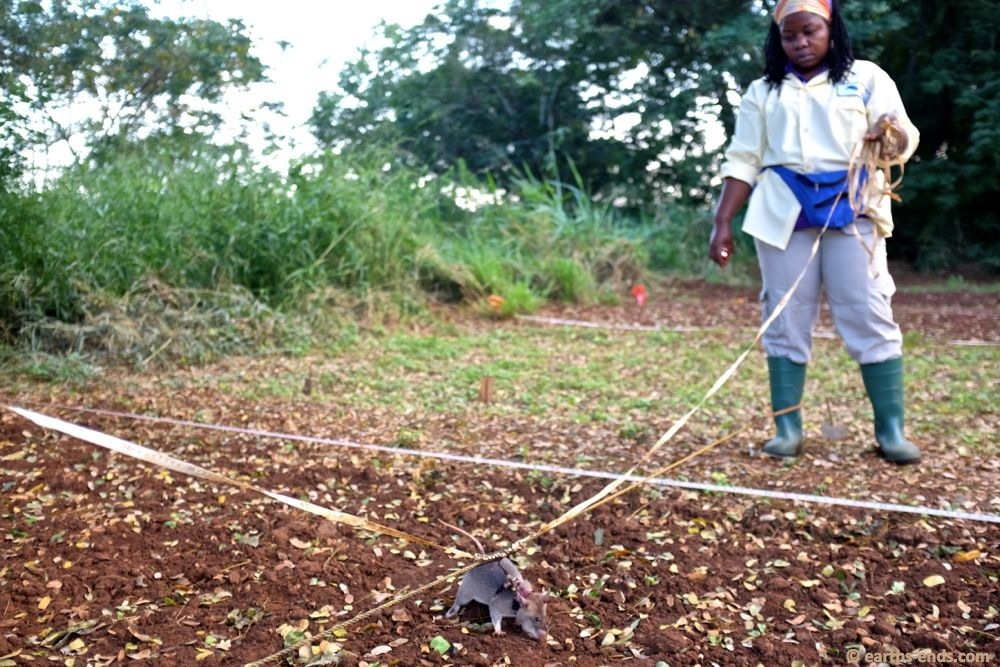
We were amused to learn that the HeroRATs suffer from Monday-itus like us humans and are considerably less productive on Mondays after having the weekend off. Each rat only does about 20-40mins of training per day and all in the morning because they are nocturnal. Anymore training than that and they get tired and unproductive.
The first part of their training is socialisation and getting used to regular contact with people. They then proceed to ‘click training’ where they learn when to receive treats in return for completing certain tasks. From there they go to the first stage of learning to sniff out landmines. At this stage high concentrations of TNT are placed in small round balls that look a lot like tea diffusers and are placed right at the surface of the training plot. From there the rats are given a guide line to travel along and a leash to allow them to work in a focused area sniffing for the balls of TNT. When they positively identify one they get their positive reinforcement in the form of a few bites of a banana.

The rats are Gambian pouched rats which are native to Africa. They are therefore well suited to the conditions however given they are naturally nocturnal they struggle with exposure to the sun and have to wear sunscreen on their ears and tails. We suggested to Ragna our Apopo host that they try to score some corporate sponsorship for the rats from a sunscreen maker.
We watched these new recruits and just like in Maputo we noticed distinctive differences in character and work ethic between the rats. Some were very focused while others would stop mine searching for a spot of grooming or just general naval-gazing. One of them was clearly the class suck up looking for extra credit. All the other rats would simply pause and scratch at the TNT sample however this one would insist on picking up and carrying (either in its hands or mouth) the ball of TNT all the way to the trainer. Every time. It was adorable.
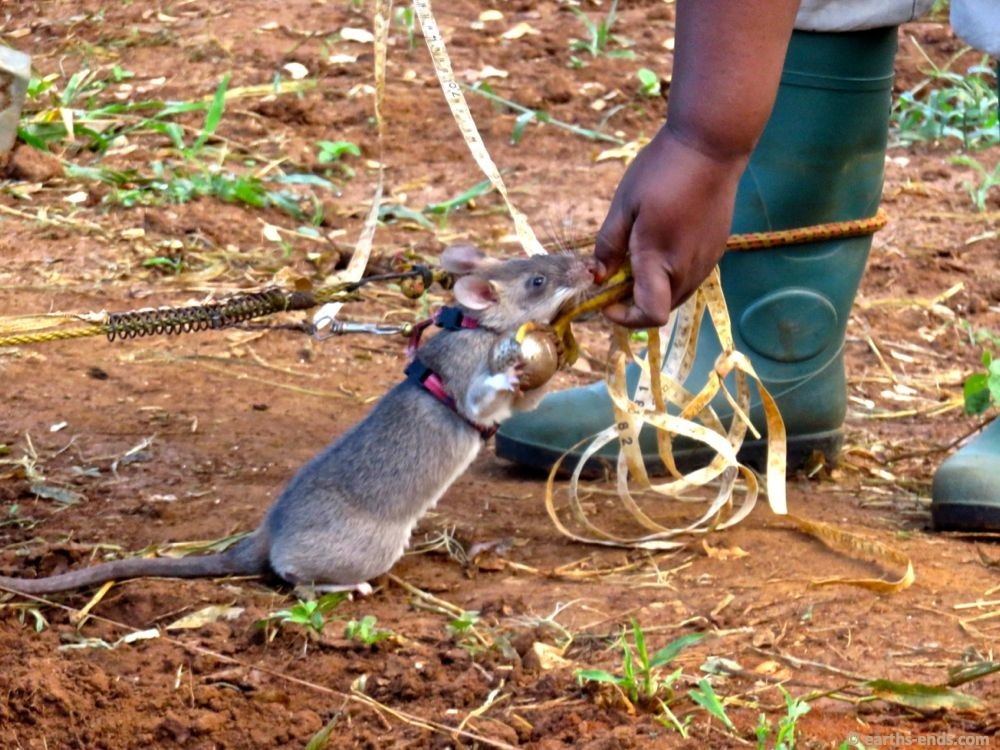
The rat who carried all the balls back to the trainer.

The ‘Ratmobile’- How the HeroRATs are transported to and from work.
The next stages of the training sees the concentrations of TNT in the balls lowered, the balls emplaced deeper in the ground and less balls embedded in the training plot. Towards the end of the training the rats are tasked with detecting real landmines that have been deactivated by the army and emplaced at standard landmine depth (about 15cm) in the field with a few decoys thrown in for good measure. Slowly the rats are weaned off their banana treats as it is impossible to positively reinforce the rats in an active mine field. There, the rats sniff out the mines and then the techncicans will come in and deactivate it. It is therefore impossible to confirm on the spot that the rat has indeed found a landmine and reward them. There is a risk that if they reward the rats without positive confirmation that they could learn fake identifications to secure treats. One thing we heard a lot both with the TB rats and here, is that it is long and difficult to train the rats, and quick and easy to un-train them.
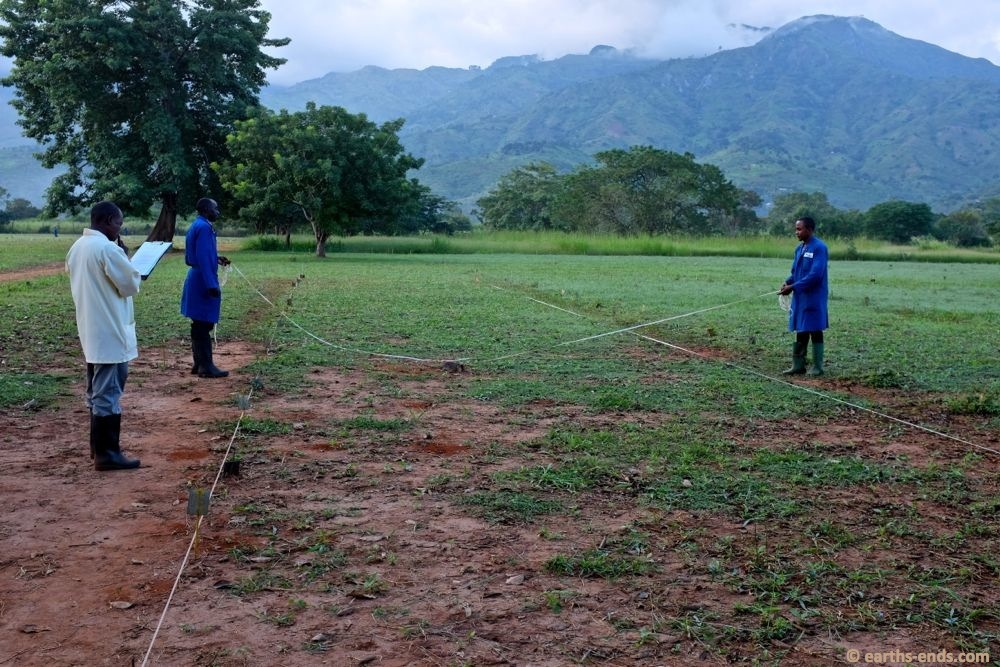
Here is a rat at a more advanced level. No easy TNT balls on the surface for this guy. And no banana treats. As the rats progress in the training more and more attention is paid to their performance.
In order for rats to graduate mine sniffing school they need to be 100% accurate. We were informed that not all rats make the cut and they have a decent dropout rate in mine sniffing school. The dropouts however still stay with the program as breeders and socialising buddies for the more brainy, studious rats. I was hoping that we could take one of the dropout rats to track down my ignition key every morning but APOPO’s goals are far more noble than that.

One of the trainers. APOPO employs local people from a wide background. Some are more educated, some less so – all of them love the rats and take their role seriously.
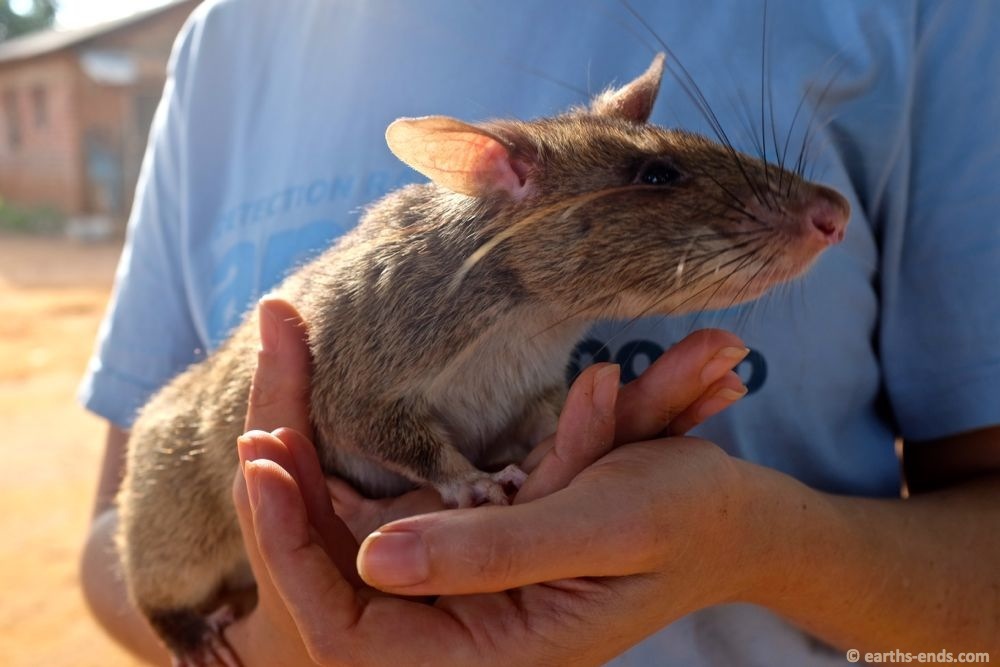
Can you believe this fella can track down landmines like a pro?
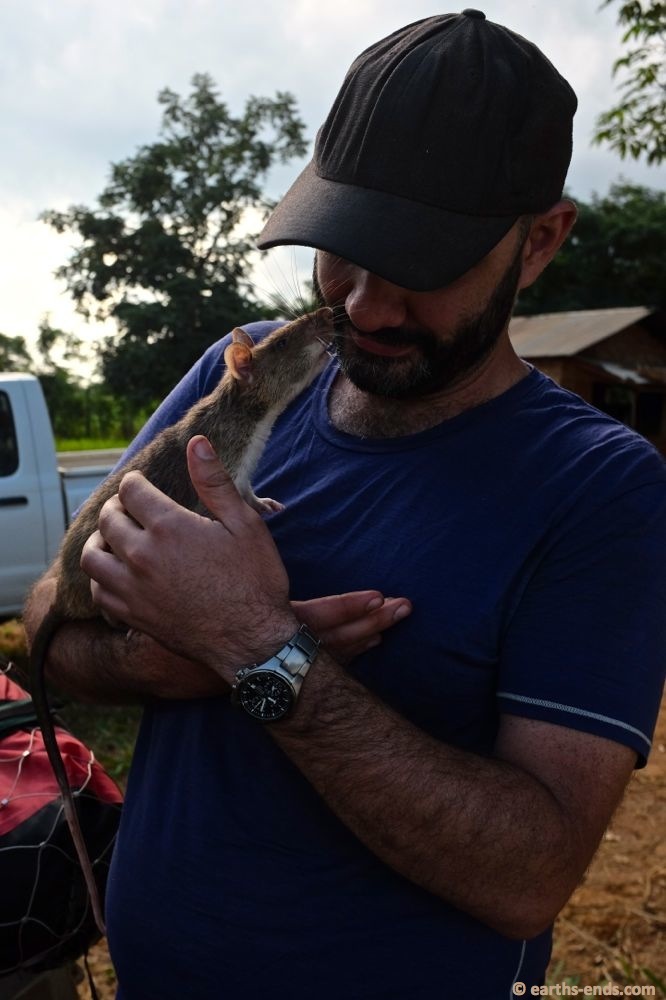
Sharing a moment with a HeroRAT named Chavez
All up the HeroRATS are estimated to have detected and destroyed 13,274 landmines, 28,792 small arms and munitions and 1,142 bombs in Mozambique. Seriously little rats did this! The contribution of the HeroRATS mine sniffing efforts in Mozambique has seen Mozambique go from being one of the most heavily mined countries in the world following their long and brutal civil war to ‘mine free’. On September 17 this year Mozambique was officially declared free of all landmines. It is an incredible achievement. After the civil war it was estimated that it would take 50 to 100 years of Mozambique to be free of landmines. With the help of the HeroRATs this was achieved in 22 years. Bow Down!
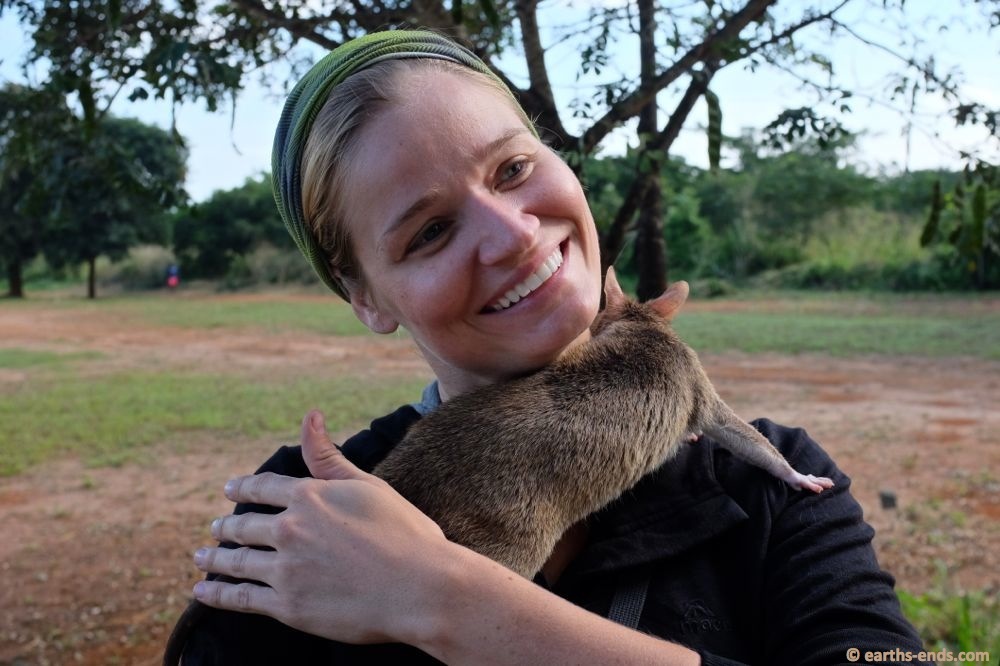
Me too

A perfect companion for the road – “Mick, quick, create a distraction”
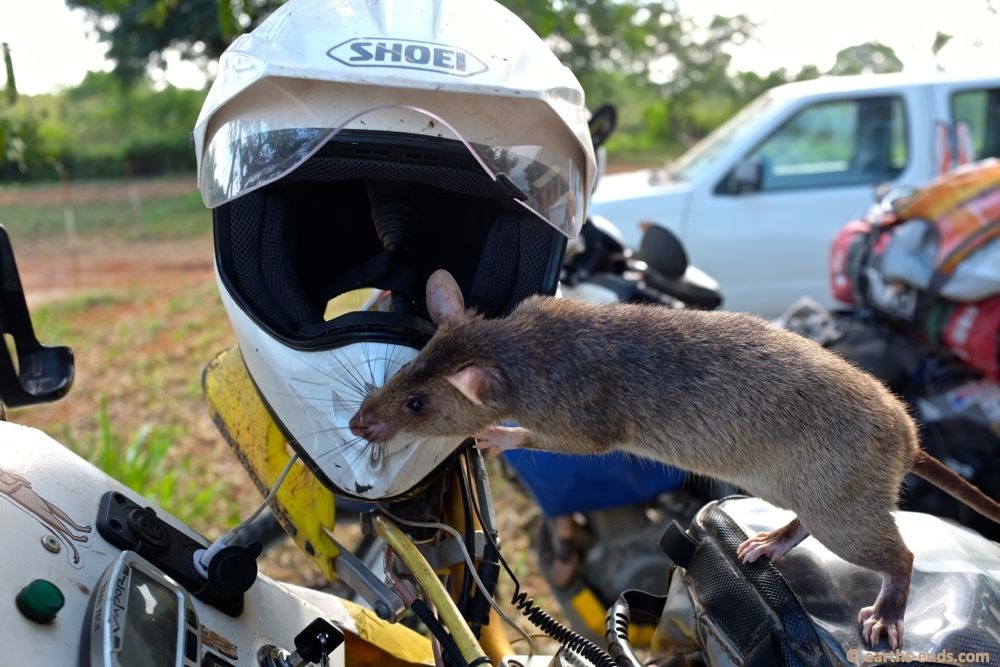
See – he was totally down for it
With 11,124,446 km2 cleared of mines and returned to communities in Mozambique it was time for the rats to go global. Currently there are just under 40 mine detection rats on active duty in Angola – another poor African country littered with landmines following a drawn out “civil” war. And at the time of our visit 16 rats had just made the journey to Cambodia and were waiting on final approvals to get cracking on clearing Cambodia’s landmines. The HeroRATs are particularly helpful in Cambodia as traditional methods of landmine detection (metal detectors) are not fully effective as a lot of Cambodia’s mines are homemade from bamboo. This has no effect on the HeroRATs as they are trained to detect TNT and not metal.
We had an excellent time seeing them in action and were once again awed and excited by the nearly endless opportunities for these rats to be trained to benefit people all over the world. Once again we recommend people to check out APOPO (www.apopo.org) if you are interested to know more. Its also worth your time to ‘like’ their awesome Facebook page which is full of entertaining stuff, cool information and even the odd touching eulogy for HeroRATs that have passed away.
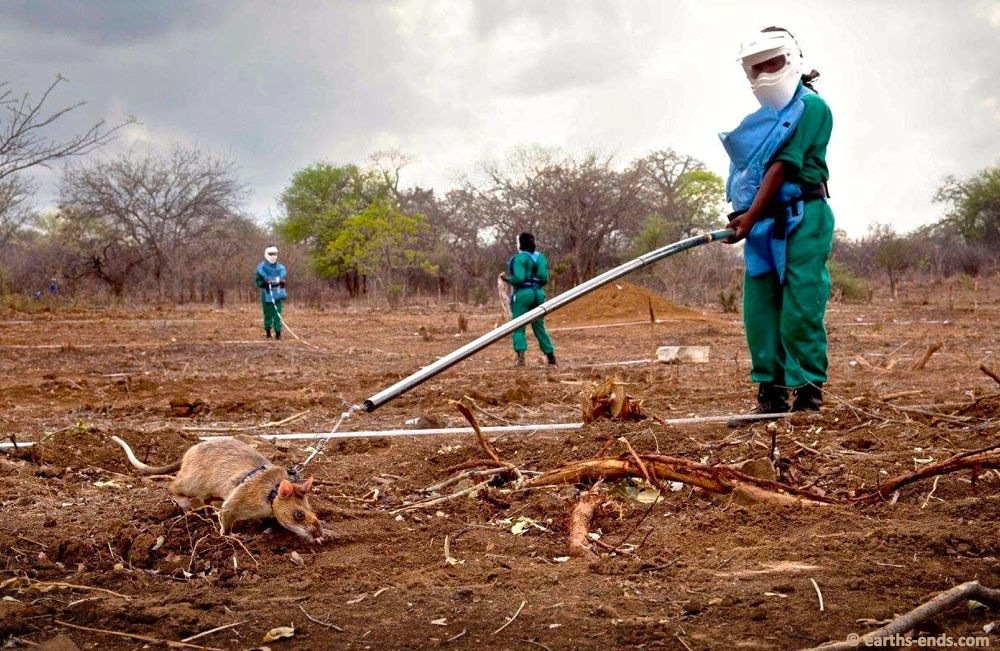
One of the photos from APOPO’s website showing the HeroRATs in a real life minefield. This is what the rats are training up for.
On a high from our super interesting visit with the rats we got on the highway towards Dodoma but we soon turned off towards Hadbeni. Our elation at being on a quiet dirt road with no buses was short lived however as it was full of huge, rim-dinging potholes. It was the worst type of off-road – slow and boring dirt with constant worry about the rims and pinch flats. No fun to be had. Just when we were thinking we couldn’t win in this Goldilocks of roads scenario (‘this roads too smooth’ – ‘this roads too rough’) the road thinned out and became a heck of a lot more enjoyable ‘(it was juuust right’). We were able to pick up the pace and enjoy the winding dirt track through lush and fertile farmland. We stopped in a small village for a cold drink and snack but when we tried to get going again my bike protested. I’d been having issues with my starter motor getting ‘stuck’. Usually I’d just put the bike in gear and reef backwards of the handlebars and that would be enough to get things unbound. I did that a bunch of times but no love. The next step was to give the starter a good whack but again nothing happened.

Finally away from the traffic
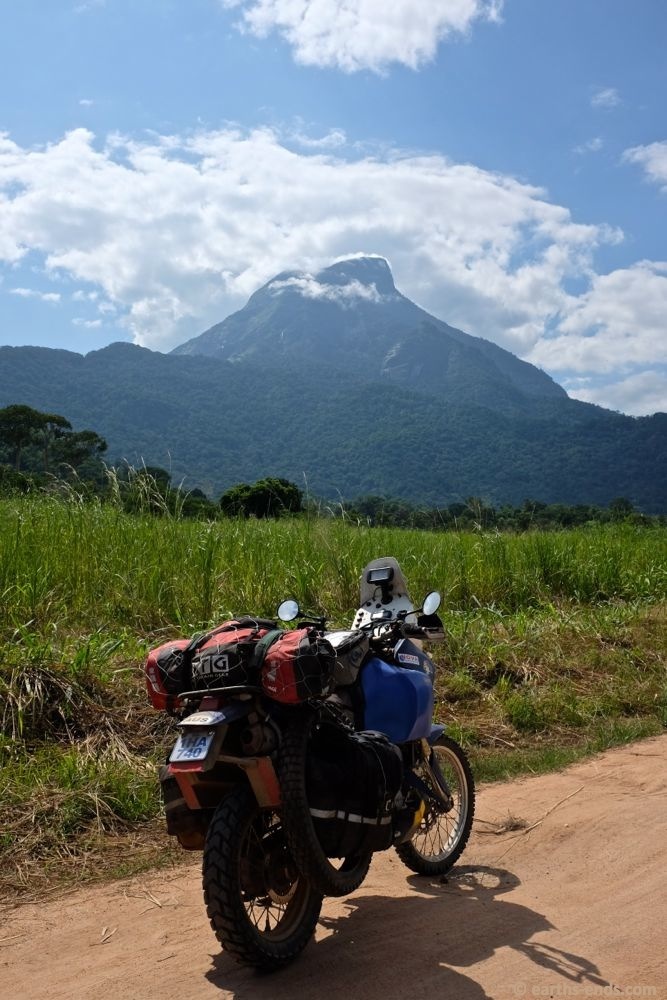
And the views weren’t half bad

Traffic of a much more tolerable variety
People in the village up until this point had been controlling their interest in us visitors until the point that tools came out. From then on it seemed every man and his dog was there to watch the mzungu fix his woman’s ‘piki piki’. It was extremely disappointing as Furiosa (formerly Juhna) had been so mechanically faultless until this point. Heads up to motorbike travellers out there: be aware that the fear of a larger more complicated problem can have momentum. Your subconscious fear of a logistically challenging and complicated, expensive fix and will move your mind in the direction of this fear. The small more likely scenario will be looked into but all too soon abandoned. That is what happened in this case.
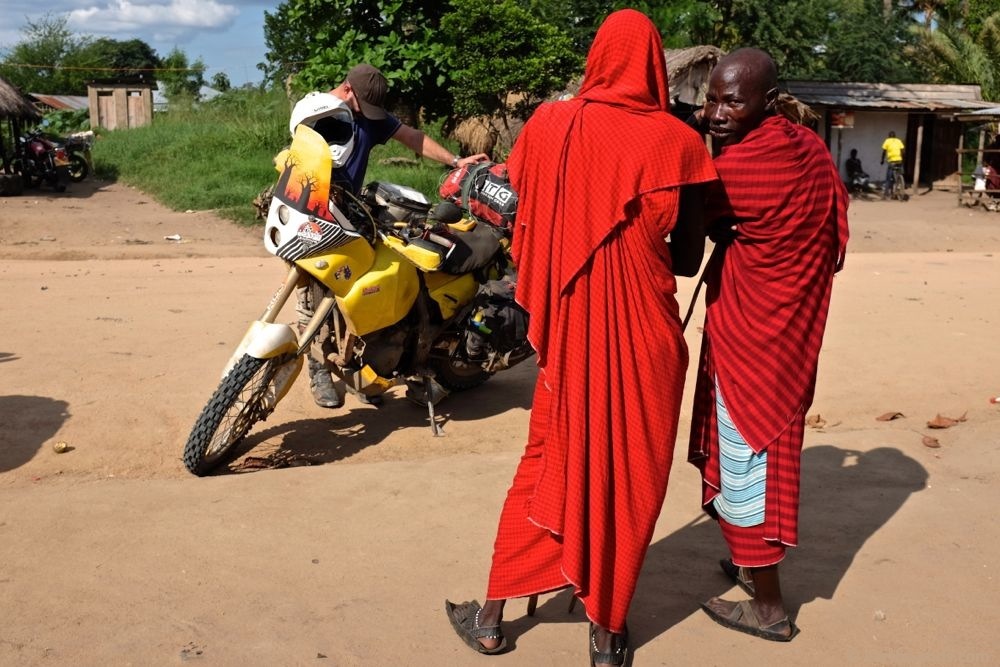
We were the most interesting thing in the village at that time

Here is Mick doing some quality mechanic-ing. You can see a screwdriver in one hand and a chunk of wood in the other
We knew that the starter motor had been getting bound up and needed to be taken apart and cleaned at some point. We KNEW that. And we knew that a jockeying of the thing had been sufficient to get it going in the past. After just a couple of attempts of the usual fix we managed to convince ourselves it was something bigger and more sinister and made a mental shift to this affect. Further multimeter readings led to things not making sense but after a bunch more testing he determined there were volts at the relay and then on the other side too, and at the starter itself. Everything pointed to the starter motor simply being stuck. So after a bunch of time unpacking the tools, tinkering and testing, then getting the bike back together and packed we pulled back in gear more violently and the thing started. It was a waste of time for us but the people from the village were enthralled so it wasn’t a total loss. Disassembling and cleaning my starter motor was therefore on the agenda for next maintenance day. The good riding continued all the way to Hadbeni where we found a hotel and had our first hot shower in weeks and our first in Tanzania. It was all very exciting.
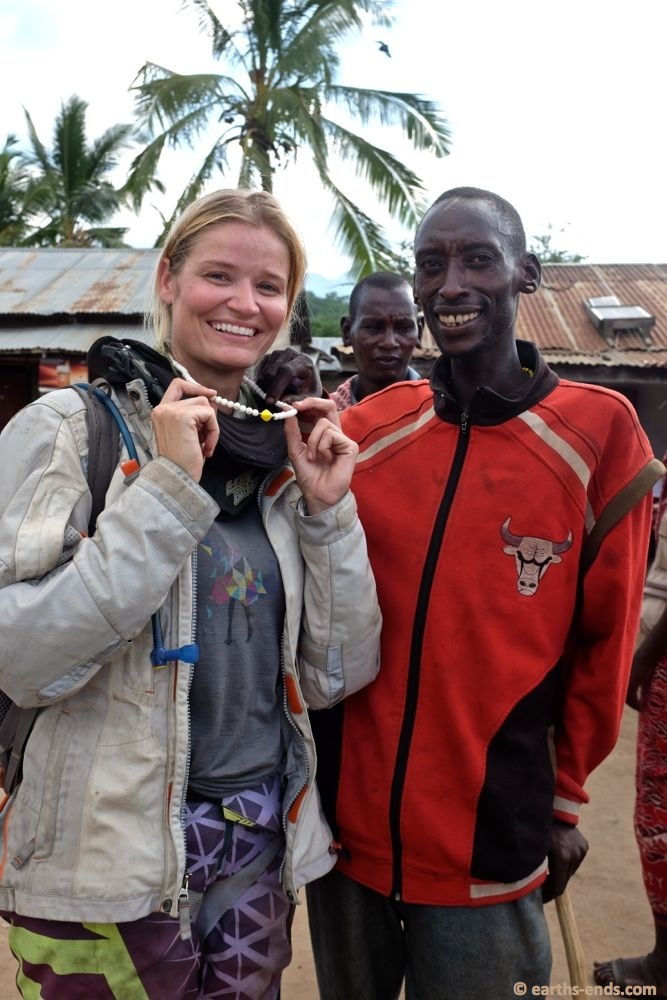
This guy came up and asked me if I wanted to buy his necklace. I said ‘yeah, fair enough’.
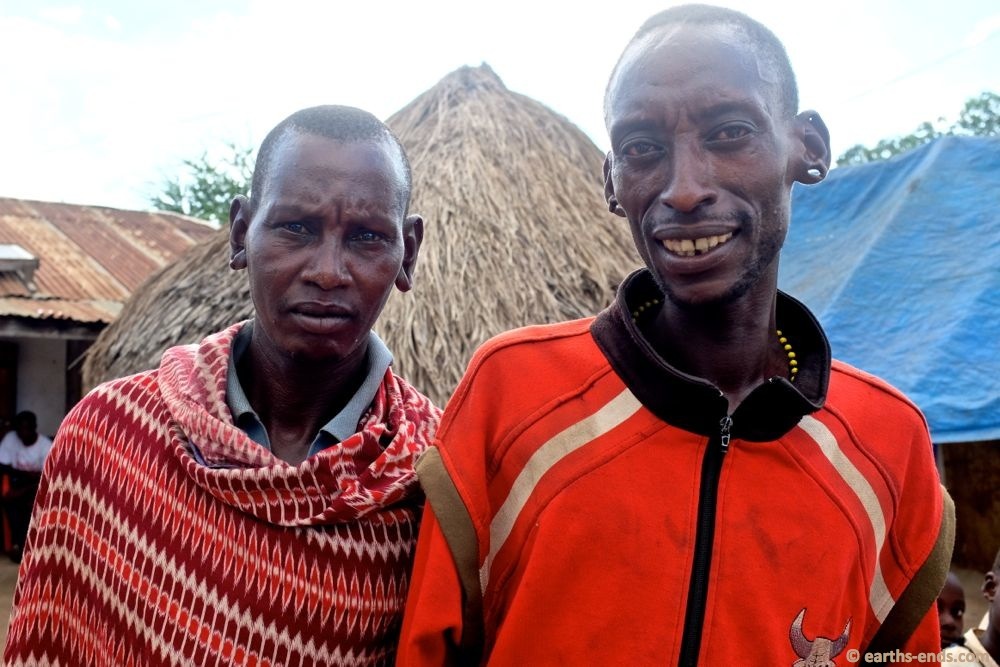
My necklace salesman/former owner and his friend
The next day we once again found ourselves on some great dirt roads through picturesque countryside. We could see that there had been lots of rain recently as the track was quite chopped up in parts but it was dry for us bar the odd puddle. Despite our GPS showing us an area of nothingness we in fact came upon small villages every 20km or so. Not too surprising when you consider the population of 49.3 million in Tanzania and the fact that Dar Es Salaam, the largest city, only accounts for about 4.1 million of that number. Tanzania’s population is overwhelmingly rural and quite dense, Tanzania is about 10% smaller then South Australia (which is about the same size as Texas and New Mexico combined).
But we weren’t in the Maasai Steppe proper yet. And to be honest we didn’t really know what to expect. Tracks4Africa showed no roads through the Steppe and our Michelin map only showed a few roads connecting the major towns. Checking satellite photos on Google Earth Mick was able to see tracks going all the way through the steppe and on to Moshi, our next destination. We knew the roads were there. We just didn’t know their condition. Only one way to find out then.
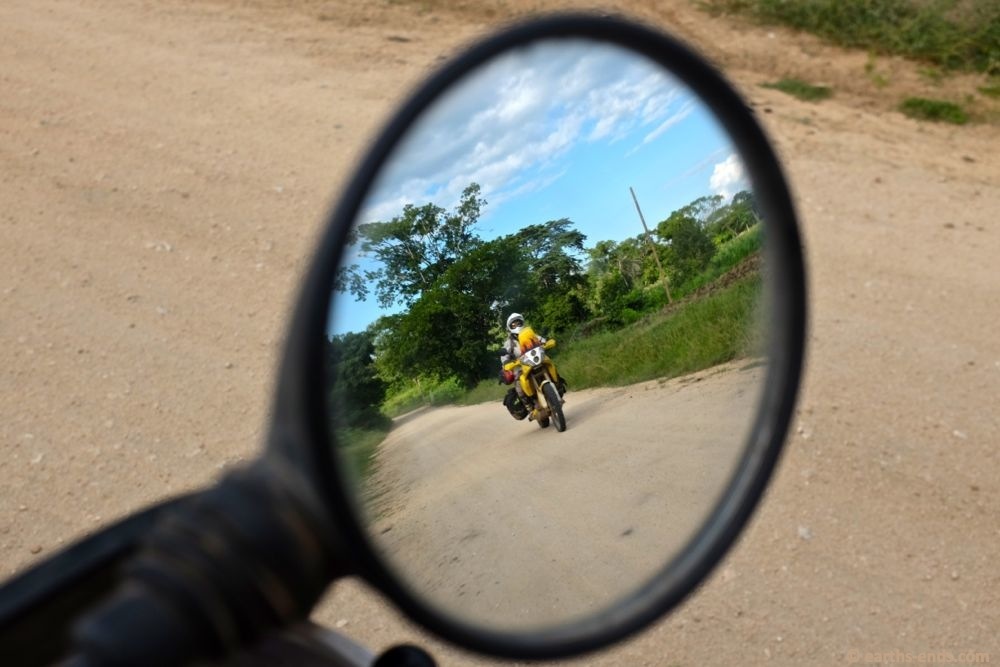
Getting creative with the camera
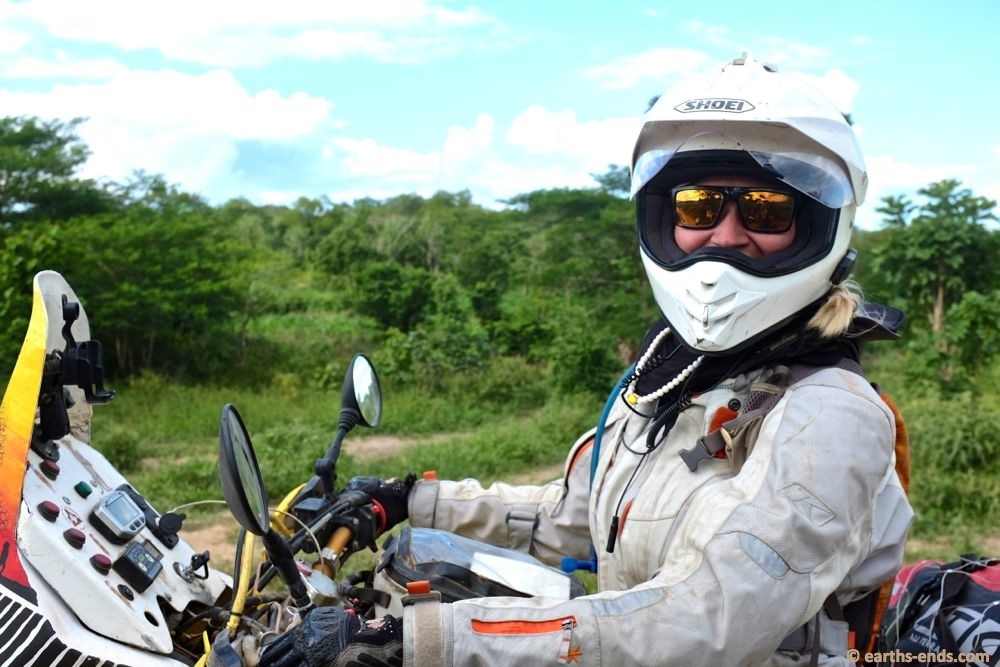
Woman + new jewelry = Happy (got that Mick?)

Some of the nice dirt roads we were riding
As we continued on our way we came across a police officer in one of these middle of nowhere villages. The friendly copper was curious about what we were up to all the way out there. When Mick replied “to look, for tourism”, he burst out laughing. From there the road improved and became nice gravel allowing for speeds of 70-90kph. I was trailing Mick when I noticed a group of young maasai guys waving me down. They were obviously keen for a chat and I was happy to oblige.

The shopping spree continues! We don’t buy much in the way of souvenirs but I really wanted a maasai fabric to send home. We got it in this remote village for a pittance compared to the sky-high prices quoted in the tourist towns

‘Whoop whoop – Michael let me buy things I want yet don’t need!’ Also please note our awesome new ATG bags!

Fast gravel
They were an interesting group of kids there were curious and keen to talk but were far from fawning over us. They had a cool air and quiet confidence and wanted to know where we were from and where we were travelling to. One of the boys spoke English quite well. He told us how they are happy to have visitors and how they looked so forward to increased development in the area. They were eager for improved infrastructure, especially roads, improved communication and transport and better education; their words.
These young maasai men articulated what it was that they wanted and I couldn’t help but smile and think about a personal peeve both Mick and I have about some tourists that complain incredulously how they came all the way to see traditional (insert exotic cultural group here) and they all have mobile phones – like how dare they! Didn’t someone tell them they are there for our entertainment and to be the exotic specimens posing in all their cultural regalia in our holiday pics from the one trip to Africa we might deign to make in our lifetimes?

Our young maasai friends keen for a chin wag

They were happy to try the bikes on for size
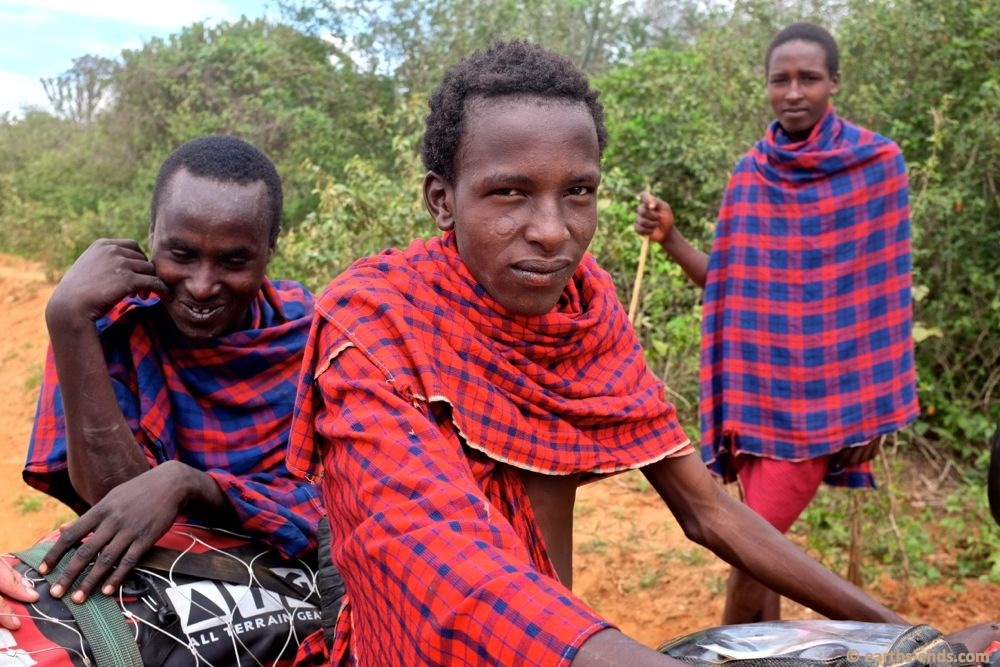
This fella knew how to pose
Many tourists that come to Africa seem to romanticise ‘tribal’ life when all I think when I visit places where people are living as pastrolists like the masaai and the Himba is ‘By God that looks hard….too hard.’ Typically they are the same people that turn near homicidal when their accommodation’s wifi is down. Its bloody funny. The developed world doesn’t have a monopoly on progress. Less well off people want it too and they have every right to it. These kids were a perfect example of that. It was great to hear that they knew what they wanted – things to improve their ease of movement, access to medical care and education and communication.
Mick and I seek out isolated and horrendous trails, the more remote the better, not only for our own personal riding amusement, but also due to the fact that it’s in the remote less traveled places we see the most interesting thinngs, meet the most interesting people and have our most genuine interactions. Yet it never escapes us that to these remote routes we covet restrict the lives of the locals stuck nearby. It makes travelling difficult, family less often visited, access to emergency care harder and the cost of goods higher than they need to be for people that are poorer than they ought to be. It is also why we have extended our time in Africa. The tough routes we so love are getting paved at break neck speed due to ready loans and the presence of prolific Chinese road builders in the continent. If we want to see them the time is now. Progress is inevitable and it waits for no man.

The English speaker and development devotee

The guys informed us these scars are not from a blade but a ‘brand’ that burns the marking into the skin. They said it was something they did as a personal choice. Some got it, some didn’t.

The boys shooting the breeze

While all this was happening the tallest, skinniest person I have ever seen came past us while taking his cattle to water nearby.

This kid must have been about 6’4 and about less than 1% body fat.
Soon enough it was time for the fellas to go round up their cows and for us to hit the road. We made our way along nice fast dirt road to Kibaya. It was a small little town but the largest in the Maasai Steppe. We soon found a nice, clean and cheap guesthouse and walked down to the town’s open air market which was just coming to life. Small makeshift restaurants were made with a few benches and a single table. They were all serving carbohydrates of some description. It’s cheap and keeps you alive so that was the food of choice in these parts. We had cups of sweet ginger spiced tea and boiled sweet potato, pancakes and donuts for dinner. No meat or green vegies in sight. Diabetes must be a problem with the tea containing as much sugar as a coke and with carbs accounting for 90% of everyone’s diet.
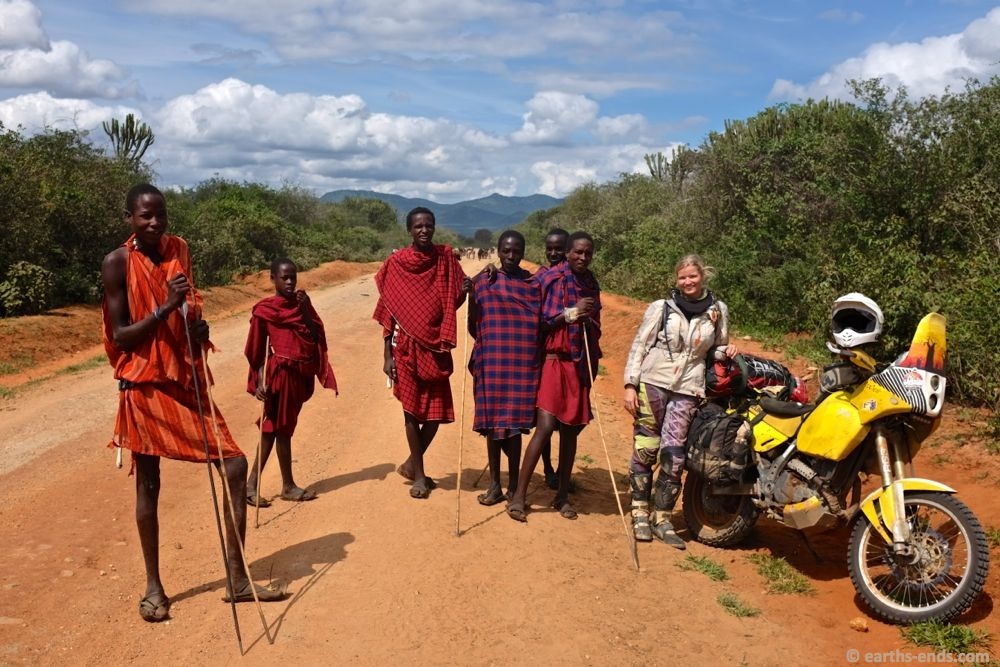
A fun little distraction

Young kid with a maasai spear poor kids was so curious yet so shy

This old boy wanted a lift and we were happy to oblige. We saved him a 5km walk and he was really happy…maybe not in this picture but when we dropped him off.

Baobab – a symbol of Africa and a reminder of home. Our Boab trees are close relatives of these. This is why I was so happy when the artist who painted my fairing went off-brief and gave me red sunset and boab/baobabs instead of a lake scene

The young boy with us demonstrated dunking the donut in tea and looked positively elated when we followed suit
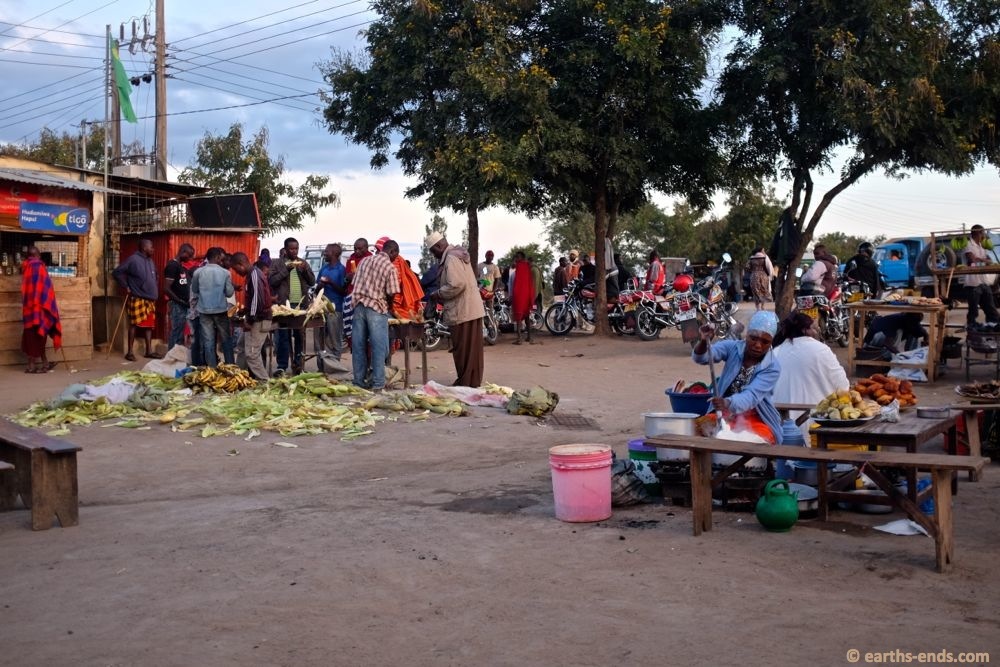
Like a Parisian café – Great for people watching
While we partook in the people watching and carb-loading we met a massive maassai guy named Kisiyoki who extended an invitation to visit his boma just outside of town. It’s always a delicate balance as a traveller – being open to experiences and meeting people from different walks of life and not being foolishly ignorant of personal risk. A cultural experience in exchange for all common sense, as it were. After all, there are two things we have learned about the peoples of world in all our years of travel 1) all of humanity finds farts funny and 2) schiesters and weirdos exist the world over and common sense is your best defense against them.
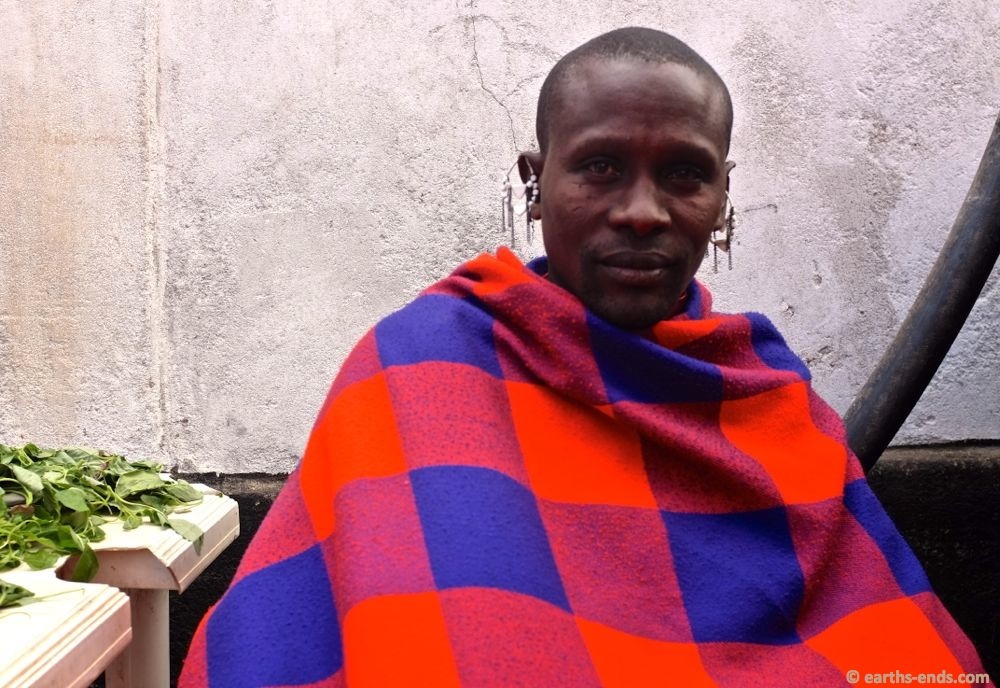
A visitor to our guesthouse – the maasai men and women have some elaborate earrings
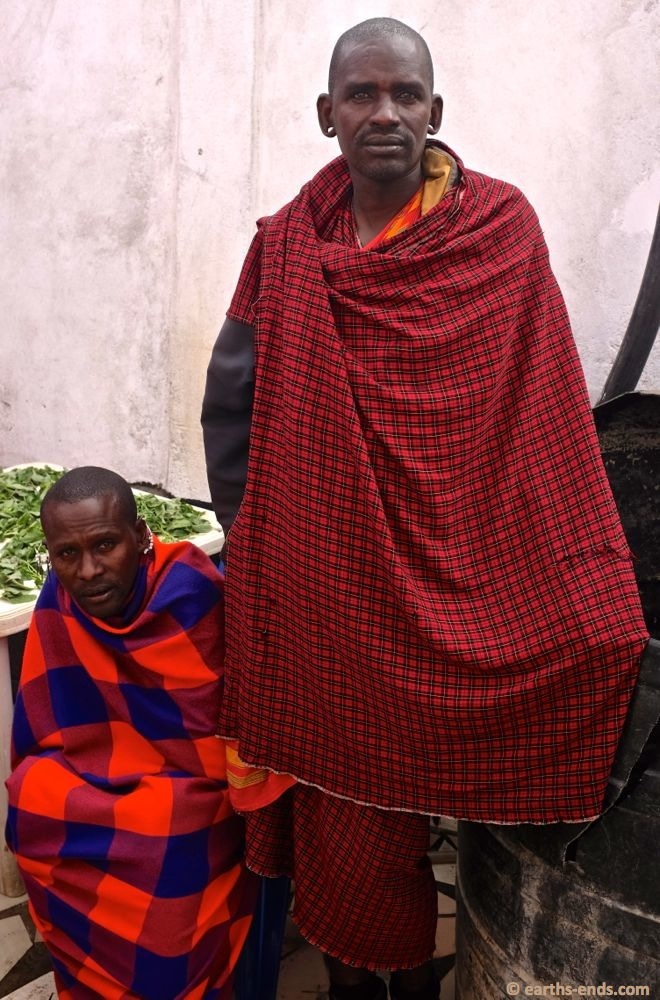
A photogenic bunch, aren’t they
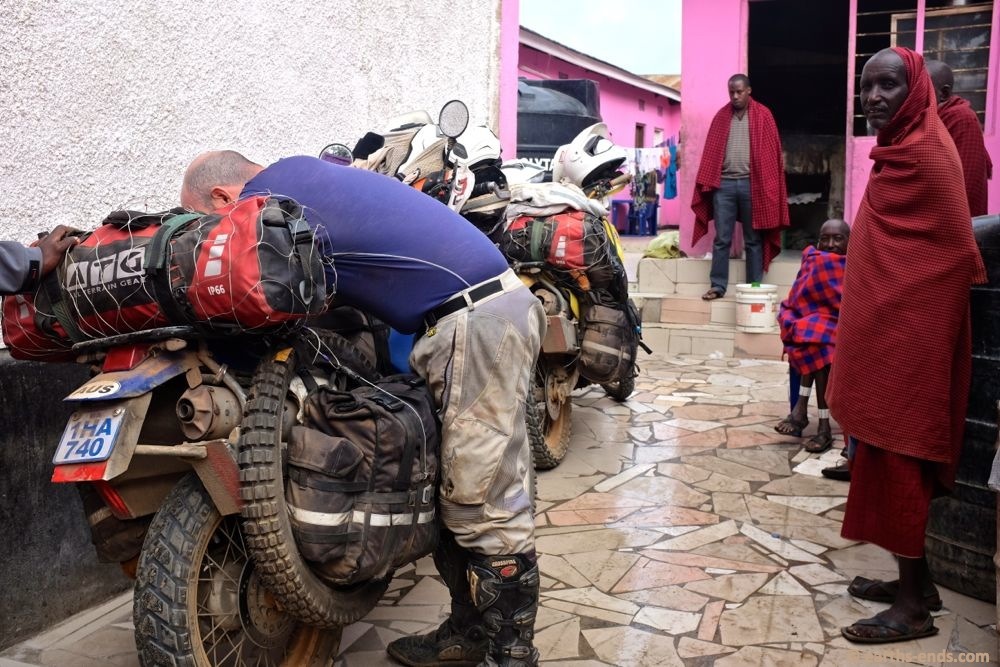
This group of old maasai gentleman showed up at our guesthouse the next day just to check us and the bikes out
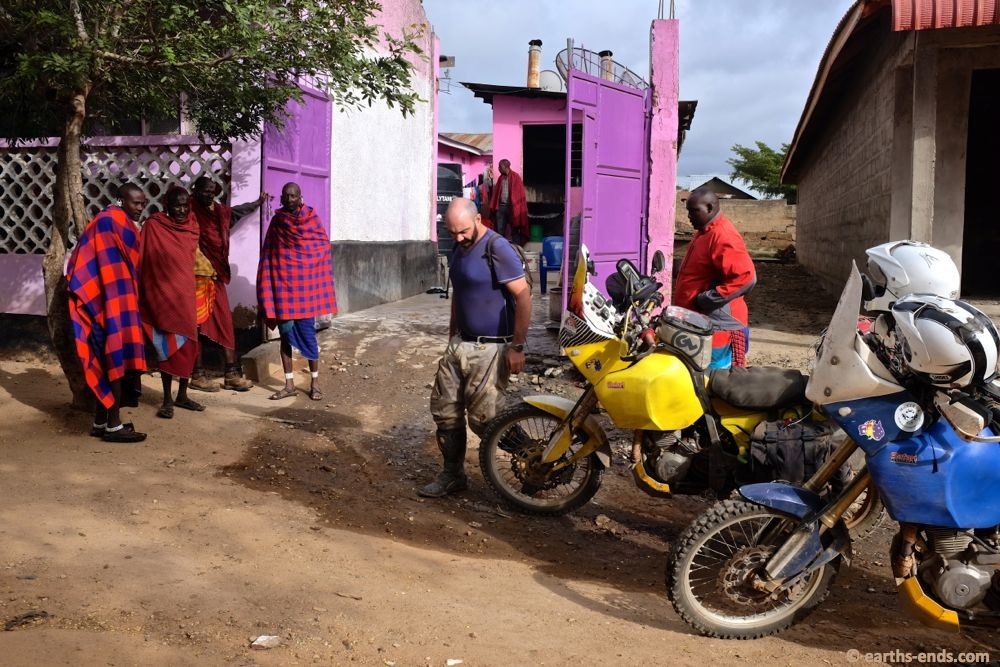
The hotel was really clean and the ladies there even boiled a bucket of water for us to bathe in and bought us a candle to use in the shower. Service! Cost about US$3.50
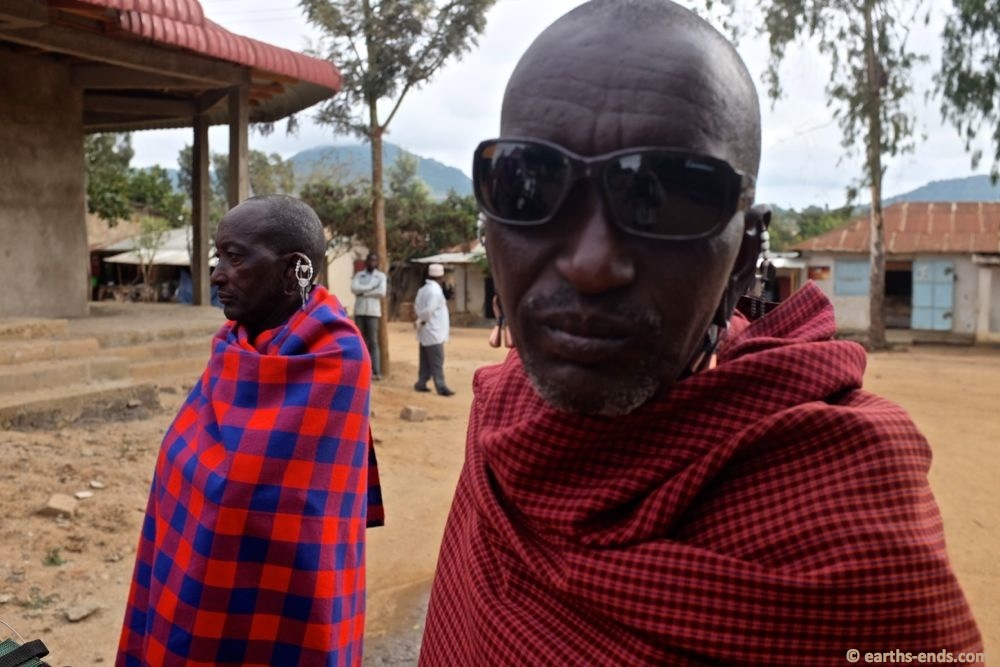
The old man on the right was a trip! This guy was pointing to things on the bikes and wanting to know the English word which he would then repeat and teach me the word in the maasai language. Thing is a lot of these guys speak a bunch of local languages so are very gifted in this area. This guy had an incredible ear and would parrot my Aussie accent so precisely it was stunning – mirror, tyre, water, forks was said full Aussie style ‘mirrah’ ‘tie-yarh’ ‘wahrdah’ ‘fourks’ It had me in stitches.
We were in a bit of a bind with this offer. Usually when we are meeting strangers on the road we are crossing path with them and any interactions just sort of happen organically. What this guy was proposing was a bit different in that, the following day, we were to follow him to some unknown location in the bush. If someone spoke to me for 10 minutes at a Dirty Bird restaurant back home then asked me to follow him out into the middle of nowhere I’d hardly jump at the chance…more like call the cops. But with Kisiyoki we got good vibes and our intuition has never let us down so we said ‘yeah man, we’ll come check our your cows.’

Kisiyoki’s little nephew was stunned by my lack of pigmentation and looked at me like I was a unicorn or something
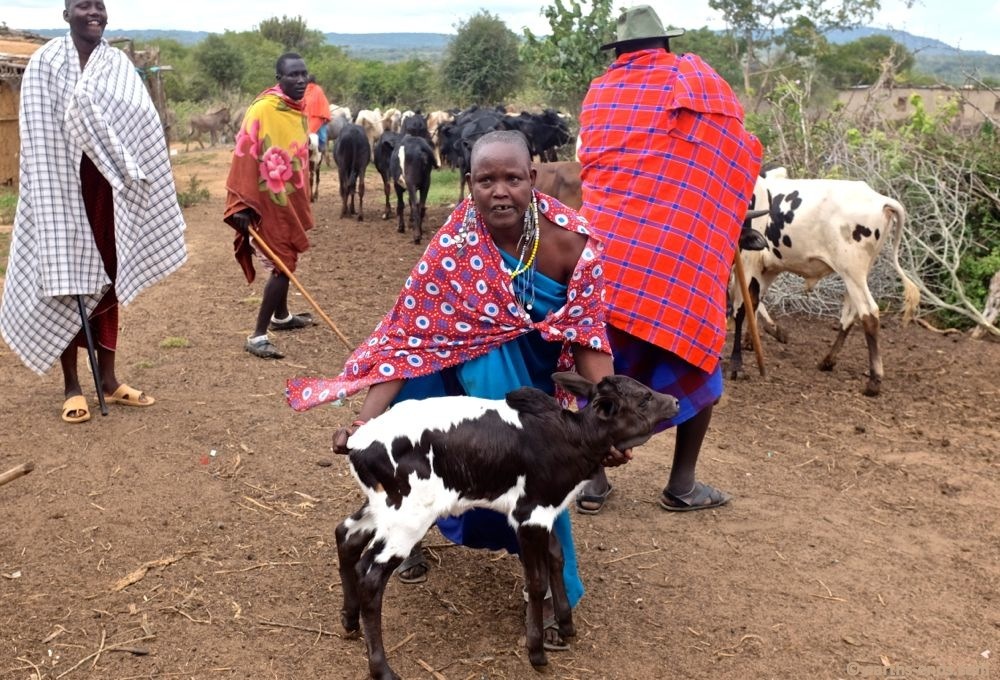
Kisiyoki’s brothers taking the cows out to graze. His mum was keen for us to take a photo of newest member of the herd
He picked us up from our guesthouse (a further encouraging sign he wasn’t setting us up for kidney harvesting) and we followed his little piki piki along winding cattle routes for a while until we reached his place. What followed was a nice couple of hours with him and his family. Kisiyoki was lucky to have land in such a favourable location with good grazing and year round access to water. He told us he had 560 goats and a lot of cows as well. We met his parents and some of his brothers and sisters and their children. One of their first questions to us was ‘Would you like tea with milk of cow or milk of goat?’
We opted for milk of cow and were treated to a massive hot cup of sweet milk of cow tea straight from the udder. It had a lovely earthy, smokey flavour to it which comes from the rather interesting and laborious process of sterilising their gourds to extend the time that milk can be stored before spoiling and to stop the flavor of the gourd itself infusing into the milk which is quite bitter. The innards of the gourds are taken out and water and ash soaked in for a few days. Next they clean it out with a special bristled palm frond and they then fill it with cow urine and let that cure for a few days. Then they get special preserving wood which they burn the ends into charcoal then rubs the burning charcoal into the inside of the gourd. Then they shake out the excess ash and that’s it. You’ll never look at your Tupperware the same way again, hey!
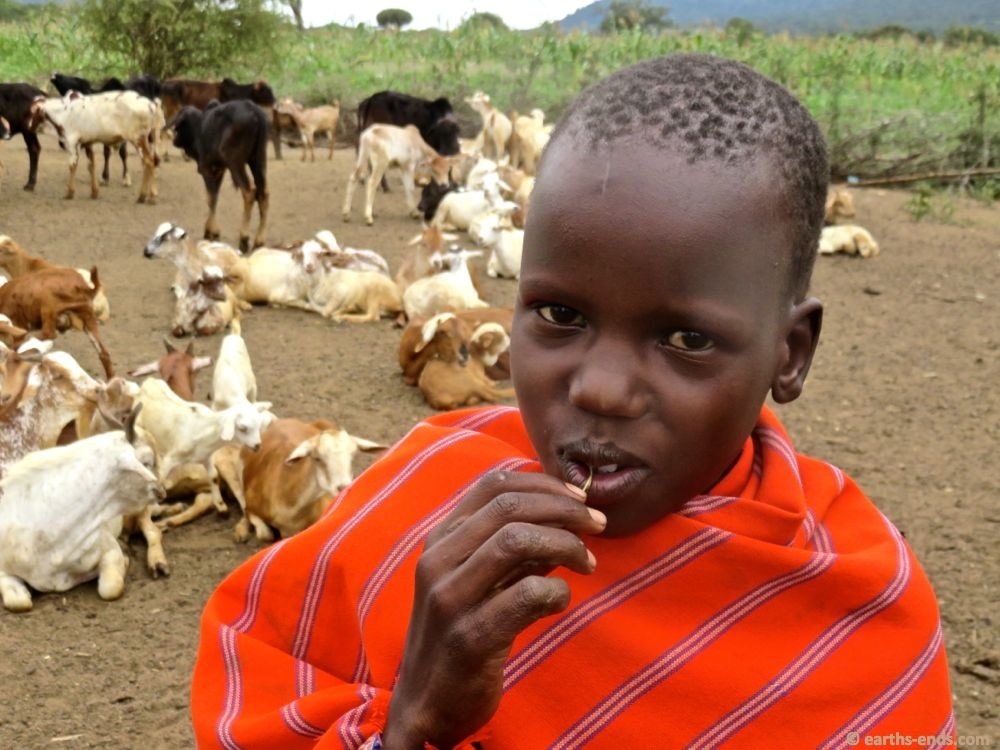
This nephew we taught how to take photos with our little point and shoot camera. He went berserk and took over a hundred photos of the goats while we were there. A happy lad.

They also kept chicken which were amused to hear that maasai men won’t eat chicken because according to Kisiyoki ‘the massai women don’t know how to cook it’. If they ever want chicken to eat they will travel into town and buy chicken there from the Swahili women who know what to do. The chickens here are owned by the women who collect and eat the eggs. Apparently maasai men don’t eat eggs. We got the impression from him that it’s some sort of womanly thing to eat eggs.
Kisiyoki is one of 12 children from his father’s first wife. We met the second wife but never found out how many children she had. We explained how in Australia that people aren’t allowed to have more than one wife. We said that if you want another wife ‘you have to first ask the old one to go away’. A number of the family could speak a bit of English but not perfectly so we ended up having to use simple English to answer the increasing complicated questions they were asking us.
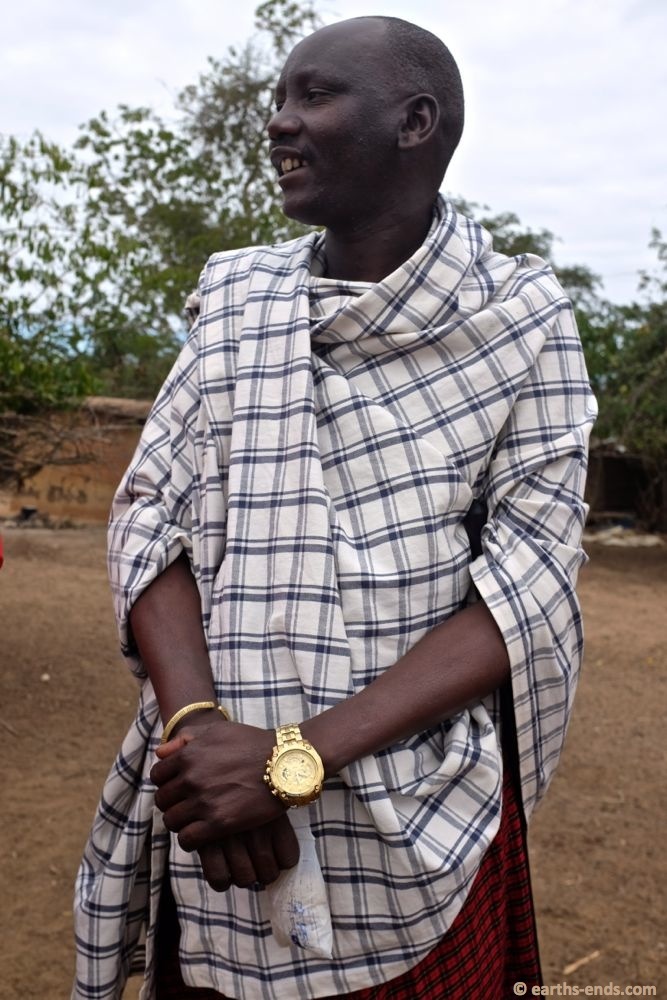
His brother with bling
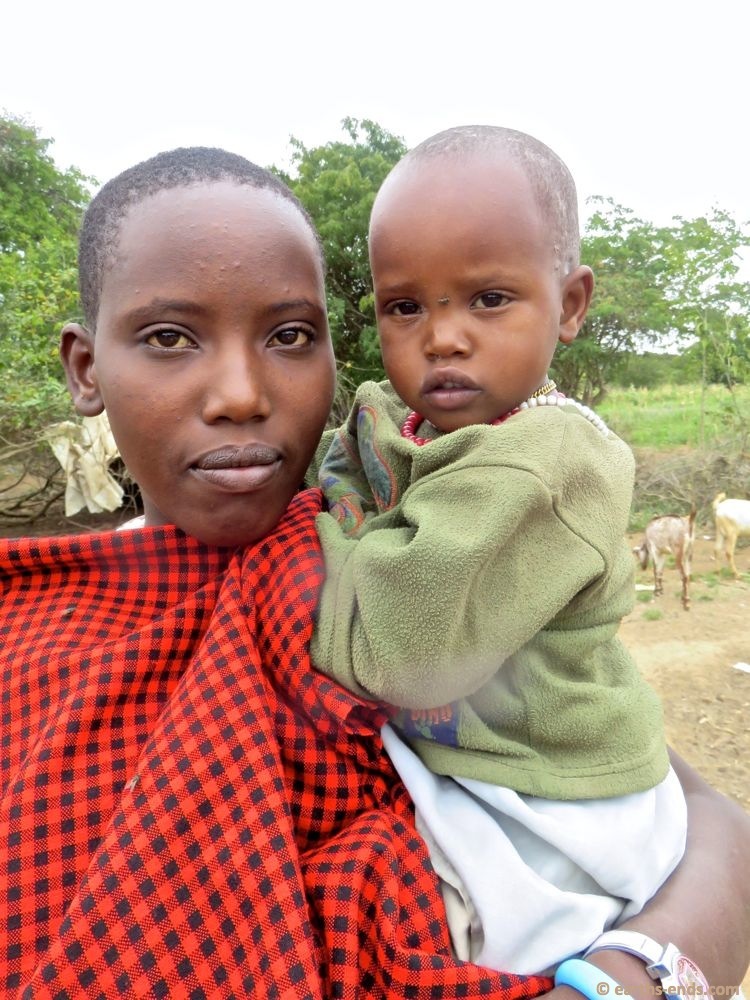
His sister-in-law with her daughter
They desperately wanted light shed on a number of pressing issues that we got the impression must be the subject of much discussion among the maasai of the area. The first question was asked with much emphasis and no small sense of urgency. ‘Why is it that older European woman come to Tanzania get young maasai man for boyfriend?’ It was something that we had heard about since entering Tanzania. If you believe the rumours, Tanzania (particularly Zanzibar) is randy white lady central. It appears we were too busy avoiding scams and feeding our faces in Zanzibar to notice that it was a hub of male prostitution/short time fling for money, dinners and gifts.
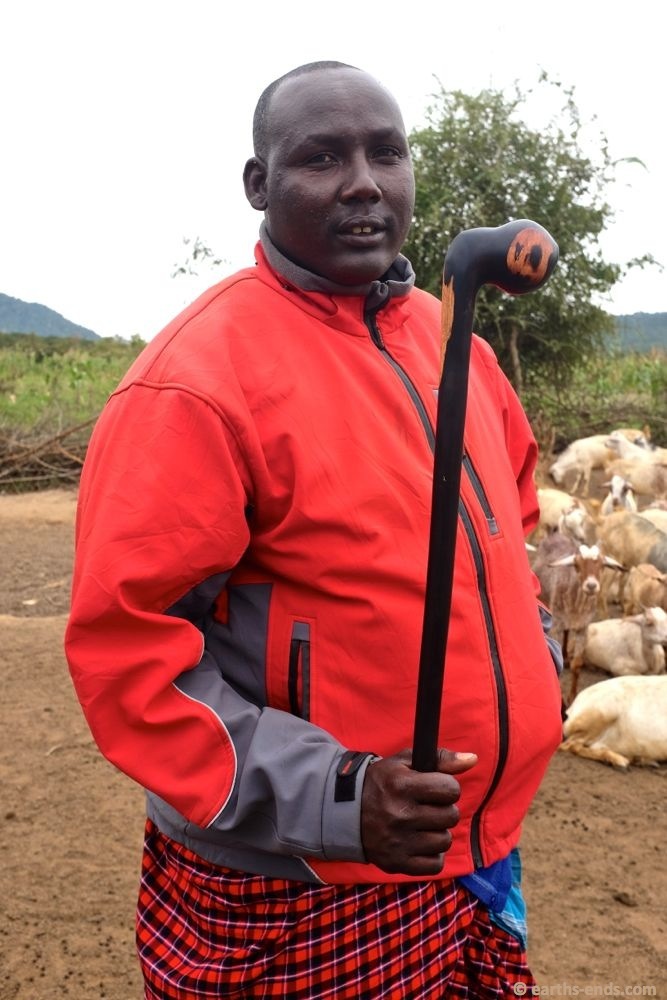
Kisiyoki with his traditional maasai ‘bobbyknocker’. He offered to swap this for Mick’s titanium Seiko Sportura wrist watch. Mick passed up on the offer.
As I looked at the unblinking, earnest, searching eyes of my audience I struggled to attack the question. I looked to Mick who wordlessly informed me I would be on my own in trying to explain the sexual proclivities of unknown ‘older European women’ to people who were dying to know. I think I said something along the lines of ‘I’m not too sure, ummm I think some ladies find the look of the maassai very different and attractive because it is so different from what they see at home…umm…’ Then Kisiyoki asked ‘but why always so young man?’ I didn’t know what to say so sipped my milk of cow tea and looked at Michael where I wordless informed him he had been no help at all.
Then Kisiyoki wanted to know ‘is it true that in your country there is no market for the larger woman?’ Again the family is looking on eagerly for my take on this. ‘I explained that ‘ummm..yes there is errrr… a market but I suppose the general idea of what is beautiful has changed over time and I suppose at the moment the very thin women are probably at the height of modern culture’s errr…expectations of beauty.’ It was a fumbling reply and I could tell they felt none the wiser for it. It was also clear they didn’t approve of this lack of a market for larger women and pulled a face like I do when I see someone cut the fat of a nice thick steak. “That’s the best part – you animal!’ it says.
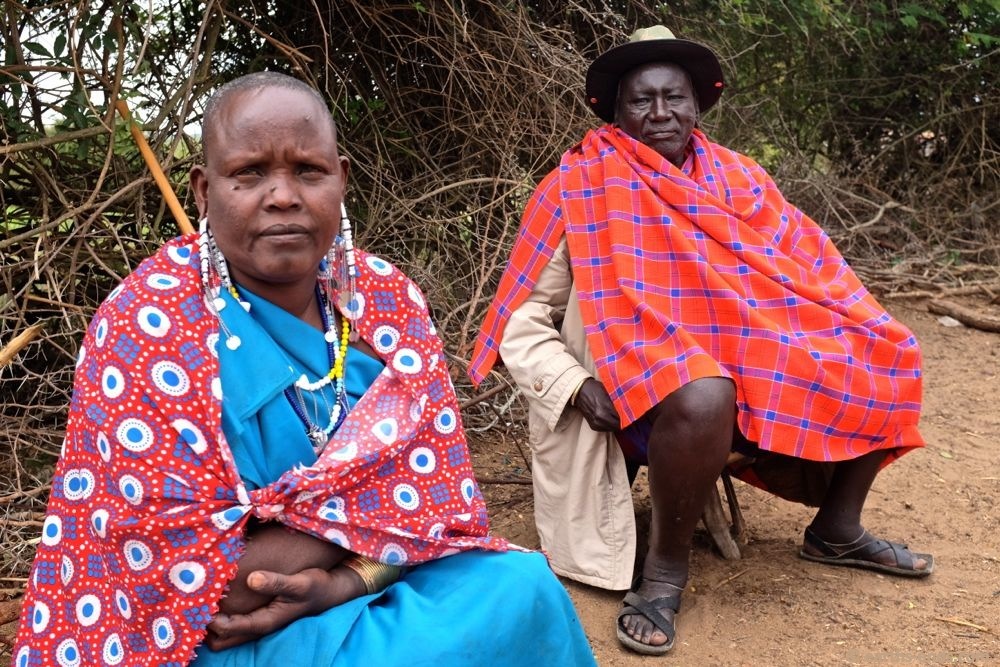
The parentals
After a time we said goodbye to Kisiyoki and his family who were exceedingly kind and wanted nothing more from us than the answers to some bizarre yet understandably intriguing questions. I can’t say I was able to sufficiently explain the randy European ladies or justify the lack of a market for large women but they seemed to enjoy our visit nonetheless. It was interesting for us, all the more so due to one of the last exchanges with had with our maasai mate. We asked him if he wanted to get married again after he told us he no longer had a wife. He said ‘yes, to a European woman.’ We were shocked as he had seemed a bit incredulous when he asked why European women seek out young maasai men. I had even asked at the time if he approved of these relationships and he said no. I quizzed him on this apparent contradiction, ‘why after all of this do you want a European wife?’ ‘Because with the Maasai women there is no love’ was his sad reply.

A lot of kids have sat on this bike

Kisiyoki making Mick look like a short-arse
It made sense I suppose. So much of life for the maasai seems to be work. As he explained to us there was a clear set of expectations and separation of duties. Like a lot of people groups we came across it seems the women got the shorter more labourous end of the stick. Women tend to the shelter, children, cooking, milking and water gathering and the guys ensure a safe place with water and grazing for animals and don’t do all that much else. The maasai are, in this regard, a lot like the lion that they fear and revere. Male lions have one role in the pride and that is to keep the group safe. Everything else is down to the lionesses even the hunting which the male lions are less adept and suited to given their excess size and girth. That size and girth is there for one reason and that is to protect the pride’s territory (their access to food and water) from outsiders.
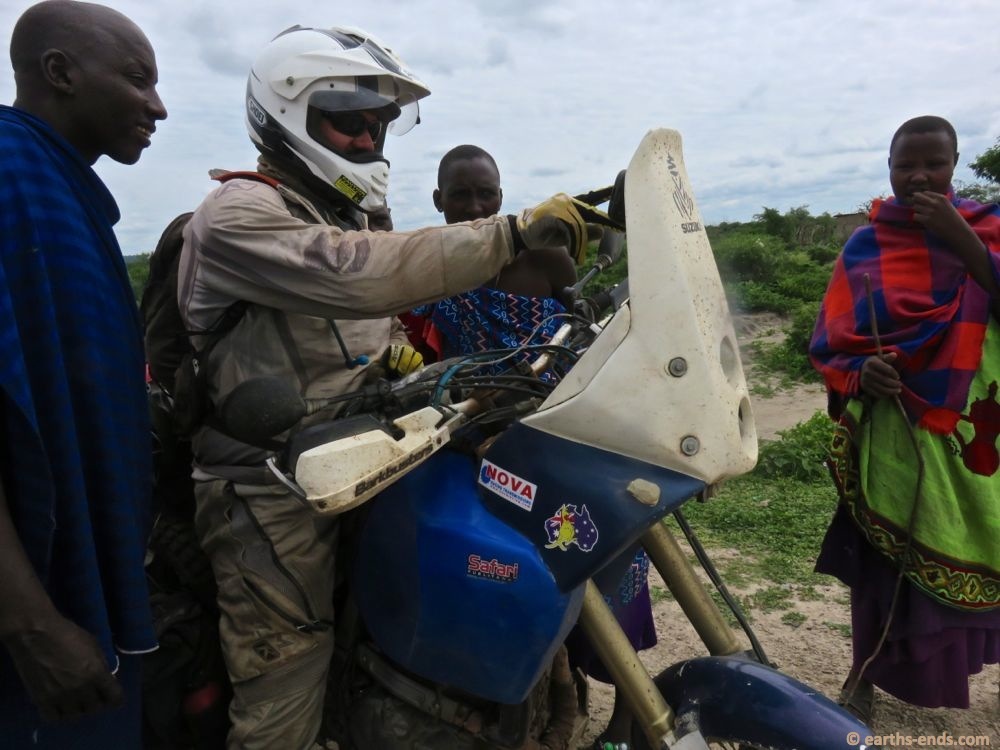
Friendly locals digging the GPS
We hit the road and found the intersection heading north towards Naberera, the next town of any consequence. On our version of Tracks4Africa however there were no tracks for any of this so Mick just followed his nose and I just followed Mick. It was wonderful riding, generally decent dirt road with the odd wash-out or rocky section. Rough enough to be interesting but not so rough as to be fatiguing. In short – a delight. We met heaps of friendly waving maasai along the way. They seemed to have the perfect balance between openness and cool confidence – quick to say hi but not wanting to bug us. A cool crowd.
Eventually we came across a more sizable village with a few cars and a bunch of shops. We had our usual lunch of chapattis, chip omelets, sweet milky tea and soon attracted a good portion of the village population. It was clear that tourists didn’t frequent these parts. While I was shopping (for candy) I found myself the centre of attention from a gathering of old ladies who wanted nothing more than to shake my hand and fuss over me. They were all dressed and adorned in typical Masaai fabrics and hundreds, nay thousands, of brightly coloured beads. I purchased a tube of fabric with a zip that you tie about your waist like the Maasai version of a bumbag/fanny pack. The gaggle of old ladies then fussed about fitting it to me and demonstrated all that I should be putting in it, insisting that they zip it open and closed for me. It was really lovely. I don’t know what it is about the old ducks but wherever we go they seem to take a shine to me.
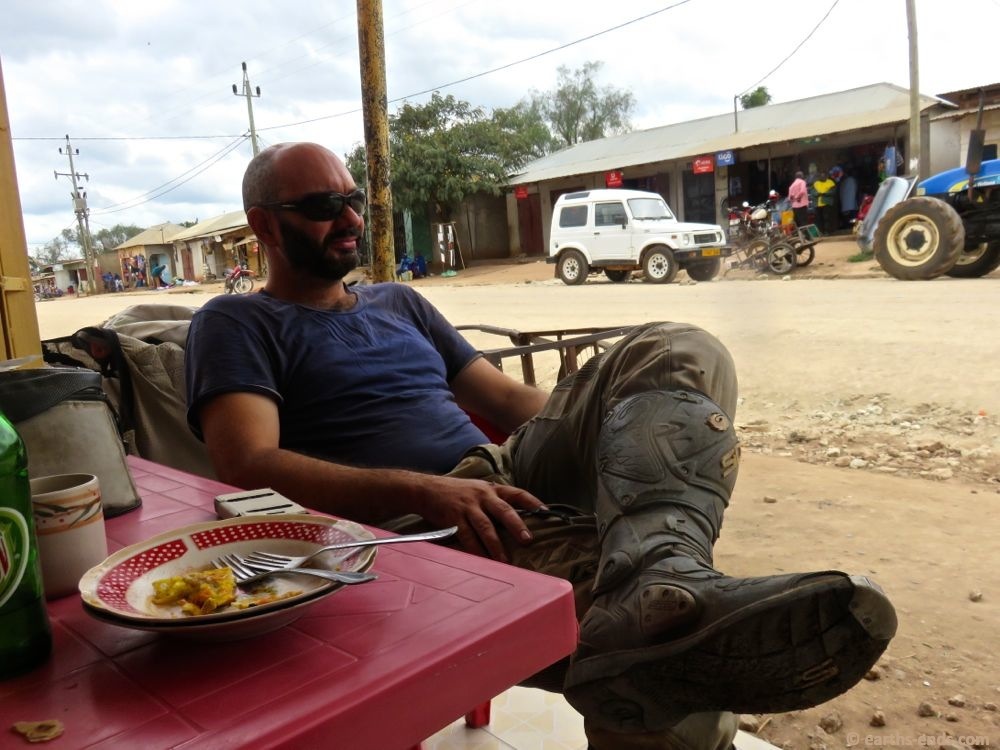
Lunch time – best time of the day!
We rode out of town and found a turn off for a town called Mererani, which Mick had seen on Google Earth. We expected that by following this road we would pass a tanzanite mine and find ourselves approaching Moshi from the Kilimanjaro airport. Once more, we got waved down by some guy wanting a lift. Figuring it would add to our road karma, Mick offered the guy a ride on the back of his bike. Like the other times we found ourselves doing this we figured he’d only be travelling a short way as he wasn’t carrying a thing. We rode a fair distance and the guy still pointed ahead so onwards we rode. Significant time and distance passed and we got to be a little worried and discussed our concerns over the intercom.
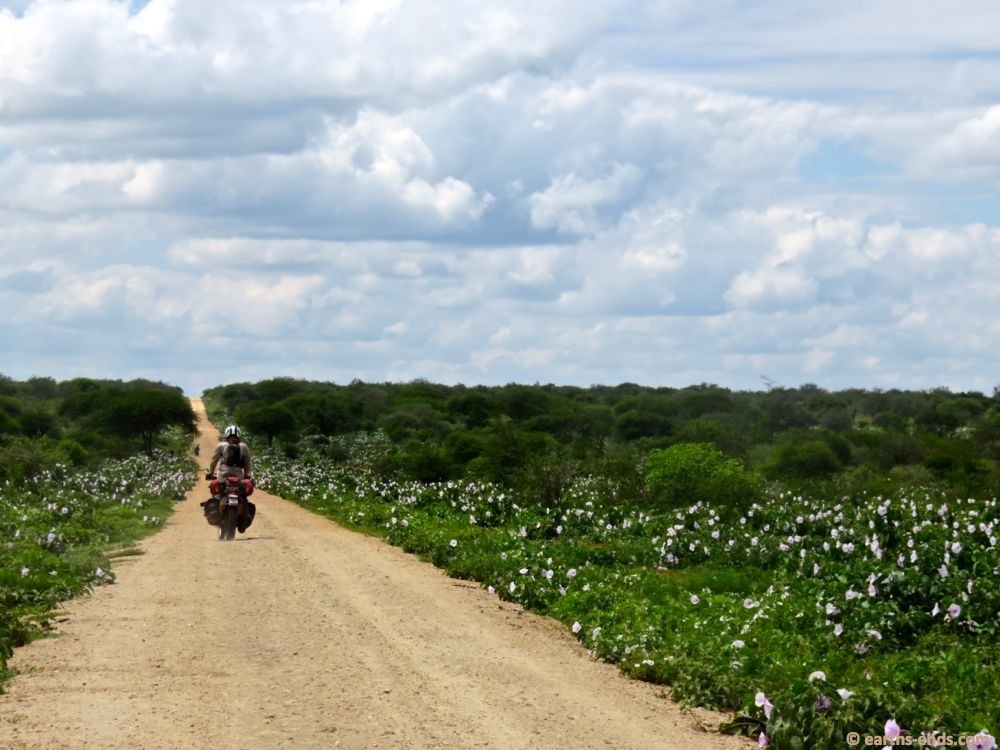
Fields of flowers lined the way
‘He knows he can get off, right?’ ‘Are you sure he wanted a ride not just took one because you stopped and told him to get on and he was too scared to refuse?’ ‘Perhaps he thinks we kidnapped him.’ ‘Where on Earth do you think he wants to go?’ ‘When I said I might want to adopt and African kid I was thinking closer to 1 than 20 years old.’ ‘Do you think he is just having too good a time to get off?’ ‘Can we keep him?’
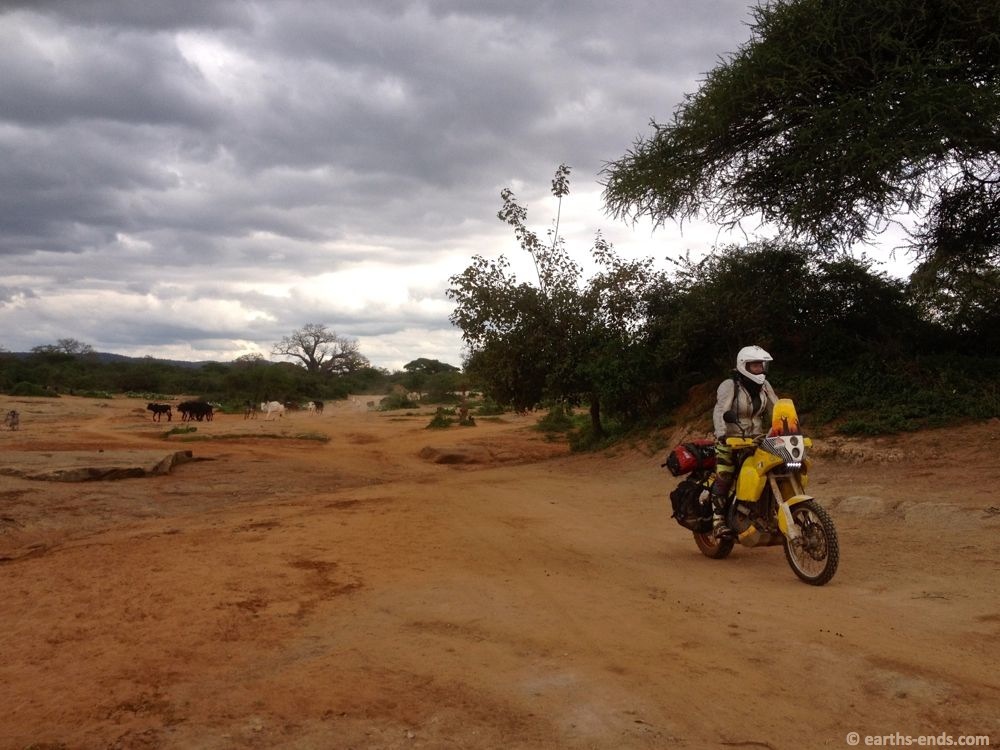
An unexpected detour but no complaints here
Soon we found the road to Mererani was blocked by some thorn bushes laid across the road. We didn’t know why but suspected for road works or rain damage. In Africa all roads seem to lead somewhere and often to the nearest town so we just turned right and pointed the bikes north-east rather than north, which was more the direction of Moshi anyway. The road became steadily less graded and more off-roady. Sand appeared then got more prevalent and softer. There were no signs of traffic and no wheels tracks to speak of. Before we knew it we were simply following what was probably a very old road but is now just a stock route through acacia bushes. It was decidedly off-road riding now, which we were quite accustomed to however in the past we have always done without a random African hitchhiker on the back. We stopped once more to see if old mate wanted to get off but he wanted to keep going, so we did.
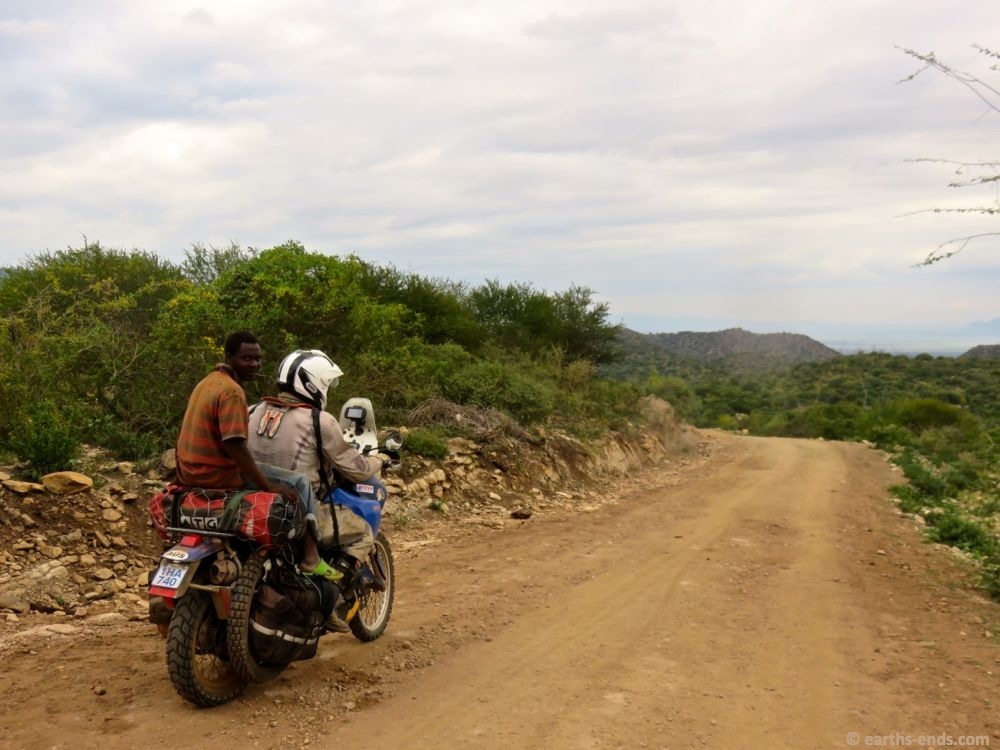
The third member of the Earth’s Ends team – he didn’t speak English and we never got his name.
Onwards we rode and arrived at the top of a little pass looking down over Nyumba ya Mungu dam. We descended on nice freshly graded dirt and then the track split into a maze of dusty/sandy eroded tracks all going the same direction. It wasn’t particularly tricky riding but a little sandy and tight and slow so 1st and 2nd gear the whole way. Fortunately our hitchhiker was barely moving yet he was seated on top of the top bag, which made for challenging riding in the sand. How Mick kept them both upright I don’t know. Eventually we reached a track lined by powerlines and soon after we hit tar. A good thing too because with ‘EasyRider’ on the back it was doing Mick’s rear suspension no favours.
We told the guy ‘we’re going to Moshi’. He just nodded and once again pointed forward. He reminded me of E.T. just sitting on the back of the bike instead of a basket on the front. We got to the main bus terminal in Moshi and pulled up and told the guy this is the end of the line as we feared he’d go as far as we did. By now he was covered head to toe in white dust. He seemed happy enough but didn’t say much, just gave us a thumbs up and kinda stood there. He’d travelled 95km with us, messed up the balance of the bike, flogged the suspension, buggered our fuel efficiency and barely said a word to us. But for a moment I thought we’d miss him. Thanks for sharing the adventure, buddy. Sorry if you didn’t want to travel 100 odd km to Moshi.
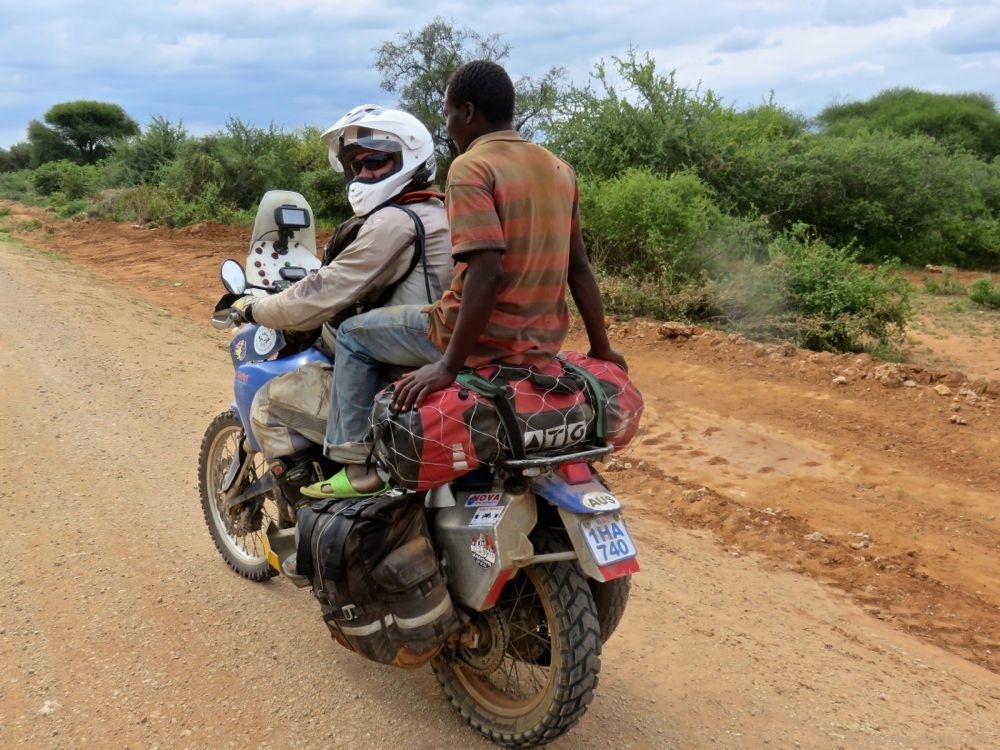
‘You wanna keep going? Umm I’ll take that as a yes’
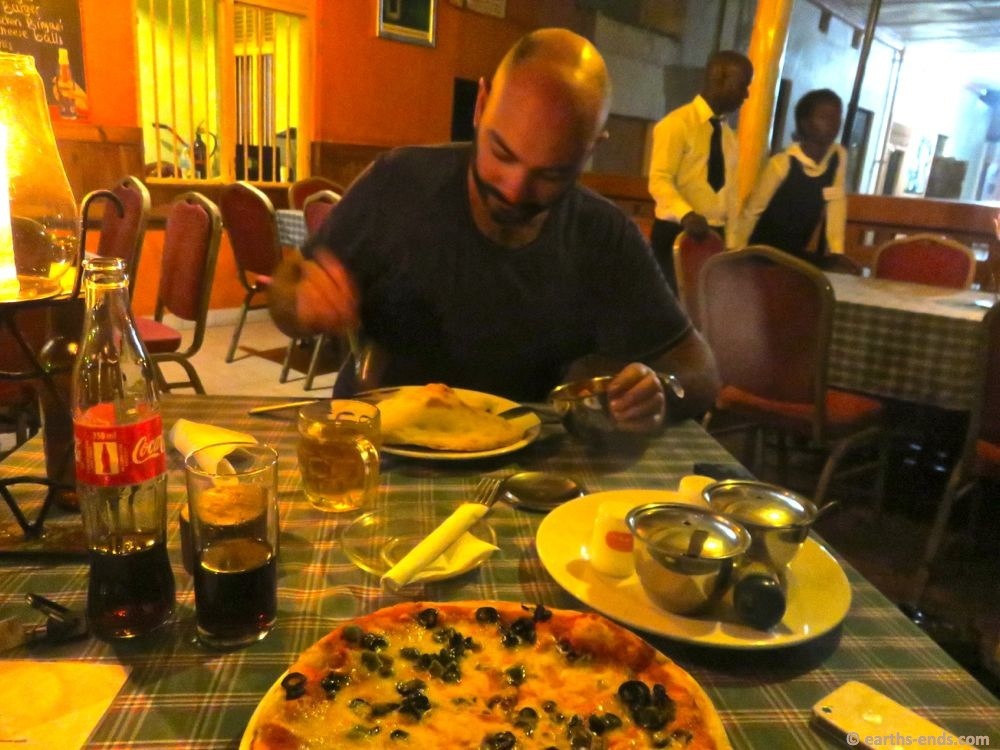
Enjoying the grub at the best (and possibly only) Italian-Indian restaurant in Africa
Free of our human cargo we went to track down a hotel for the night. After some false starts (silly expensive quotes) we managed to find something affordable. I had a major uni essay due in a couple days so needed somewhere comfortable and with WIFI so seedy local guesthouses were off the cards this time. We found a place called Hotel Hartebeest which was nice, near empty place with great wifi, nice staff, huge rooms and HOT SHOWER for US$30 which we thought was as good as we could hope for in such a tourist town. With the formalities sorted we went straight to the Indian-Italian restaurant we adored last time we were in town (a couple years ago we flew in and climbed Kilimanjaro) and put away a couple sensational pizzas while reflecting on the amazing experiences of the past few days. We were in agreement – This.Is.The.Life.
 Earths-Ends
Earths-Ends
Recent Comments